-
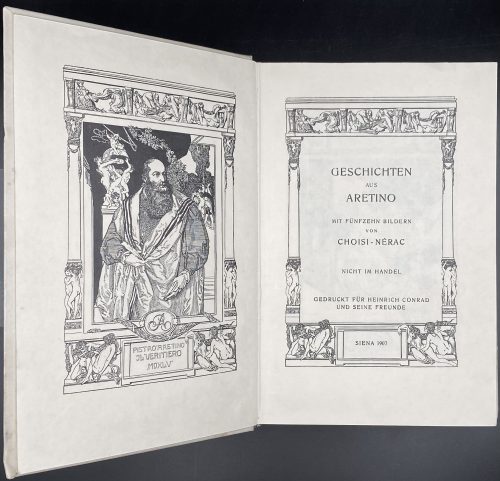 Title: GESCHICHTEN | AUS | ARETINO | MIT FÜNFZEHN BILDERN | VON | CHOISI-NÉRAC | NICHT IM HANDEL | GEDRUCKT FÜR HEINRICH CONRAD | UND SEINE FREUNDE | SIENA 1907 || Collation: 8vo; 1-128 137; frontispiece, t.p. and 14 plates, extraneous to collation. Pagination: [2] f.t. / blank, 3-203 [2], il. Binding: Full cream vellum, ruled with gilt double-fillet, grey label with gilt lettering to spine. Bookplate by von Bayros Par Avi Cigno to front pastedown. Note: Private edition of Aretino's Ragionamenti in German as Geschichten aus Aretino by translater and publisher Heinrich Conrad (German, 1866 – 1918), whose real name was Hugo Storm, this copy №394, illustrated by Franz von Bayros (Austrian, 1866 – of Choisi-Nérac.
Title: GESCHICHTEN | AUS | ARETINO | MIT FÜNFZEHN BILDERN | VON | CHOISI-NÉRAC | NICHT IM HANDEL | GEDRUCKT FÜR HEINRICH CONRAD | UND SEINE FREUNDE | SIENA 1907 || Collation: 8vo; 1-128 137; frontispiece, t.p. and 14 plates, extraneous to collation. Pagination: [2] f.t. / blank, 3-203 [2], il. Binding: Full cream vellum, ruled with gilt double-fillet, grey label with gilt lettering to spine. Bookplate by von Bayros Par Avi Cigno to front pastedown. Note: Private edition of Aretino's Ragionamenti in German as Geschichten aus Aretino by translater and publisher Heinrich Conrad (German, 1866 – 1918), whose real name was Hugo Storm, this copy №394, illustrated by Franz von Bayros (Austrian, 1866 – of Choisi-Nérac. -
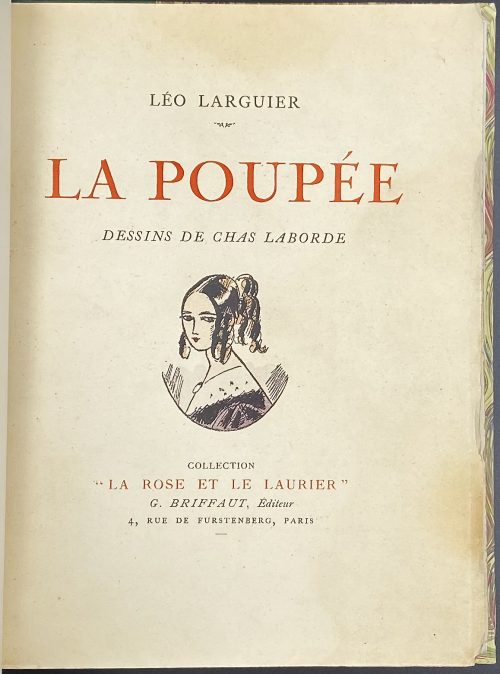 Description: owner’s quarter green morocco over marbled boards, 21.5 x 16.5 cm, collated 8vo, illustrated with numerous in-text and 5 full-page coloured etchings after drawings by Chas Laborde. Original publisher’s wrappers preserved, enriched with a set of 17 plates in black and white (bound in). Front wrapper (black and red): LÉO LARGUIER | LA POUPÉE | DESSINS DE CHAS LABORDE | {vignette} | COLLECTION | “LA ROSE ET LE LAURIER” | G. BRIFFAUT, Éditeur | 4, RUE DE FURSTENBERG, PARIS || Title-page: LÉO LARGUIER | — | LA POUPÉE | DESSINS DE | CHAS LABORDE | {vignette} | COLLECTION DE | “LA ROSE ET LE LAURIER” | G. BRIFFAUT, Éditeur | 4, RUE DE FURSTENBERG, PARIS (VIe) | M CM XXV || Collation: Three binder’s blanks, 1 front wrapper, 1 blank, 1 h.t./limit., 1 t.p., 1 epigraph, 1-68 74 (last blank), plates within collation, 1 back wrapper, three binder’s blanks, plus 17 leaves of b/w plates. Pagination: not counting wrappers, [6] (h.t., t.p., epigraph) 1-99 [100] [4], ils. Limitation: A print run of 770 copies on April 25, 1925, by Coulouma (Argenteuil) under the direction of H. Barthélemy , of which 10 copies on Japon Impérial (№ 1-10) + one drawing + one b/w suite, 10 copies on Japon Impérial (№ 11-20) + one drawing, 750 copies on Vélin (№ 21-770). This is copy № 1 (on Japon Impérial with b/w suite of plates but without the drawing). Contributors: Léo Larguier (French, 1878 – 1950) – author. Chas Laborde [Charles Laborde] (French, 1886 – 1941) – artist. Georges Briffaut (French, 1886 – 1973) – publisher.
Description: owner’s quarter green morocco over marbled boards, 21.5 x 16.5 cm, collated 8vo, illustrated with numerous in-text and 5 full-page coloured etchings after drawings by Chas Laborde. Original publisher’s wrappers preserved, enriched with a set of 17 plates in black and white (bound in). Front wrapper (black and red): LÉO LARGUIER | LA POUPÉE | DESSINS DE CHAS LABORDE | {vignette} | COLLECTION | “LA ROSE ET LE LAURIER” | G. BRIFFAUT, Éditeur | 4, RUE DE FURSTENBERG, PARIS || Title-page: LÉO LARGUIER | — | LA POUPÉE | DESSINS DE | CHAS LABORDE | {vignette} | COLLECTION DE | “LA ROSE ET LE LAURIER” | G. BRIFFAUT, Éditeur | 4, RUE DE FURSTENBERG, PARIS (VIe) | M CM XXV || Collation: Three binder’s blanks, 1 front wrapper, 1 blank, 1 h.t./limit., 1 t.p., 1 epigraph, 1-68 74 (last blank), plates within collation, 1 back wrapper, three binder’s blanks, plus 17 leaves of b/w plates. Pagination: not counting wrappers, [6] (h.t., t.p., epigraph) 1-99 [100] [4], ils. Limitation: A print run of 770 copies on April 25, 1925, by Coulouma (Argenteuil) under the direction of H. Barthélemy , of which 10 copies on Japon Impérial (№ 1-10) + one drawing + one b/w suite, 10 copies on Japon Impérial (№ 11-20) + one drawing, 750 copies on Vélin (№ 21-770). This is copy № 1 (on Japon Impérial with b/w suite of plates but without the drawing). Contributors: Léo Larguier (French, 1878 – 1950) – author. Chas Laborde [Charles Laborde] (French, 1886 – 1941) – artist. Georges Briffaut (French, 1886 – 1973) – publisher. -
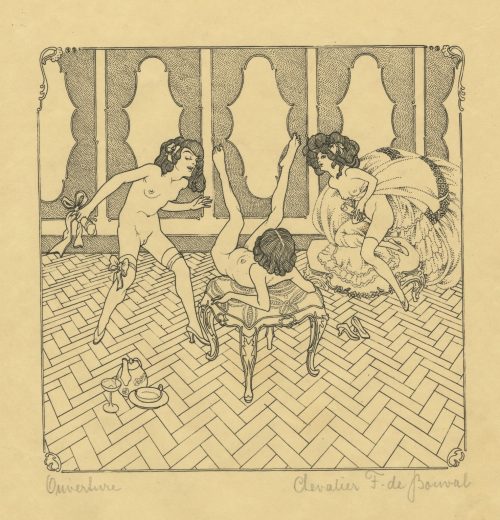 A set of sixteen planographic prints, signed and titled in pencil by owner “Chevalier F. de Bouval” (pseudonym of Franz von Bayros (Austrian, 1866 – 1924). Titles include: 1) Ouverture, 2) champagne brut, 3) maternité, 4) piano, 5) crudité délicieuse, 6. la belle vue, 7) au pensionnat, 8) le collier, 9) languelles pénètrelles, 10) introduction, 11) le sourrogat, 12) variation amoureuse, 13) la surprise, 14) le clef délicat, 15) le monstre gomme, 16) fruits de sud. Printed on wove paper, possibly engraved on wood after ink drawings by Franz von Bayros (Austrian, 1866 – 1924) under the pseudonym Chevalier F. de Bouval. Size: sheet 30 x 24 cm, image 18 x 17.5 cm. In another source, there are two more images from the same set: le passe-partout and la doublette, making 18 images altogether; the set is titled “Lesbia: XVIII sujets”, signed by Chevalier François René de Bouval.
A set of sixteen planographic prints, signed and titled in pencil by owner “Chevalier F. de Bouval” (pseudonym of Franz von Bayros (Austrian, 1866 – 1924). Titles include: 1) Ouverture, 2) champagne brut, 3) maternité, 4) piano, 5) crudité délicieuse, 6. la belle vue, 7) au pensionnat, 8) le collier, 9) languelles pénètrelles, 10) introduction, 11) le sourrogat, 12) variation amoureuse, 13) la surprise, 14) le clef délicat, 15) le monstre gomme, 16) fruits de sud. Printed on wove paper, possibly engraved on wood after ink drawings by Franz von Bayros (Austrian, 1866 – 1924) under the pseudonym Chevalier F. de Bouval. Size: sheet 30 x 24 cm, image 18 x 17.5 cm. In another source, there are two more images from the same set: le passe-partout and la doublette, making 18 images altogether; the set is titled “Lesbia: XVIII sujets”, signed by Chevalier François René de Bouval. -
 Magazine article by Edgar Jepson: The Iron Tsuba of Japan (Section: Oriental Art), published in volume Vol. 70 (September–December) of The Connoisseur: An Illustrated Magazine for Collectors, Vol. 70 (September–December); pp. 143-152 / C. Reginald Grundy [ed.] — London: Published by the Proprietor, W. CLAUSE JOHNSON, at the Editorial and Advertisement Offices of The Connoisseur, 1924. Owner's half black morocco, gilt lettering to spine, blue cloth boards. Two volumes bound together without original covers. Size 28.5 x 22 cm. Vol. 1: The Connoisseur | An Illustrated Magazine | For Collectors | Edited by C. Reginald Grundy | Vol. LXIX. | (MAY—AUGUST, 1924) | LONDON | Published by the Proprietor, W. CLAUSE JOHNSON, at the | Editorial and Advertisement Offices of The Connoisseur, | at 1, Duke Street, St. James's, S.W. 1 | 1924 || Pp.: [i-ii] iii-xviii [xix] [1, 2 - plate] 3-249 [250]. Vol. 2: The Connoisseur | An Illustrated Magazine | For Collectors | Edited by C. Reginald Grundy | Vol. LXX. | (SEPTEMBER—DECEMBER, 1924) | LONDON | Published by the Proprietor, W. CLAUSE JOHNSON, at the | Editorial and Advertisement Offices of The Connoisseur, | at 1, Duke Street, St. James's, S.W. 1 | 1924 || Pp.: [i-ii] iii-xxii [2 blanks] [1, 2 - plate] 3-261 [262]. The Iron Tsuba of Japan by Edgar Jepson The heart of Japan was in the sword. However admirable may be the paintings, the prints, the netsuke, the lacquer, or the bronzes of the Japanese masters, the supreme artistic achievements of Japan were the blades of Masamune, Muramasa, Sadamune, and Rai Kunitsugu. But not a little of the heart of Japan went also in the tsuba, the guard which protected the hand that wielded the blade, into the iron tsuba of the fighting Samurai. Beside the forgers of the iron tsuba of Japan the ironsmiths of the rest of the world have been mere children. The earliest tsuba were of bronze or copper, often gilded. It is probable that they were replaced by iron tsuba during the Kamakura period, the great fighting era, which lasted from A.D. 1185 to 1333. During the later half of the twelfth century leather tsuba, strengthened by thin iron plates or a metal rim, also replaced the bronze and copper tsuba. It was at this time that a family of armourers of the name of Masuda, and in particular Masuda Munesuke, the founder of the Myochin family, began to forge iron tsuba — thin, round plates of great hardness and density. But it is probable that no tsuba perforated with a view to decorative effects were forged before the end of the fourteenth century. These fourteenth-century tsuba are exceedingly rare in England. I have seen none in the museums, none in the famous collections that have been sold during the last ten years. Those photographed in Herr Oeder's book might easily be the fifteenth century. No. 1 is a curious cup-shape tsuba decorated with a bronze and copper inlay. No. 2, with its edges curiously twisted in the forging, looks like Myochin work. But it is not of the Myochin iron. The Myochin family produced some of the greatest ironsmiths of Japan. Armourers first of all, tsubasmiths, forgers of sake-kettles, articulated reptiles, crustacea, and insects — everything that can be done with iron they did; they pushed their medium to its limit. They were forging iron tsuba in 1160, and they were still forging them in 1860. And it was their own iron, or rather their own steel. They discovered the secret of it early, and they kept that secret in the family for all those hundreds of years. There is no mistaking a Myochin tsuba: balance it on your finger and tap it with a piece of metal, always it gives forth a clear bell-like ring that you get from the work of no other ironsmith, Japanese or European. Always the Myochin tsuba is before everything a protection to the hand of the swordsman; to that everything is, as it should be, subordinated. No. 3 is a Myochin tsuba of the fifteenth century, and probably of the early fifteenth century. No. 4, by Myochin Munetaka, perforated with a grotesque figure, is an example of that twisting and twisting of the iron in the forging till it forms a pattern like the grain of wood. The Myochin smiths invented these wood-grain tsuba, and no other smiths equalled them in their forging. In the sixteenth century, the fighting tsuba was probably at its best. It was a century of great tsubasmiths. Then the first Nobuiye, whose tsuba fetched £100 apiece, circa 1800, in Japan, and the first Kaneiye flourished. No. 5 is a tsuba forged by a great smith, Iyesada of Sotome, in the manner of Nobuiye I, decorated with the karakusa tendrils that Nobuiye delighted in, with lightning and clouds. No. 6 is a guard of Sanada Tembo, the chief smith of the Tembo family, stamped, punning fashion, with the character Tembo. Akin to the Tembo tsuba were those of the Kiami and Hoan smiths. Then also the Heianjo smiths and the Owari smiths, especially those of Nagoya and the Yamakichi family, forged their strongest tsuba. Those of the Yamakichi were tested after the forging by being pounded in iron mortars — at least, so the legend runs. But they were a sternly utilitarian family, and I have never seen a Yamakichi tsuba of any beauty. In the later half of the fifteenth century arose the fashion of decorating tsuba with an inlay, zogan, of bronze. The Heianjo tsuba, forged at Kyoto in the latter half of the fifteenth and the beginning of the sixteenth century, were often thus inlaid. The earliest of them were called "Onin", of which No. 7 is an example. In addition to the bronze inlay around the edge, it is inlaid with a representation, some say, of snow; others say, of the duckweed on a pond. No. 8 is probably a Heianjo tsuba, but I am not quite sure about it. The inlaid acacia branches might be very early Shoami work. But to judge by the iron, it is a fifteenth-century tsuba; and the authorities place the beginning of the Shoami school not later than early in the sixteenth century. No. 10 is an example of the Fushimi-zogan, a flat inlay of a light-coloured bronze. These tsuba took their name from the fact that they were first forged at Fushimi, in Yamashiro, in the sixteenth century. It is of the type known as Mon-zukashi, perforated with crests (mon) à jour. The Yoshiro-zogan tsuba were also first forged at Fushimi by Yoshiro Naomasa. They were distinguished from the Fushimi-zogan by the fact that their inlay was generally a little raised-not always-for the inlay of No. 9, a tsuba forged by a later nineteenth-century Yoshiro, is quite flat. It is an interesting tsuba, for, with its decoration grown florid and excessive, it marks the intermediate stage between the simple and delightful designs of the genuine fighting tsuba and the elaborate pictures in gold and silver on the tsuba of the eighteenth-century smiths of Awa and Kyoto, which have become mere ornaments of the goldsmith. The Gomoku-zogan (No. 11) tsuba were probably first forged earlier than the Fushimi and Yoshiro-zogan tsuba. This inlay, in slight relief, is a representation in a light-coloured bronze and copper of twigs caught in the eddies of streams. The seventeenth century and early eighteenth century were the great periods of perforated tsuba. The designs, and they are often admirable, are for the most part in plain fretwork; but they are also chased. No. 12, a crane under an acacia, is a tsuba of a Higo smith, great forgers of fighting tsuba during this period. These smiths also excelled in nunome zogan, a very thin gold and silver inlay, with which they further decorated their perforated guards. The smiths of the Umetada and Shoami families also forged iron tsuba during this period; but their designs, though sometimes pleasing enough, are rarely fine. The best work of Myoju Umetada is in sentoku, not iron. The Choshu smiths, coming later, surpass the perforated guards of both the Umetada and Shoami smiths in beauty of design. No. 13, a lotus in the round, not only fretwork, but also engraved, is a good example of the admirable balance they so often attained in their designs. It is a sufficiently realistic lotus, but yet of a delightful simplicity. In considerable contrast is No. 14, the dragon by Soheishi Soten — one of the only two authentic tsuba of his forging known — the first forger of hikone-bori tsuba, which were in extraordinary favour in Japan during the eighteenth century, and illustrated every important event in Japanese history. It is on the elaborate side, but fine, strong work, and an excellent guard to the hand, for the lighter and more open part, which gives the design its admirable balance, is on the inside, and not exposed to the full swing of an opponent's blade. A few years ago there was a tendency to decry the Namban tsuba as having sprung too directly from foreign sources. But though the original suggestion may have been Chinese, or, as some say, Portuguese, the Japanese made it entirely their own, as characteristically Japanese as anything can well be, but, it must be admitted, of a decadent period. The school took its rise at the beginning of the seventeenth century, and the early tsuba were forged of a specially hard iron, the Wootz, imported from Southern India. No. 15, the signs of the Zodiac, is an excellent tsuba from the fighting point of view. Both it and No. 16 are of quite charming, if elaborate, design, and both of them, with their delicate scroll-work, so astonishingly undercut, are the very last word in the work of the ironsmith-veritable iron lace. To return to the simpler perforated tsuba, the smiths of Akasaka, a suburb of Tokyo, produced probably the most charming designs. Their style derives considerably from the Higo smiths, and their earlier fighting tsuba are very like the Higo tsuba. But always their work was just a little lighter than that of the Higo smiths, and in the end they moved right away from them and became the forgers of very light guards indeed. No. 17, is a representation of the Hiyokudori, the fabulous double bird, in which were reincarnated the souls of the two lovers, Gompachi and Komurasaki; and No. 18, “the tsuba of a hundred ducks "— there are about forty — are characteristic designs of the school. In the work of the Akasaka smiths the balance, which makes the design of a good tsuba so admirable and delightful, attains its height. This admirable balance seems often to be obtained by a deliberate sacrifice of symmetry. About nine hundred and ninety-nine European ironsmiths out of a thousand would have made the right and left sides of the Hiyoku-dori line by line, and perforation by perforation, exactly alike; he would have cut out exactly as many ducks on the one side of “the tsuba of a hundred ducks” as on the other, and made each duck on the right side correspond exactly in position and attitude with a duck on the left side. By variations the tsubasmith attained a finer balance, almost a higher symmetry. No. 19, often called by collectors the "rose-window" tsuba, but really a stylised chrysanthemum, is a favourite design of the Akasaka smiths, but Hizen work and inlaid in the Hizen manner with gold nunome. No. 20 is a Satsuma tsuba of the middle period. The Satsuma smiths of the nineteenth century produced probably the most ornate of all the iron guards, for the most part calibashes and beans with their leaves and tendrils realistic in the extreme, but of charming design. Few crafts have been carried further than that of the tsubasmith; few crafts working in a difficult medium have handled more subjects with greater feeling for beauty or greater liveliness of fancy. It is interesting to note again and again how school influences school, and smith influences smith. But, as in all the applied arts, the finest tsuba were forged by men who never lost sight of the purpose of a tsuba, that it is before everything a protection to the hand, and never subjected that purpose to a passion for virtuosity. Illustrations: No 1. FOURTEENTH-CENTURY TSUBA, WITH BRONZE AND COPPER INLAY No. 2. FOURTEENTH-CENTURY TSUBA, RESEMBLING MYOCHIN WORK No. 3. MYOCHIN TSUBA, FIFTEENTH CENTURY No. 4. MYOCHIN TSUBA, NINETEENTH CENTURY No. 5. SIXTEENTH-CENTURY TSUBA No. 6. SIXTEENTH-CENTURY TSUBA BY IYESADA OF SOTOME BY SANADA TEMBO No. 7. ONIN TSUBA No. 8. HEIANJO (?) TSUBA No. 9. YOSHIRO TSUBA, NINETEENTH CENTURY No. 10. FUSHIMI-ZOGAN, NINETEENTH CENTURY No. 11.- GOMOKU-ZOGAN, SIXTEENTH CENTURY No. 12. HIGO TSUBA, SEVENTEENTH CENTURY No. 13. CHOSHU TSUBA, SEVENTEENTH CENTURY No. 14. SOTEN TSUBA, SEVENTEENTH CENTURY No. 15. NAMBAN TSUBA, EIGHTEENTH CENTURY No. 16. NAMBAN TSUBA, NINETEENTH CENTURY Nos. 17. AND 18. AKASAKA TSUBA, EIGHTEENTH CENTURY No. 19. HIZEN TSUBA, EIGHTEENTH CENTURY No. 20. SATSUMA TSUBA, EIGHTEENTH CENTURY
Magazine article by Edgar Jepson: The Iron Tsuba of Japan (Section: Oriental Art), published in volume Vol. 70 (September–December) of The Connoisseur: An Illustrated Magazine for Collectors, Vol. 70 (September–December); pp. 143-152 / C. Reginald Grundy [ed.] — London: Published by the Proprietor, W. CLAUSE JOHNSON, at the Editorial and Advertisement Offices of The Connoisseur, 1924. Owner's half black morocco, gilt lettering to spine, blue cloth boards. Two volumes bound together without original covers. Size 28.5 x 22 cm. Vol. 1: The Connoisseur | An Illustrated Magazine | For Collectors | Edited by C. Reginald Grundy | Vol. LXIX. | (MAY—AUGUST, 1924) | LONDON | Published by the Proprietor, W. CLAUSE JOHNSON, at the | Editorial and Advertisement Offices of The Connoisseur, | at 1, Duke Street, St. James's, S.W. 1 | 1924 || Pp.: [i-ii] iii-xviii [xix] [1, 2 - plate] 3-249 [250]. Vol. 2: The Connoisseur | An Illustrated Magazine | For Collectors | Edited by C. Reginald Grundy | Vol. LXX. | (SEPTEMBER—DECEMBER, 1924) | LONDON | Published by the Proprietor, W. CLAUSE JOHNSON, at the | Editorial and Advertisement Offices of The Connoisseur, | at 1, Duke Street, St. James's, S.W. 1 | 1924 || Pp.: [i-ii] iii-xxii [2 blanks] [1, 2 - plate] 3-261 [262]. The Iron Tsuba of Japan by Edgar Jepson The heart of Japan was in the sword. However admirable may be the paintings, the prints, the netsuke, the lacquer, or the bronzes of the Japanese masters, the supreme artistic achievements of Japan were the blades of Masamune, Muramasa, Sadamune, and Rai Kunitsugu. But not a little of the heart of Japan went also in the tsuba, the guard which protected the hand that wielded the blade, into the iron tsuba of the fighting Samurai. Beside the forgers of the iron tsuba of Japan the ironsmiths of the rest of the world have been mere children. The earliest tsuba were of bronze or copper, often gilded. It is probable that they were replaced by iron tsuba during the Kamakura period, the great fighting era, which lasted from A.D. 1185 to 1333. During the later half of the twelfth century leather tsuba, strengthened by thin iron plates or a metal rim, also replaced the bronze and copper tsuba. It was at this time that a family of armourers of the name of Masuda, and in particular Masuda Munesuke, the founder of the Myochin family, began to forge iron tsuba — thin, round plates of great hardness and density. But it is probable that no tsuba perforated with a view to decorative effects were forged before the end of the fourteenth century. These fourteenth-century tsuba are exceedingly rare in England. I have seen none in the museums, none in the famous collections that have been sold during the last ten years. Those photographed in Herr Oeder's book might easily be the fifteenth century. No. 1 is a curious cup-shape tsuba decorated with a bronze and copper inlay. No. 2, with its edges curiously twisted in the forging, looks like Myochin work. But it is not of the Myochin iron. The Myochin family produced some of the greatest ironsmiths of Japan. Armourers first of all, tsubasmiths, forgers of sake-kettles, articulated reptiles, crustacea, and insects — everything that can be done with iron they did; they pushed their medium to its limit. They were forging iron tsuba in 1160, and they were still forging them in 1860. And it was their own iron, or rather their own steel. They discovered the secret of it early, and they kept that secret in the family for all those hundreds of years. There is no mistaking a Myochin tsuba: balance it on your finger and tap it with a piece of metal, always it gives forth a clear bell-like ring that you get from the work of no other ironsmith, Japanese or European. Always the Myochin tsuba is before everything a protection to the hand of the swordsman; to that everything is, as it should be, subordinated. No. 3 is a Myochin tsuba of the fifteenth century, and probably of the early fifteenth century. No. 4, by Myochin Munetaka, perforated with a grotesque figure, is an example of that twisting and twisting of the iron in the forging till it forms a pattern like the grain of wood. The Myochin smiths invented these wood-grain tsuba, and no other smiths equalled them in their forging. In the sixteenth century, the fighting tsuba was probably at its best. It was a century of great tsubasmiths. Then the first Nobuiye, whose tsuba fetched £100 apiece, circa 1800, in Japan, and the first Kaneiye flourished. No. 5 is a tsuba forged by a great smith, Iyesada of Sotome, in the manner of Nobuiye I, decorated with the karakusa tendrils that Nobuiye delighted in, with lightning and clouds. No. 6 is a guard of Sanada Tembo, the chief smith of the Tembo family, stamped, punning fashion, with the character Tembo. Akin to the Tembo tsuba were those of the Kiami and Hoan smiths. Then also the Heianjo smiths and the Owari smiths, especially those of Nagoya and the Yamakichi family, forged their strongest tsuba. Those of the Yamakichi were tested after the forging by being pounded in iron mortars — at least, so the legend runs. But they were a sternly utilitarian family, and I have never seen a Yamakichi tsuba of any beauty. In the later half of the fifteenth century arose the fashion of decorating tsuba with an inlay, zogan, of bronze. The Heianjo tsuba, forged at Kyoto in the latter half of the fifteenth and the beginning of the sixteenth century, were often thus inlaid. The earliest of them were called "Onin", of which No. 7 is an example. In addition to the bronze inlay around the edge, it is inlaid with a representation, some say, of snow; others say, of the duckweed on a pond. No. 8 is probably a Heianjo tsuba, but I am not quite sure about it. The inlaid acacia branches might be very early Shoami work. But to judge by the iron, it is a fifteenth-century tsuba; and the authorities place the beginning of the Shoami school not later than early in the sixteenth century. No. 10 is an example of the Fushimi-zogan, a flat inlay of a light-coloured bronze. These tsuba took their name from the fact that they were first forged at Fushimi, in Yamashiro, in the sixteenth century. It is of the type known as Mon-zukashi, perforated with crests (mon) à jour. The Yoshiro-zogan tsuba were also first forged at Fushimi by Yoshiro Naomasa. They were distinguished from the Fushimi-zogan by the fact that their inlay was generally a little raised-not always-for the inlay of No. 9, a tsuba forged by a later nineteenth-century Yoshiro, is quite flat. It is an interesting tsuba, for, with its decoration grown florid and excessive, it marks the intermediate stage between the simple and delightful designs of the genuine fighting tsuba and the elaborate pictures in gold and silver on the tsuba of the eighteenth-century smiths of Awa and Kyoto, which have become mere ornaments of the goldsmith. The Gomoku-zogan (No. 11) tsuba were probably first forged earlier than the Fushimi and Yoshiro-zogan tsuba. This inlay, in slight relief, is a representation in a light-coloured bronze and copper of twigs caught in the eddies of streams. The seventeenth century and early eighteenth century were the great periods of perforated tsuba. The designs, and they are often admirable, are for the most part in plain fretwork; but they are also chased. No. 12, a crane under an acacia, is a tsuba of a Higo smith, great forgers of fighting tsuba during this period. These smiths also excelled in nunome zogan, a very thin gold and silver inlay, with which they further decorated their perforated guards. The smiths of the Umetada and Shoami families also forged iron tsuba during this period; but their designs, though sometimes pleasing enough, are rarely fine. The best work of Myoju Umetada is in sentoku, not iron. The Choshu smiths, coming later, surpass the perforated guards of both the Umetada and Shoami smiths in beauty of design. No. 13, a lotus in the round, not only fretwork, but also engraved, is a good example of the admirable balance they so often attained in their designs. It is a sufficiently realistic lotus, but yet of a delightful simplicity. In considerable contrast is No. 14, the dragon by Soheishi Soten — one of the only two authentic tsuba of his forging known — the first forger of hikone-bori tsuba, which were in extraordinary favour in Japan during the eighteenth century, and illustrated every important event in Japanese history. It is on the elaborate side, but fine, strong work, and an excellent guard to the hand, for the lighter and more open part, which gives the design its admirable balance, is on the inside, and not exposed to the full swing of an opponent's blade. A few years ago there was a tendency to decry the Namban tsuba as having sprung too directly from foreign sources. But though the original suggestion may have been Chinese, or, as some say, Portuguese, the Japanese made it entirely their own, as characteristically Japanese as anything can well be, but, it must be admitted, of a decadent period. The school took its rise at the beginning of the seventeenth century, and the early tsuba were forged of a specially hard iron, the Wootz, imported from Southern India. No. 15, the signs of the Zodiac, is an excellent tsuba from the fighting point of view. Both it and No. 16 are of quite charming, if elaborate, design, and both of them, with their delicate scroll-work, so astonishingly undercut, are the very last word in the work of the ironsmith-veritable iron lace. To return to the simpler perforated tsuba, the smiths of Akasaka, a suburb of Tokyo, produced probably the most charming designs. Their style derives considerably from the Higo smiths, and their earlier fighting tsuba are very like the Higo tsuba. But always their work was just a little lighter than that of the Higo smiths, and in the end they moved right away from them and became the forgers of very light guards indeed. No. 17, is a representation of the Hiyokudori, the fabulous double bird, in which were reincarnated the souls of the two lovers, Gompachi and Komurasaki; and No. 18, “the tsuba of a hundred ducks "— there are about forty — are characteristic designs of the school. In the work of the Akasaka smiths the balance, which makes the design of a good tsuba so admirable and delightful, attains its height. This admirable balance seems often to be obtained by a deliberate sacrifice of symmetry. About nine hundred and ninety-nine European ironsmiths out of a thousand would have made the right and left sides of the Hiyoku-dori line by line, and perforation by perforation, exactly alike; he would have cut out exactly as many ducks on the one side of “the tsuba of a hundred ducks” as on the other, and made each duck on the right side correspond exactly in position and attitude with a duck on the left side. By variations the tsubasmith attained a finer balance, almost a higher symmetry. No. 19, often called by collectors the "rose-window" tsuba, but really a stylised chrysanthemum, is a favourite design of the Akasaka smiths, but Hizen work and inlaid in the Hizen manner with gold nunome. No. 20 is a Satsuma tsuba of the middle period. The Satsuma smiths of the nineteenth century produced probably the most ornate of all the iron guards, for the most part calibashes and beans with their leaves and tendrils realistic in the extreme, but of charming design. Few crafts have been carried further than that of the tsubasmith; few crafts working in a difficult medium have handled more subjects with greater feeling for beauty or greater liveliness of fancy. It is interesting to note again and again how school influences school, and smith influences smith. But, as in all the applied arts, the finest tsuba were forged by men who never lost sight of the purpose of a tsuba, that it is before everything a protection to the hand, and never subjected that purpose to a passion for virtuosity. Illustrations: No 1. FOURTEENTH-CENTURY TSUBA, WITH BRONZE AND COPPER INLAY No. 2. FOURTEENTH-CENTURY TSUBA, RESEMBLING MYOCHIN WORK No. 3. MYOCHIN TSUBA, FIFTEENTH CENTURY No. 4. MYOCHIN TSUBA, NINETEENTH CENTURY No. 5. SIXTEENTH-CENTURY TSUBA No. 6. SIXTEENTH-CENTURY TSUBA BY IYESADA OF SOTOME BY SANADA TEMBO No. 7. ONIN TSUBA No. 8. HEIANJO (?) TSUBA No. 9. YOSHIRO TSUBA, NINETEENTH CENTURY No. 10. FUSHIMI-ZOGAN, NINETEENTH CENTURY No. 11.- GOMOKU-ZOGAN, SIXTEENTH CENTURY No. 12. HIGO TSUBA, SEVENTEENTH CENTURY No. 13. CHOSHU TSUBA, SEVENTEENTH CENTURY No. 14. SOTEN TSUBA, SEVENTEENTH CENTURY No. 15. NAMBAN TSUBA, EIGHTEENTH CENTURY No. 16. NAMBAN TSUBA, NINETEENTH CENTURY Nos. 17. AND 18. AKASAKA TSUBA, EIGHTEENTH CENTURY No. 19. HIZEN TSUBA, EIGHTEENTH CENTURY No. 20. SATSUMA TSUBA, EIGHTEENTH CENTURY -
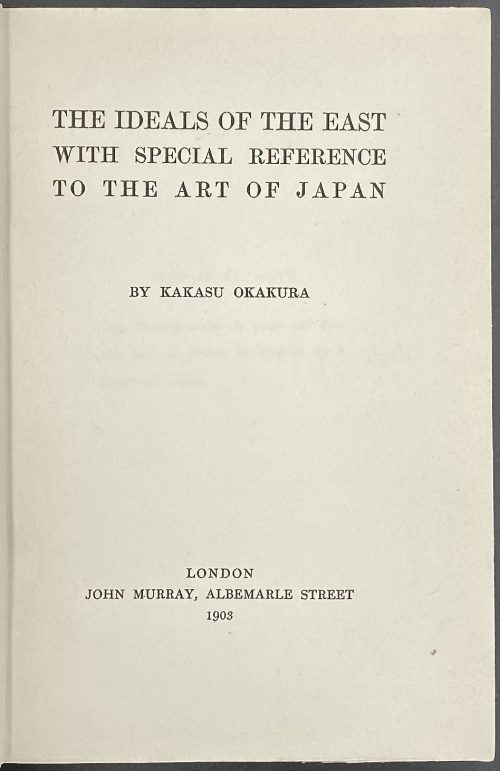 Title: THE IDEALS OF THE EAST | WITH SPECIAL REFERENCE | TO THE ART OF JAPAN | BY KAKASU OKAKURA | LONDON | JOHN MURRAY, ALBEMARLE STREET | 1903 || Collation: 8vo; ffl, [2] (t.p., prep. note) [a]4 b4, A-P8 Q4. Pagination: ffl, [I, ii] – h.t. / blank, [iii, iv] – t.p. / blank, [v, vi] – preparatory note / blank, vii-xxii, [1] 2-244, [1] 2-4 (Works for art lovers). Binding: Burgundy cloth, red flowers and lettering to cover, gilt lettering to spine. Size: 19.5 x 13 cm Contributors: Author: Okakura Kakuzō [岡倉 覚三] (1863 – 1913). Publisher: Murray, Sir John IV (1851–1928); John Murray (publishing house). Printer: Ballantyne, Hanson & Co., Edinburgh, London.
Title: THE IDEALS OF THE EAST | WITH SPECIAL REFERENCE | TO THE ART OF JAPAN | BY KAKASU OKAKURA | LONDON | JOHN MURRAY, ALBEMARLE STREET | 1903 || Collation: 8vo; ffl, [2] (t.p., prep. note) [a]4 b4, A-P8 Q4. Pagination: ffl, [I, ii] – h.t. / blank, [iii, iv] – t.p. / blank, [v, vi] – preparatory note / blank, vii-xxii, [1] 2-244, [1] 2-4 (Works for art lovers). Binding: Burgundy cloth, red flowers and lettering to cover, gilt lettering to spine. Size: 19.5 x 13 cm Contributors: Author: Okakura Kakuzō [岡倉 覚三] (1863 – 1913). Publisher: Murray, Sir John IV (1851–1928); John Murray (publishing house). Printer: Ballantyne, Hanson & Co., Edinburgh, London. -
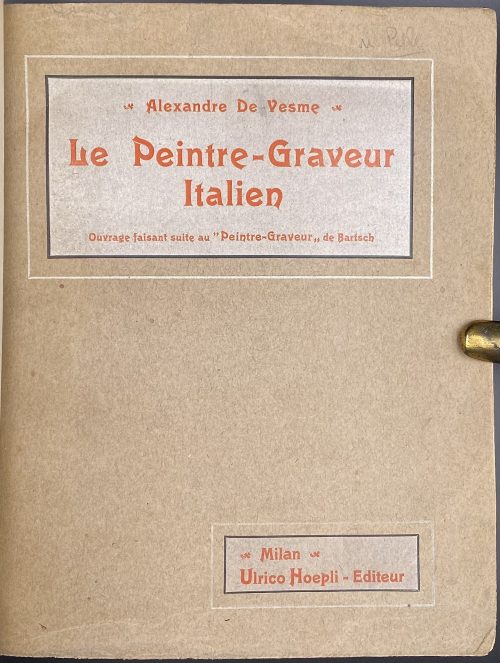 Description: 4to, 26 x 21 cm, hardcover ¾ brown percaline over marbled boards, gilt lettering to spine, marbled endpapers, publisher’s original wrappers preserved (bound-in), engraved bookplate “EX LIBRIS | Rodolfo …“ to verso of the 1st blank leaf. Printed in 1905 by Imprimerie Humbert Allegretti (Milan). Collation: 4to; front wrapper, π3 (blank, h.t., t.p.), 1-684, back wrapper; total 275 leaves within the wrappers. Pagination: [6] [1] 2-542 [2], total 550 pages. Contributors: Alessandro Baudi di Vesme [Alexandre de Vesme] (Italian, 1854 – 1923) Adam Bartsch (Austrian, 1757 – 1821) Ulrico Hoepli [Johannes Ulrich Höpli] (Swiss-Italian, 1846 – 1935) U. Hoepli (Milan)
Description: 4to, 26 x 21 cm, hardcover ¾ brown percaline over marbled boards, gilt lettering to spine, marbled endpapers, publisher’s original wrappers preserved (bound-in), engraved bookplate “EX LIBRIS | Rodolfo …“ to verso of the 1st blank leaf. Printed in 1905 by Imprimerie Humbert Allegretti (Milan). Collation: 4to; front wrapper, π3 (blank, h.t., t.p.), 1-684, back wrapper; total 275 leaves within the wrappers. Pagination: [6] [1] 2-542 [2], total 550 pages. Contributors: Alessandro Baudi di Vesme [Alexandre de Vesme] (Italian, 1854 – 1923) Adam Bartsch (Austrian, 1757 – 1821) Ulrico Hoepli [Johannes Ulrich Höpli] (Swiss-Italian, 1846 – 1935) U. Hoepli (Milan) -
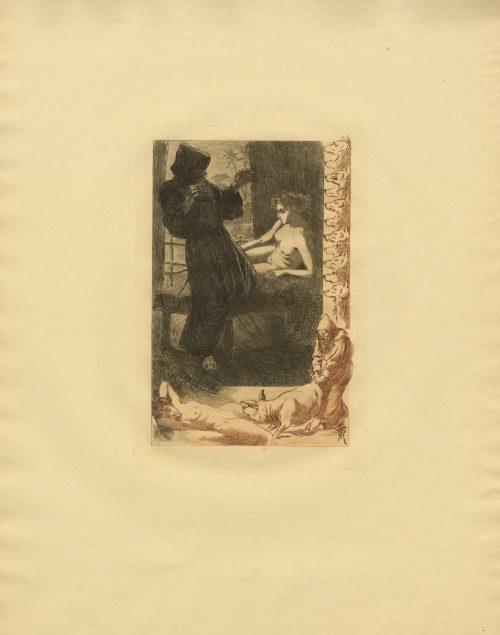 Set of 21 etchings by Martin van Maele for the English edition of ‘Thais’ by Anatole France published in London by Charles Carrington in 1901. Printed on vowe paper without a watermark in two colours with the black image and sepia historiated border. All etchings are inscribed with the artist's monogram; one of the etchings bears inscriptions ORGUEIL, LUXURE, DOUTE (mirror image). Dimensions: sheet: 317 x 250 mm; plate: 170 x 115 mm; image: 155 x 100 mm. Catalogue raisonné: S. A. Perry: № 64. Per Perry, the edition was printed in 500 copies on 'handmade paper watermarked 'Van Gelder'. Contributor: Martin van Maële [Martin, Maurice François Alfred] (French, 1863 – 1926)
Set of 21 etchings by Martin van Maele for the English edition of ‘Thais’ by Anatole France published in London by Charles Carrington in 1901. Printed on vowe paper without a watermark in two colours with the black image and sepia historiated border. All etchings are inscribed with the artist's monogram; one of the etchings bears inscriptions ORGUEIL, LUXURE, DOUTE (mirror image). Dimensions: sheet: 317 x 250 mm; plate: 170 x 115 mm; image: 155 x 100 mm. Catalogue raisonné: S. A. Perry: № 64. Per Perry, the edition was printed in 500 copies on 'handmade paper watermarked 'Van Gelder'. Contributor: Martin van Maële [Martin, Maurice François Alfred] (French, 1863 – 1926) -
![[Philip Graves]. The Truth About "The Protocols" : A Literary Forgery / From the Times of August 16, 17, and 18, 1921. — London: [The Times, 1921]. — pp.: [2 title, coloph.] 3-24.](https://varshavskycollection.com/wp-content/uploads/2021/02/LIB-2496.2020-a-500x796.jpeg) A contemporary reprint in publisher's wrappers, 22.8 x 14.4 cm, untrimmed, stapled, with title on the outer cover and similar to t.p.: The Truth About | "The Protocols" | A LITERARY FORGERY | From The Times of | August 16, 17, and 18, 1921 | LONDON: | PRINTING HOUSE SQUARE, E.C.4. | ONE SHILLING NET. || Pagination: [2] – t.p. / colophon, 3-24. Collation: [A]2 B10.
A contemporary reprint in publisher's wrappers, 22.8 x 14.4 cm, untrimmed, stapled, with title on the outer cover and similar to t.p.: The Truth About | "The Protocols" | A LITERARY FORGERY | From The Times of | August 16, 17, and 18, 1921 | LONDON: | PRINTING HOUSE SQUARE, E.C.4. | ONE SHILLING NET. || Pagination: [2] – t.p. / colophon, 3-24. Collation: [A]2 B10. -
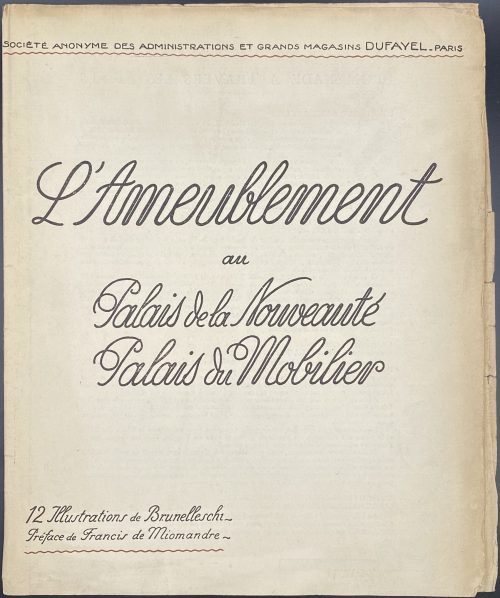 A set of 12 photomechanically reproduced illustrations after gouaches by Umberto Brunelleschi (Italian, 1879 – 1949), in colour; b/w photographs reproductions on verso, in a paper folder without the outer wrappers (b/w with birds, insects, and flowers). Text on the folder by French novelist Francis de Miomandre (French, 1880 – 1959); published by Grands Magasins Dufayel (1856 – 1930), a Parisian department store, run by Georges Dufayel (French, 1855 – 1916). Size: 29 x 24 cm. Images printed on cream paper within a beige frame, lettered above the frame in beige: "Societé Anonyme des Administrations et Grands Magasins DUFAYEL — Paris —", under the frame: "Palais de la Nouveauté ~ Palais du Mobilier | Entrée principale 7 Bould BARBES"; at the bottom of the frame lettered black on each image: Le Style Chinois, Le Style Empire, Le Style Japonais, Le Style Louis XIV, Le Style Louis XV, Le Style Louis XVI, Le Style Moderne (2), Le Style Moyen Age, Le Style Renaissance, Le Style Vénitien, Le Style Persian.
A set of 12 photomechanically reproduced illustrations after gouaches by Umberto Brunelleschi (Italian, 1879 – 1949), in colour; b/w photographs reproductions on verso, in a paper folder without the outer wrappers (b/w with birds, insects, and flowers). Text on the folder by French novelist Francis de Miomandre (French, 1880 – 1959); published by Grands Magasins Dufayel (1856 – 1930), a Parisian department store, run by Georges Dufayel (French, 1855 – 1916). Size: 29 x 24 cm. Images printed on cream paper within a beige frame, lettered above the frame in beige: "Societé Anonyme des Administrations et Grands Magasins DUFAYEL — Paris —", under the frame: "Palais de la Nouveauté ~ Palais du Mobilier | Entrée principale 7 Bould BARBES"; at the bottom of the frame lettered black on each image: Le Style Chinois, Le Style Empire, Le Style Japonais, Le Style Louis XIV, Le Style Louis XV, Le Style Louis XVI, Le Style Moderne (2), Le Style Moyen Age, Le Style Renaissance, Le Style Vénitien, Le Style Persian. -
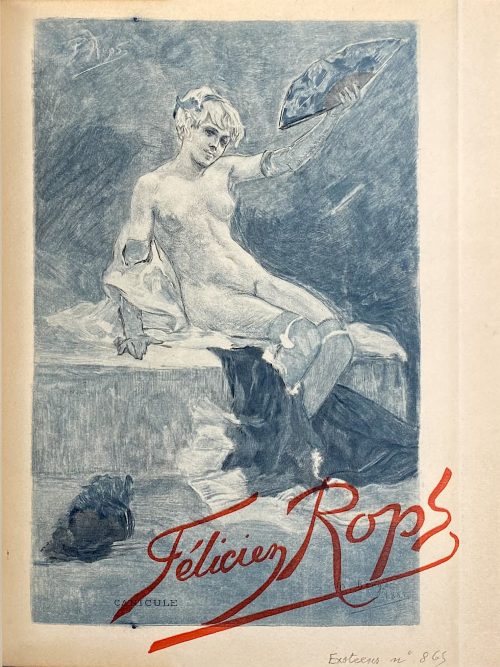 One volume in-4o, 26.5 x 21 x 4 cm, bound by Durvand (signed) in tan quarter morocco over marbled boards, spine with raised bands and gilt lettering, top margin gilt, marbled endpapers, publisher’s wrappers preserved; enriched with 39 original prints after Félicien Rops. Collation: 2 blanks, π5 (original front wrapper ‘Canicule’/blank, 2 blanks, h.t./justification, t.p/blank), 1-294 301 (paginated 1-233 [234]) χ1 (advert.) plus frontispiece (photographic seated portrait of Félicien Rops, collotype, artist unknown) and 39 leaves of bound-in original prints by various printers on different papers, with tissue guards; back wrapper and original spine, 2 blanks; loosely inset a marriage invitation for Dr Robert Fasquelle and Mlle Suzanne Luneau with a partial list of prints, incl. page numbers. Title-page (red and black): Études sur quelques Artistes originaux | — | FÉLICIEN ROPS | par | CAMILLE LEMONNIER | {fleuron} | PARIS | H. FLOURY, ÉDITEUR | 1, Boulevard des Capucines, 1 | – | 1908 || Limitation: 125 copies with two original plates «Canicule» and «Seule» numbered 1-125, of which 100 copies on Japon à la forme, 25 copies on papier de Chine; plus 50 copies on papier vélin with one coloured plate «Canicule», numbered 126-175, printed by Edmond Deman in Brussels. Our copy is on dense wove paper (vélin), without a number. Photographs here represent the original prints only. Camille Lemonnier (Belgian, 1844 – 1913) – author. Félicien Rops (Belgian, 1833 – 1898) – artist. Henri Floury (French, 1862 –1961) – publisher. Edmond Deman (Belgian, 1857–1918) – printer. Lucien Durvand (French, 1852 – 1924) – bookbinder.
One volume in-4o, 26.5 x 21 x 4 cm, bound by Durvand (signed) in tan quarter morocco over marbled boards, spine with raised bands and gilt lettering, top margin gilt, marbled endpapers, publisher’s wrappers preserved; enriched with 39 original prints after Félicien Rops. Collation: 2 blanks, π5 (original front wrapper ‘Canicule’/blank, 2 blanks, h.t./justification, t.p/blank), 1-294 301 (paginated 1-233 [234]) χ1 (advert.) plus frontispiece (photographic seated portrait of Félicien Rops, collotype, artist unknown) and 39 leaves of bound-in original prints by various printers on different papers, with tissue guards; back wrapper and original spine, 2 blanks; loosely inset a marriage invitation for Dr Robert Fasquelle and Mlle Suzanne Luneau with a partial list of prints, incl. page numbers. Title-page (red and black): Études sur quelques Artistes originaux | — | FÉLICIEN ROPS | par | CAMILLE LEMONNIER | {fleuron} | PARIS | H. FLOURY, ÉDITEUR | 1, Boulevard des Capucines, 1 | – | 1908 || Limitation: 125 copies with two original plates «Canicule» and «Seule» numbered 1-125, of which 100 copies on Japon à la forme, 25 copies on papier de Chine; plus 50 copies on papier vélin with one coloured plate «Canicule», numbered 126-175, printed by Edmond Deman in Brussels. Our copy is on dense wove paper (vélin), without a number. Photographs here represent the original prints only. Camille Lemonnier (Belgian, 1844 – 1913) – author. Félicien Rops (Belgian, 1833 – 1898) – artist. Henri Floury (French, 1862 –1961) – publisher. Edmond Deman (Belgian, 1857–1918) – printer. Lucien Durvand (French, 1852 – 1924) – bookbinder. -
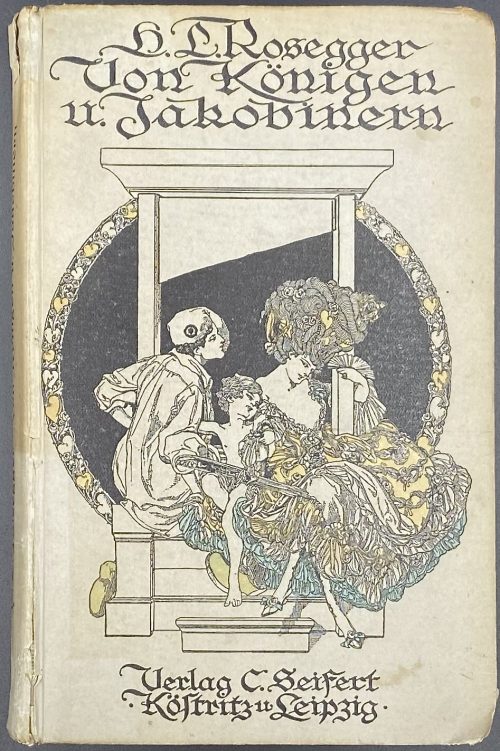 Cover (in blackletter): H. L. Rosegger. | Von Königen u. Jakobinern | {vignette by von Bayros} | Verlag C. Seifert | • Köstritz u Leipzig • || Title (blackletter): Von Königen | und Jakobinern | Von | Hans Ludwig Rosegger | mit vier Vollbildern und Buchschmuck | von Marquis F. von Bayros | {publisher’s device} | 1913 | C. Seifert Verlag, G.m.b.H. | Köstritz und Leipzig || Pagination: [2] – t.p. / blank, [2] – contents / blank, [1-3] 4-263 [264 vignette, colophon], 4 plates extraneous to collation, 2 vignettes. Collation: 8vo; 1-168 174. Binding: Hardcover, pictorial paper boards, lettering to spine, lettering and vignette by von Bayros to cover. Owner's inscription to ffl: "T. Lewe. März, 1919."
Cover (in blackletter): H. L. Rosegger. | Von Königen u. Jakobinern | {vignette by von Bayros} | Verlag C. Seifert | • Köstritz u Leipzig • || Title (blackletter): Von Königen | und Jakobinern | Von | Hans Ludwig Rosegger | mit vier Vollbildern und Buchschmuck | von Marquis F. von Bayros | {publisher’s device} | 1913 | C. Seifert Verlag, G.m.b.H. | Köstritz und Leipzig || Pagination: [2] – t.p. / blank, [2] – contents / blank, [1-3] 4-263 [264 vignette, colophon], 4 plates extraneous to collation, 2 vignettes. Collation: 8vo; 1-168 174. Binding: Hardcover, pictorial paper boards, lettering to spine, lettering and vignette by von Bayros to cover. Owner's inscription to ffl: "T. Lewe. März, 1919." -
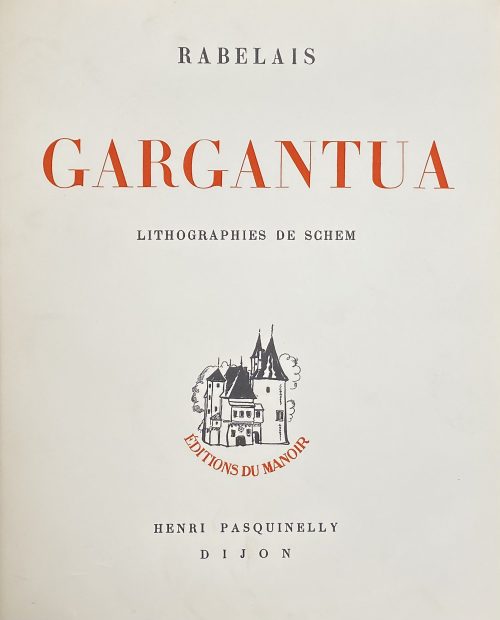 Description: One volume bound in green morocco, sunned spine with raised bands and gilt lettering, collated 8vo, 28.3 x 23 cm, original wrappers and spine preserved, top margin gilt; numerous in-text woodcuts, 30 full-page plates and one plate tipped-in. Front wrapper (red and black): RABELAIS | GARGANTUA | LITHOGRAPHIES DE SCHEM | {publisher’s device lettered in red “ÉDITIONS DU MANOIR”} | HENRI PASQUINELLY | DIJON || Half-title: LA VIE TRESHORRIFIQUE | DU | GRAND GARGANTUA | PERE DE PANTAGRUEL | JADIS COMPOSÉE | PAR MAISTRE ALCOFRIBAS | ABSTRACTEUR DE QUINTE ESSENCE | — | LIVRE PLEIN DE PANTAGRUELISME || Title-page (red and black): RABELAIS | GARGANTUA | LITHOGRAPHIES DE SCHEM | AVEC UNE PRÉFACE ET DES RÉSUMÉS EXPLICATIFS PAR | PIERRE HUGUENIN | UN GLOSSAIRE ET DES NOTES DE | LOUIS PERCEAU | {publisher’s device lettered in red “ÉDITIONS DU MANOIR”} | HENRI PASQUINELLY | DIJON || Collation: 2 blanks, front wrapper, [1] 2-118, spine, back wrapper, 2 blanks, total 88 leaves between the wrappers plus 30 plates incl. frontispiece, two of which are double-page, extraneous to collation with lettered tissue guards, and one cancelled plate with lettered tissue guard tipped-in. Pagination: [1-7] 8-171 [172] [2 colophon] [2 blank], total 176 pages, ils. Printed on February 20, 1937, at Imprimerie Darantière (Dijon), lithographs were printed by Desjobert (Paris). Limitation: The print run of 3,335 copies, of which 10 (№ I-X) on Japon Impérial, 300 copies (№ 1-300) on Vélin de Rives, 3000 copies (№ 301-3,300) on Bouffant Dauphinois, and 25 copies (A-Z ) on Vélin de Rives for collaborators. This is copy № 45 on Vélin de Rives, enriched with one cancelled plate (see image below).Collaborators: François Rabelais [Alcofribas Nasier] (French, c. 1494 – 1553) – author. Pierre Huguenin (French, 1874 – 1937) – author. Louis Perceau (French, 1883 – 1942) – author. Raoul Serres [Schem] (French, 1881– 1971) – artist. Éditions du manoir; Henri Pasquinelly [Pasquinelli] (French, 20th century) – publisher. Imprimerie Darantière (Dijon) – printer. Edmond Desjobert (French, 1888 – 1963); Edmond et Jacques Desjobert – lithography printer.
Description: One volume bound in green morocco, sunned spine with raised bands and gilt lettering, collated 8vo, 28.3 x 23 cm, original wrappers and spine preserved, top margin gilt; numerous in-text woodcuts, 30 full-page plates and one plate tipped-in. Front wrapper (red and black): RABELAIS | GARGANTUA | LITHOGRAPHIES DE SCHEM | {publisher’s device lettered in red “ÉDITIONS DU MANOIR”} | HENRI PASQUINELLY | DIJON || Half-title: LA VIE TRESHORRIFIQUE | DU | GRAND GARGANTUA | PERE DE PANTAGRUEL | JADIS COMPOSÉE | PAR MAISTRE ALCOFRIBAS | ABSTRACTEUR DE QUINTE ESSENCE | — | LIVRE PLEIN DE PANTAGRUELISME || Title-page (red and black): RABELAIS | GARGANTUA | LITHOGRAPHIES DE SCHEM | AVEC UNE PRÉFACE ET DES RÉSUMÉS EXPLICATIFS PAR | PIERRE HUGUENIN | UN GLOSSAIRE ET DES NOTES DE | LOUIS PERCEAU | {publisher’s device lettered in red “ÉDITIONS DU MANOIR”} | HENRI PASQUINELLY | DIJON || Collation: 2 blanks, front wrapper, [1] 2-118, spine, back wrapper, 2 blanks, total 88 leaves between the wrappers plus 30 plates incl. frontispiece, two of which are double-page, extraneous to collation with lettered tissue guards, and one cancelled plate with lettered tissue guard tipped-in. Pagination: [1-7] 8-171 [172] [2 colophon] [2 blank], total 176 pages, ils. Printed on February 20, 1937, at Imprimerie Darantière (Dijon), lithographs were printed by Desjobert (Paris). Limitation: The print run of 3,335 copies, of which 10 (№ I-X) on Japon Impérial, 300 copies (№ 1-300) on Vélin de Rives, 3000 copies (№ 301-3,300) on Bouffant Dauphinois, and 25 copies (A-Z ) on Vélin de Rives for collaborators. This is copy № 45 on Vélin de Rives, enriched with one cancelled plate (see image below).Collaborators: François Rabelais [Alcofribas Nasier] (French, c. 1494 – 1553) – author. Pierre Huguenin (French, 1874 – 1937) – author. Louis Perceau (French, 1883 – 1942) – author. Raoul Serres [Schem] (French, 1881– 1971) – artist. Éditions du manoir; Henri Pasquinelly [Pasquinelli] (French, 20th century) – publisher. Imprimerie Darantière (Dijon) – printer. Edmond Desjobert (French, 1888 – 1963); Edmond et Jacques Desjobert – lithography printer.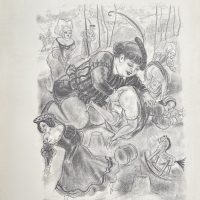
Ce petit paillard tousjours tastonnoyt ses gouvernantes cen dessus dessous, cen devant darriere.
-
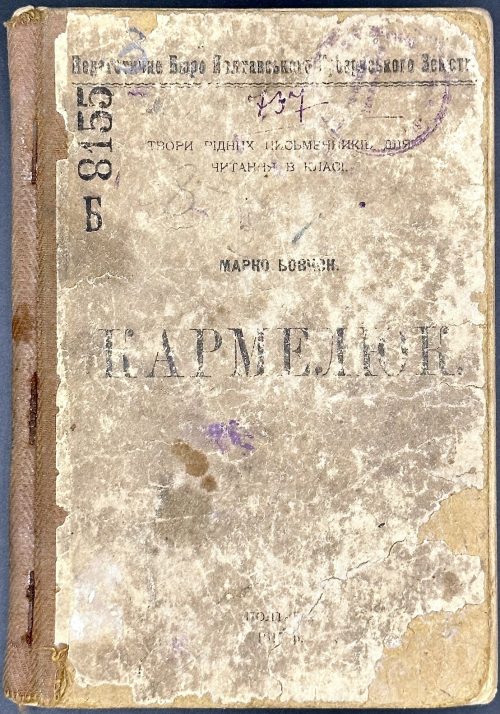 Owner’s quarter brown cloth, 18.2 x 12.5 cm, lettered paper over cardboard; text printed on tan paper, [1, 2] (t.p.), [i] ii-viii (intro.), [1] 4-48 (text); total 28 leaves; blue and red crayon marks to text; boards and pages with blue ink stamps and inscriptions. Front board: Педагогичне Бюро Полтавського Губернського Земства. | ТВОРИ РІДНИХ ПИСЬМЕННИКІВ ДЛЯ | ЧИТАННЯ В КЛАСІ.| МАРКО ВОВЧОК. | КАРМЕЛЮК. | ПОЛТАВА. | 1917 р. || Back board: Серія складається з творів: | Квітки, Вовчка, Шевченка, Куліша, | Руданського, Левицького І, Мирного, | Франка, Грінченка, Коцюбинського. | Полтава, друкарня Амчиславського. || Title-page: Педагогичне Бюро Полтавського Губернського Земства. | МАРКО ВОВЧОК. | КАРМЕЛЮК. | ПОЛТАВА. | 1917 р. || Contributors: Марко Вовчок [Marko Vovchok; Марія Олександрівна Вілінська] (Ukrainian, 1833 – 1907) – author. Other variants: Markowovzok and Marko Vovtchok. Амчиславский, М. Г. (Полтава, ул. Пушкина, 40) – printer.
Owner’s quarter brown cloth, 18.2 x 12.5 cm, lettered paper over cardboard; text printed on tan paper, [1, 2] (t.p.), [i] ii-viii (intro.), [1] 4-48 (text); total 28 leaves; blue and red crayon marks to text; boards and pages with blue ink stamps and inscriptions. Front board: Педагогичне Бюро Полтавського Губернського Земства. | ТВОРИ РІДНИХ ПИСЬМЕННИКІВ ДЛЯ | ЧИТАННЯ В КЛАСІ.| МАРКО ВОВЧОК. | КАРМЕЛЮК. | ПОЛТАВА. | 1917 р. || Back board: Серія складається з творів: | Квітки, Вовчка, Шевченка, Куліша, | Руданського, Левицького І, Мирного, | Франка, Грінченка, Коцюбинського. | Полтава, друкарня Амчиславського. || Title-page: Педагогичне Бюро Полтавського Губернського Земства. | МАРКО ВОВЧОК. | КАРМЕЛЮК. | ПОЛТАВА. | 1917 р. || Contributors: Марко Вовчок [Marko Vovchok; Марія Олександрівна Вілінська] (Ukrainian, 1833 – 1907) – author. Other variants: Markowovzok and Marko Vovtchok. Амчиславский, М. Г. (Полтава, ул. Пушкина, 40) – printer. -
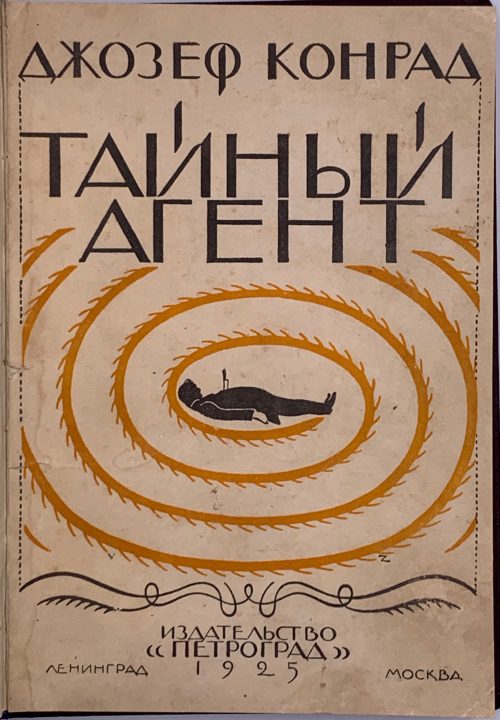 20 x 14.5 cm, owner’s burgundy buckram, upper original pictorial wrapper preserved, in black and yellow. Title: ДЖОЗЕФ КОНРАД | ТАЙНЫЙ АГЕНТ | (The secret agent) | Перевод с английского | М. МАТВЕЕВОЙ | под редакцией | В. А. АЗОВА | {device} | Издательство “ПЕТРОГРАД” | ЛЕНИНГРАД — МОСКВА | 1925. Pagination: ffl, [2] orig. wrapper/blank, [1, 2] t.p./imprint, 3-245 [3 advert.] Collation: 8vo; [1]8 2-158 164. Print run: 5.000 copies. Редактор перевода: В. А. Азов Contributors: Joseph Conrad (Polish-British, 1857 – 1924) – author. Владимир Александрович Ашкинази [Азов] (Russian-French, 1873 – 1941) – translator/editor. Марианна Николаевна Матвеева (Russian, 20th century) – translator. Original title: [LIB-2762.2021] Joseph Conrad. The secret agent: a simple tale. — London: Methuen & Co., [1907]; [LIB-3213.2023] Joseph Conrad. The secret agent: A drama in three acts. — London, T. Werner Laurie., 1923.
20 x 14.5 cm, owner’s burgundy buckram, upper original pictorial wrapper preserved, in black and yellow. Title: ДЖОЗЕФ КОНРАД | ТАЙНЫЙ АГЕНТ | (The secret agent) | Перевод с английского | М. МАТВЕЕВОЙ | под редакцией | В. А. АЗОВА | {device} | Издательство “ПЕТРОГРАД” | ЛЕНИНГРАД — МОСКВА | 1925. Pagination: ffl, [2] orig. wrapper/blank, [1, 2] t.p./imprint, 3-245 [3 advert.] Collation: 8vo; [1]8 2-158 164. Print run: 5.000 copies. Редактор перевода: В. А. Азов Contributors: Joseph Conrad (Polish-British, 1857 – 1924) – author. Владимир Александрович Ашкинази [Азов] (Russian-French, 1873 – 1941) – translator/editor. Марианна Николаевна Матвеева (Russian, 20th century) – translator. Original title: [LIB-2762.2021] Joseph Conrad. The secret agent: a simple tale. — London: Methuen & Co., [1907]; [LIB-3213.2023] Joseph Conrad. The secret agent: A drama in three acts. — London, T. Werner Laurie., 1923. -
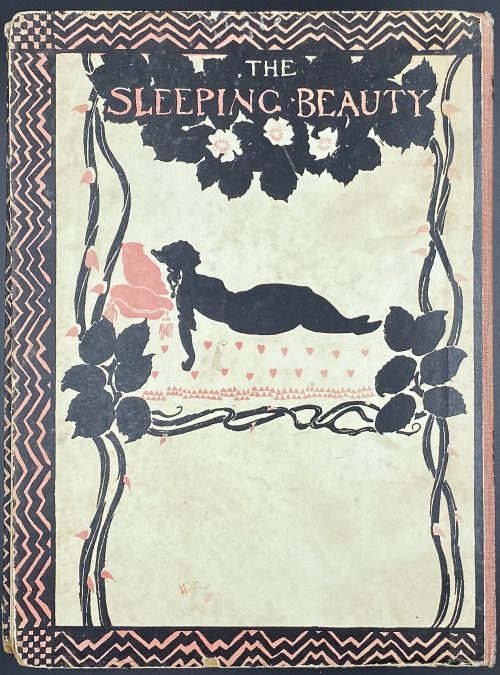 Title: THE SLEEPING | BEAUTY | TOLD BY C S EVANS | AND ILLUSTRATED BY | ARTHUR RACKHAM | LONDON WILLIAM HEINEMANN | PHILADELPHIA J B LIPPINCOTT Co || T.p. verso: LONDON WILLIAM HEINEMANN, 1920. Pagination: [1, 2] – h.t. / advert., [3, 4] – “WH” publisher’s device / frontis., [5, 6] – pictorial t.p. / publisher, year, [7, 8] – silhouette girls / Briar rose w/pasted offset ill., [9] 10-110 [2] – imprint / blank]. Collation: 8vo; B-G8, 3 double-leaf 3-colour woodcut illustrations extraneous to collation, in-text woodcuts. Illustrations: 25 full-page silhouettes, comprising 9 in colour (frontispiece and 4 double plates)--and 16 in black (including 4 double illustrations); one mounted coloured plate; silhouette head- and tailpieces and other silhouettes throughout the text, in black. Binding: Quarter cloth with black lettering, pictorial boards, pictorial endpapers. Size: 26 x 19.5. 1st edition. Inscription to h.t.: "To Dear Julia, Xmas 1947."
Title: THE SLEEPING | BEAUTY | TOLD BY C S EVANS | AND ILLUSTRATED BY | ARTHUR RACKHAM | LONDON WILLIAM HEINEMANN | PHILADELPHIA J B LIPPINCOTT Co || T.p. verso: LONDON WILLIAM HEINEMANN, 1920. Pagination: [1, 2] – h.t. / advert., [3, 4] – “WH” publisher’s device / frontis., [5, 6] – pictorial t.p. / publisher, year, [7, 8] – silhouette girls / Briar rose w/pasted offset ill., [9] 10-110 [2] – imprint / blank]. Collation: 8vo; B-G8, 3 double-leaf 3-colour woodcut illustrations extraneous to collation, in-text woodcuts. Illustrations: 25 full-page silhouettes, comprising 9 in colour (frontispiece and 4 double plates)--and 16 in black (including 4 double illustrations); one mounted coloured plate; silhouette head- and tailpieces and other silhouettes throughout the text, in black. Binding: Quarter cloth with black lettering, pictorial boards, pictorial endpapers. Size: 26 x 19.5. 1st edition. Inscription to h.t.: "To Dear Julia, Xmas 1947." -
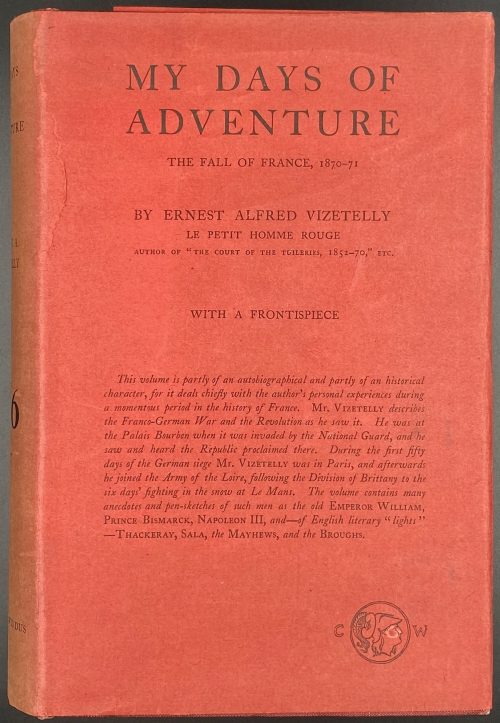 Description: Hardcover volume bound in red cloth with black lettering to front cover and spine, in a red dustjacket with black lettered, bookplate to front pastedown “ from the library of | DAVID. D. LEVINE | Militaria” in triple fillet frame, bookseller’s label to front fep “CHAS. E. LAURIAT CO. | IMPORTERS & BOOKSELLERS | 385 Wash’n St. Boston”. Title-page in red and black: MY DAYS OF ADVENTURE | THE FALL OF FRANCE, 1870-71 | BY ERNEST ALFRED VIZETELLY | LE PETIT HOMME ROUGE | AUTHOR OF “THE COURT OF THE TUILERIES 1852-70” ETC. | {publisher’s device} | WITH A FRONTISPIECE | LONDON | CHATTO & WINDUS | 1914 || Pagination: [2] advert., [i-vii] viii-xi [xii] [2] contents/blank, [1] 2-337 [338] [2], 340 pages total plus photo frontis. Collation: [A8] B-Y8 Z2, 170 leaves total plus one leaf of plates. Provenance: David D. Levine Contributors: Ernest Alfred Vizetelly (British, 1853 – 1922) – author. Charles E. Lauriat Company, Booksellers and Importers, Boston, Massachusetts. Charles Emelius Lauriat, Jr. (American, 1874 – 1937) – collector of rare books and prints Chatto & Windus (London) – publisher. David Daniel Levine (Australian, 1944 – 2020) – Australian judge and book collector
Description: Hardcover volume bound in red cloth with black lettering to front cover and spine, in a red dustjacket with black lettered, bookplate to front pastedown “ from the library of | DAVID. D. LEVINE | Militaria” in triple fillet frame, bookseller’s label to front fep “CHAS. E. LAURIAT CO. | IMPORTERS & BOOKSELLERS | 385 Wash’n St. Boston”. Title-page in red and black: MY DAYS OF ADVENTURE | THE FALL OF FRANCE, 1870-71 | BY ERNEST ALFRED VIZETELLY | LE PETIT HOMME ROUGE | AUTHOR OF “THE COURT OF THE TUILERIES 1852-70” ETC. | {publisher’s device} | WITH A FRONTISPIECE | LONDON | CHATTO & WINDUS | 1914 || Pagination: [2] advert., [i-vii] viii-xi [xii] [2] contents/blank, [1] 2-337 [338] [2], 340 pages total plus photo frontis. Collation: [A8] B-Y8 Z2, 170 leaves total plus one leaf of plates. Provenance: David D. Levine Contributors: Ernest Alfred Vizetelly (British, 1853 – 1922) – author. Charles E. Lauriat Company, Booksellers and Importers, Boston, Massachusetts. Charles Emelius Lauriat, Jr. (American, 1874 – 1937) – collector of rare books and prints Chatto & Windus (London) – publisher. David Daniel Levine (Australian, 1944 – 2020) – Australian judge and book collector -
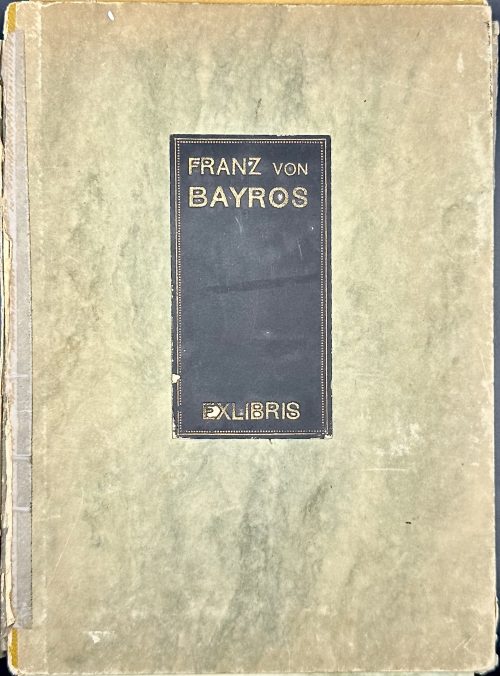 A set of 49 prints, heliogravures and etchings, tipped-in on 285 x 257 mm grey cards, in a green marbled folder with a gilt-lettered black label to the front. No publisher, no place, no year (s.l., s.n., s.d.), printed in circa 1910.
A set of 49 prints, heliogravures and etchings, tipped-in on 285 x 257 mm grey cards, in a green marbled folder with a gilt-lettered black label to the front. No publisher, no place, no year (s.l., s.n., s.d.), printed in circa 1910.- Vlastimil Blažek (Czech, 1878 – 1950): heliogravure, sheet 180 x 137 mm, plate 152 x 114 mm; laid paper, black sepia ink; unsigned.
- Ex libris Gerhard Wunderlich (architect in Dresden): heliogravure, sheet 205 x 150 mm, plate 158 x 115 mm; wove paper, brown sepia ink; inscription: heliogravure, sheet 180 x 137 mm, plate 152 x 114 mm; laid paper, sepia ink; inscription to top “Es ist alles so eng”; signed “F (backwards). Bayros”.
- Ex libris William Lipka: heliogravure, sheet 140 x 125 mm, plate 112 x 98 mm; laid paper, black sepia ink; signature hardly legible.
- Nikolaus Schindler (amateur photographer in Vienna): heliogravure, sheet 142 x 150 mm, plate 110 x 117 mm; laid paper, black sepia ink; unsigned.
- Sussy de Coiquard: heliogravure, sheet 160 x 140 mm, plate 128 x 110 mm; laid paper, black sepia ink; unsigned.
- Illegible, looks like “Vielluer Febréy”: heliogravure, sheet 120 x 109 mm, plate 93 x 85 mm; laid paper, black, sepia ink; signed “F (backwards). Bayros:”.
- Ex libris Erich Liebermann-Rosswiese (Greman-Jewish, 1886 – 1942): heliogravure, sheet 180 x 139 mm, plate 118 x 88 mm; wove paper, black sepia ink; unsigned.
- Ex libris Dr. phil. Rudolf Ludwig: before letters, heliogravure, sheet 150 x 132 mm, plate 120 x 110 mm; laid paper, black sepia ink; unsigned. See [LIB-3258.2023] John Cleland. Die Memoiren der Fanny Hill. — Paphos [i.e. Vienna]: C. W. Stern, 1906.
- Unidentified: before letters, heliogravure, sheet 150 x 115 mm, plate 113 x 88 mm; laid paper, black sepia ink; signed “F. Bayros” in the manuscript. Circumstantial evidence tells that this bookplate belongs to someone A.W.(Artur Wolf). See №22.
- Lulu. Monachia. Gest. v. Ritter Dialekt und Junker Erich: heliogravure, sheet 204 x 152 mm, plate 160 x 118 mm; wove paper, black sepia ink; unsigned. See №20.
- Kellner Jstván: (István): heliogravure, sheet 118 x 100 mm, plate 85 x 70 mm; laid paper, black sepia ink; signed “Franz Bayros” in the script (hardly legible).
- Adyton: heliogravure, sheet 170 x 130 mm, plate 113 x 85 mm; wove paper, black, sepia ink; signed “F (backwards). Bayros”.
- 13.Ex libris George Arthur Buhl (American, 1883 – 1959): heliogravure, sheet 166 x 140 mm, plate 120 x 92 mm; wove paper, black sepia ink; inscription “!I will! | !And I can!”; bust inscribed “T. Carlyle”; signed “F (backwards). Bayros” (hardly legible).
- Ex-Libris Heinrich und Lise Fuhrmann: heliogravure, sheet 165 x 149 mm, plate 120 x 103 mm; wove paper, black sepia ink; signed “F (backward). Bayros”; inscription “So schaff ich am sausenden Webstuhl der Zeit und wirke der Gottheit lebendiges Kleid” (from ‘Faust’ by Goethe).
- Ex libris Gerhard Wunderlich (architect in Dresden): heliogravure, sheet 165 x 137 mm, plate 135 x 105 mm; laid paper, black, sepia ink; signed “F (backwards). Bayros”.
- Ex Libris Walther u. Amelia Fahrenhorst; Walter Fahrenhorst (German, 1871 – 1938): heliogravure, sheet 165 x 140 mm, plate 128 x 95 mm; wove paper, black sepia ink; signed “F. Bayros” in the manuscript. The inscription behind the strings: NITOR (lat. beauty, glamour).
- Ex Libris Margot Lewknecht; heliogravure, sheet 145 x 140 mm, plate 128 x 118 mm; laid paper, black sepia ink; signed “F. Bayros”.
- Ex Libris Walther Heinisch (publisher in Carlsbad); heliogravure, sheet 185 x 145 mm, plate 140 x 110 mm; wove paper, sanguine; male bust with an inscription to the base: “Arnold Boeklin” / Arnold Böcklin (Swiss, 1827 – 1901); inscription: “mit gêru scal man geba infâhan” – a line from Hildebrandslied, the earliest poetic text in German. Unsigned.
- Bookplate with music score GGDBGC; heliogravure, sheet 125 x 135 mm, plate 100 x 110 mm, with monogram «HCJ»; laid paper, brown sepia ink; signed “F. Bayros”.
- Bookplate with inscription: Lulu aus Praga | Gest v. Ritter Dialekt / Monachia / Monachia / und Junker Erich; heliogravure, sheet 182 x 147 mm, plate 160 x 120 mm, image 122 x 105 mm; wove paper, bluish-black sepia ink; unsigned. See №10.
- Bookplate, no inscription; heliogravure, laid paper, sepia ink, sheet 148 x 127 mm, image 84 x 79 mm; signed F. Bayros in the manuscript beneath the image.
- Ex libris Artur Wolf: heliogravure, laid paper, sepia ink, sheet 170 x 150 mm, image 120 x 105 mm; signed F. Bayros in the manuscript to the frame of the image. See №9.
- Ex Libris E. K. Weigl: heliogravure, laid paper, sepia ink, sheet 139 x 121 mm, plate 112 x 97 mm; unsigned; inscription above male portrait: “LEONARDO”.
- Ex libris Dr. A. Bergmann: heliogravure, wove paper, sepia ink; sheet 180 x 140 mm, plate 130 x 105 mm; signed F. Bayros in the manuscript.
- Grete Cäcilie (monogram “PS”): heliogravure, laid paper, sepia ink, sheet 161 x 130 mm, plate 128 x 103 mm, signature illegible.
- Emma Steigleder: heliogravure, laid paper, black ink, sheet 181 x 141 mm, plate 158 x 117 mm, signed F. Bayros in the manuscript. Inscription “Si vis amari, ama! Seneca” [If you want to be loved, love] to the attic of the arch.
- Bruno Fischer: heliogravure, laid paper, sepia ink, sheet 186 x 145 mm, plate 155 x 116 mm, signed “F (backward). Bayros”. Inscription to bottom “Gehl Weck’ ihn nicht auf seien wir froh dass er einmal schläft!”
- Harnasch: heliogravure, wove paper, sepia ink; unsigned; sheet 140 x 132 mm, plate 100 x 85 mm; unsigned.
- Eduard Klampfl: heliogravure, laid paper, sepia ink, sheet 165 x 145 mm, plate 135 x 110 mm, signed “F (backwards). Bayros”; portrait bust of the composer Richard Wagner (German, 1813 –1883).
- Jorge Monsalvatje: heliogravure, wove paper, sepia ink; sheet 189 x 160 mm, plate 150 x 115 mm; signed F. Bayros in the manuscript.
- E. K. W.: wove paper, sepia ink; sheet 150 x 120 mm; signed “Bayros”.
- Unidentified bookplate: wove paper, sepia ink; sheet 150 x 120 mm; signed “F. Bayros 09” in the manuscript.
- Ex-Libris Helene and Emil Lemberger: heliogravure (or soft ground etching), laid paper, sepia ink, sheet 180 x 163 mm, plate 150 x 130 mm, signed “F. Bayros” in the manuscript.
- M. Z.: wove paper, sepia ink; sheet 130 x 170 mm, plate 90 x 120 mm; signed “F (backwards) Bayros”.
- Ex libris Frankl Frigyes Vilmos: heliogravure (or soft ground etching), laid paper, sepia ink, sheet 140 x 148 mm, unsigned. Frigyes Frankl, born in Tejfalu, Szlovákia, died in 1943.
- Ex libris Anton Bürck: heliogravure, wove paper, sepia ink; sheet 170 x 137 mm, plate 123 x 104 mm; unsigned. Anton Burck (German,1881 – 1951) of Palatinate, Bavaria.
- Aus den büchern A. W.: heliogravure, laid paper, sepia ink, sheet 152 x 136 mm, plate 120 x 105 mm, signed “F. Bayros” in the manuscript.
- Ex libris Hans Hickl: heliogravure, laid paper, sepia ink, sheet 150 x 125 mm, plate 115 x 95 mm, signed “Ω”.
- Ex libris Karl Wehle: soft ground etching, laid paper, brown sepia ink, sheet 107 x 90 mm, plate 80 x 65 mm, inscription “Gut!” in the centre; unsigned. Karl Wehle (Austrian, 1901 – 1933)
- Ex libris Dr. Paul Berger: etching, laid paper, black ink, sheet 140 x 115 mm, plate 115 x 85 mm, signed “F (backwards). Bayros”.
- Unidentified bookplate: etching, laid paper, black ink, sheet 145 x 115 mm, plate 85 x 70 mm, unsigned.
- Ex Bibliotheca Erotica Carl Georg von Maassen: soft ground etching, india paper, black ink, sheet 76 x 78 mm, signed “FB”.
- Ex Bibliotheca Erotica Carl Georg von Maassen: soft ground etching, india paper, black ink, sheet 79 x 79 mm, signed “F. von Bayros”.
- Paul Mixa: soft ground etching, laid paper, sanguine ink, sheet 122 x 111 mm, plate 90 x 85 mm, inscription: “Gerne hör’ich wenn du singest und ich horche wenn du schweigest” [I like to hear when you sing and I listen when you are silent].
- Ex libris Drs Q. M. Vyskocil.: etching, laid paper, sanguine ink, sheet 141 x 115 mm, plate 115 x 75 mm, inscription: “MIT REINEN HAENDEN” [with pure hands], signed “F. Bayros” in the manuscript.
- Ex libris Andrée Bearn de Riquer: soft ground etching, laid paper, sanguine ink, sheet 136 x 88 mm, plate 100 x 62 mm, signed “F (backwards). Bayros”. Andrée Béarn [Marguerite Laborde] (French, 1880 – 1973), spouse of Alexandre de Riquer (Catalan, 1856 – 1920).
- Ex musicis Drs Blažek VL: etching, wove paper, sanguine ink, sheet 141 x 116 mm, plate 115 x 90 mm, inscription: “MIT REINEN HAENDEN” [with pure hands], signed “F. Bayros” in the manuscript. See Vlastimil Blažek (Czech, 1878 – 1950) № 1 in this series.
- Ex libris Paul Lindenberg: etching, wove paper, sanguine ink, sheet 130 x 114 mm, plate 95 x 90 mm, image 80 x 72 mm, inscription: “ad pios usus” (for pious uses); signed with monogram “F (backwards). B”.
- Unidentified bookplate: heliogravure, laid paper, sanguine ink, sheet 150 x 131 mm, plate 120 x 100 mm, signed “F. Bayros” in the manuscript.
-
![Adelbert von Chamisso. Peter Schlemihls wundersame Geschichte. – Leipzig: Im Insel-Verlag, [1916 or 1923 or 1940] (Series: Insel-Bücherei, Nr. 194). – pp.: ff [1 t.p., 2 blank] 3-79 [80] bf., with 4 etchings [instead of woodcuts] by Adolf Schrödter [1838].](https://varshavskycollection.com/wp-content/uploads/2021/02/LIB-2497.2020-a-500x740.jpeg) Title (Gothic typeset): Peter Schlemihls | wundersame Geschichte | Mitgeteilt | von | Adelbert von Chamisso | {publisher’s device} | — | Im Insel-Verlag zu Leipzig || Series: Insel-Bücherei, Nr. 194. Pagination: 8vo; [1, 2] 3-79 [80]; 4 photomechanical reproductions of woodcuts by Adolf Schrödter [1838] within collation. Binding: 18.5 x 12.5 cm, hardcover, original patterned paper over cardboard, title label in yellow and black pasted to cover, label to spine. According to Herbert Kästner Die Insel-Bücherei: Bibliographie, 1912 - 1999: 4 illustrations by Adolf Schrödter, produced for 1838 edition as wood engravings here reproduced by photogravure. There were four print runs of this edition: 1916: 1.-10. Tsd; 1923: 35. Tsd; 1940: 55. Tsd. There is currently no way to tell which one is this. Contributors: Chamisso, Adelbert von (German, 1781–1838) – author. Schrödter, Adolf (German, 1805 – 1875) – artist.
Title (Gothic typeset): Peter Schlemihls | wundersame Geschichte | Mitgeteilt | von | Adelbert von Chamisso | {publisher’s device} | — | Im Insel-Verlag zu Leipzig || Series: Insel-Bücherei, Nr. 194. Pagination: 8vo; [1, 2] 3-79 [80]; 4 photomechanical reproductions of woodcuts by Adolf Schrödter [1838] within collation. Binding: 18.5 x 12.5 cm, hardcover, original patterned paper over cardboard, title label in yellow and black pasted to cover, label to spine. According to Herbert Kästner Die Insel-Bücherei: Bibliographie, 1912 - 1999: 4 illustrations by Adolf Schrödter, produced for 1838 edition as wood engravings here reproduced by photogravure. There were four print runs of this edition: 1916: 1.-10. Tsd; 1923: 35. Tsd; 1940: 55. Tsd. There is currently no way to tell which one is this. Contributors: Chamisso, Adelbert von (German, 1781–1838) – author. Schrödter, Adolf (German, 1805 – 1875) – artist. -
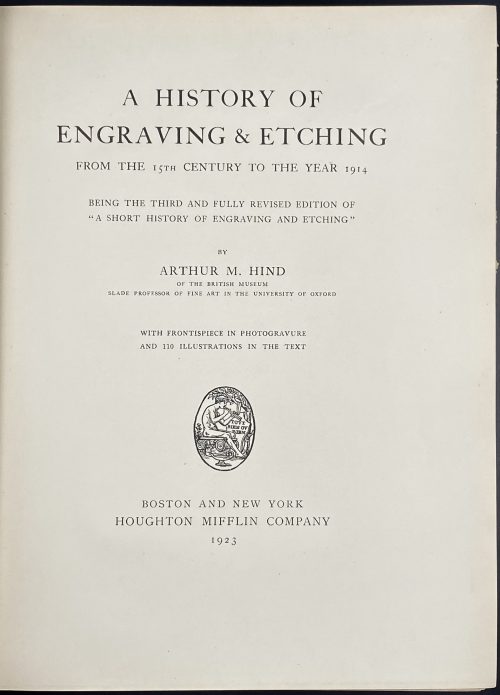 Title: A HISTORY OF | ENGRAVING & ETCHING | FROM THE 15TH CENTURY TO THE YEAR 1914 | BEING THE THIRD AND FULLY REVISED EDITION OF | “A SHORT HISTORY OF ENGRAVING AND ETCHING” | BY | ARTHUR M. HIND | OF THE BRITISH MUSEUM | SLADE PROFESSOR OF FINE ART IN THE UNIVERSITY OF OXFORD | WITH FRONTISPIECE IN PHOTOGRAVURE | AND 110 ILLUSTRATIONS IN THE TEXT | {publisher’s device} | BOSTON AND NEW YORK | HOUGHTON MIFFLIN COMPANY | 1923 || Pagination: [i-iv] v-xiii. [2] – blank / abbrev., [2] 3-487 [488], frontis. w/tissue guard, ills.; Appendices: I. Classified list of engravers (p. 343-392); II. General bibliography (p. 393-419); III. Index of engravers and individual bibliography (p. 420-487). Collation: π10 B-2H8 2I4, frontispiece (extr.), 110 in-text illustrations. Binding: 25.8 x 20 cm, crimson cloth, blind triple-fillet to top and bottom of the front board, same in gilt to spine, gilt lettering to spine, top edge gilt, fore-edge untrimmed. Contributors: Arthur Mayger Hind (British, 1880 – 1957) – author. Houghton Mifflin Company (Boston, 1864) – publisher. R & R. Clark, Ltd. (Edinburgh, 1846) – printer. Note: It is marked as the 3rd edition of A short history of engraving and etching. Indeed, A short history of engraving & etching for the use of collectors and students with full bibliography, classified list and index of engravers was published by Constable in London and Houghton Mifflin Co. in Boston, in 1908 and then in 1911. However, it is hard to consider an almost completely new book "a 3rd edition".
Title: A HISTORY OF | ENGRAVING & ETCHING | FROM THE 15TH CENTURY TO THE YEAR 1914 | BEING THE THIRD AND FULLY REVISED EDITION OF | “A SHORT HISTORY OF ENGRAVING AND ETCHING” | BY | ARTHUR M. HIND | OF THE BRITISH MUSEUM | SLADE PROFESSOR OF FINE ART IN THE UNIVERSITY OF OXFORD | WITH FRONTISPIECE IN PHOTOGRAVURE | AND 110 ILLUSTRATIONS IN THE TEXT | {publisher’s device} | BOSTON AND NEW YORK | HOUGHTON MIFFLIN COMPANY | 1923 || Pagination: [i-iv] v-xiii. [2] – blank / abbrev., [2] 3-487 [488], frontis. w/tissue guard, ills.; Appendices: I. Classified list of engravers (p. 343-392); II. General bibliography (p. 393-419); III. Index of engravers and individual bibliography (p. 420-487). Collation: π10 B-2H8 2I4, frontispiece (extr.), 110 in-text illustrations. Binding: 25.8 x 20 cm, crimson cloth, blind triple-fillet to top and bottom of the front board, same in gilt to spine, gilt lettering to spine, top edge gilt, fore-edge untrimmed. Contributors: Arthur Mayger Hind (British, 1880 – 1957) – author. Houghton Mifflin Company (Boston, 1864) – publisher. R & R. Clark, Ltd. (Edinburgh, 1846) – printer. Note: It is marked as the 3rd edition of A short history of engraving and etching. Indeed, A short history of engraving & etching for the use of collectors and students with full bibliography, classified list and index of engravers was published by Constable in London and Houghton Mifflin Co. in Boston, in 1908 and then in 1911. However, it is hard to consider an almost completely new book "a 3rd edition". -
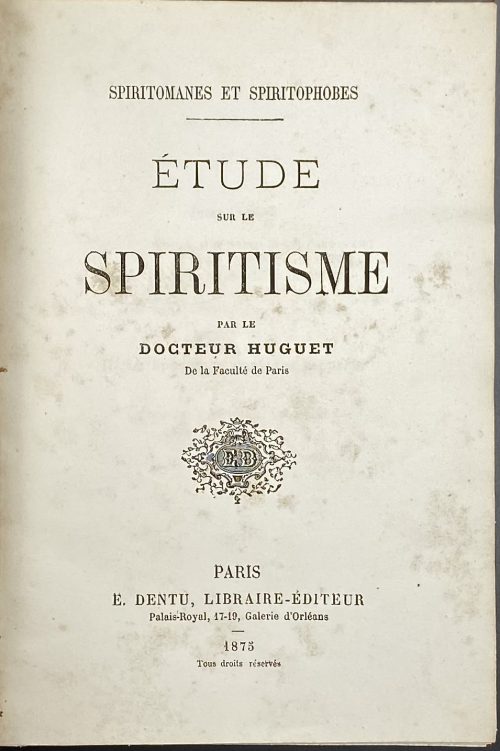 Hardcover volume 20 x 14 cm, bound in burgundy half faux chagrin over brown faux chagrin boards, gilt lettering to spine, marbled endpapers, all margins sprinkled blue. Convolute: 1) SPIRITOMANES ET SPIRITOPHOBES |— | ÉTUDE | SUR LE | SPIRITISME | PAR LE | DOCTEUR HUGUET | De la Faculté de Paris | {« ED » publsiher’s device} | PARIS | E. DENTU, LIBRAIRE-ÉDUTEUR | Palais-Royal, 17-19, Galerie d’Orléans | – | 1875 | Tous droits réservés ||; pp. [1-7] 8-48, with Dr Huguet signature to h.t. verso. Contents: Introduction. I. Le procès du 16 juin 1875; MM. Firman, Buguet, Leymarie. II. Le Spiritisme dans ses rapports avec le dogme, l’histoire, la science. Conclusion. 2) Same, pp. [1-7] 8-48, with Dr Huguet signature to h.t. verso. 3) FÉDÉRATION SPIRITE BELGE | — | Étude critique | DU LIVRE INTITULÉ | L'Hypnotisme | et le Spiritisme | du Docteur Joseph LAPPONI | Médecin de L. L. S. S. LÉON XIII et PIE X. | * | CONFÉRENCE | PAR | J. FRAIKIN | Président de la Fédération Spirite de Liége, | Vice-Président de la Fédération Spirite Belge. | * | Imp. Emile Dumon | Rue Haute-Marexhe, 27, Herstal-Liége. ||; pp. [1-3] 4-50 [51] errata/blank. 4) BUREAU PERMANENT D’ÉTUDE | DES | PHÉNOMÈNES SPIRITES | ANVERS | * | Cours De Doctrine Spirite | — | Imprimerie et Publicité « LA GÉNÉRALE » (SOC. AN.) Anvers. ||; 6 leaves, pagination trimmed out with partly visible numbers 13 and 18 ; includes Deuxième leçon « Du passage de la vie… », t.p., 7 pp. of text, last three pages blank. 5) LA PSYCHOLOGIE EXPERIMENTALE || Manifeste adresse par le « Syndicat de la Presse spiritualiste de France » | au Congres spiritualiste de Londres (Juin 1898); pp. [1] 2-31 [32]. Contents: I. Prolégomènes. II. Télépathie. III. Médiumnité. Conclusion. 6) LE FLUIDE HUMAIN | Son existence/ | Ses lois * Ses propriétés | — | CONFÉRENCE | DONNÉE PAR LE | Sous-Lieutenant DE BACKERE | — ||; pp. [1-3] 4-28. Contributors: Hilarion Huguet (French, ? – ?) Alfred-Henri Firman (American, ? – ?) Édouard Isidore Buguet (1840 – 1901) Pierre-Gaëtan Leymarie (1827 – 1901) Giuseppe Lapponi (Italian, 1851 – 1906) Jacques Fraikin (Belgian, ? – ?) Franz de Backere (Belgian, ? – ?)
Hardcover volume 20 x 14 cm, bound in burgundy half faux chagrin over brown faux chagrin boards, gilt lettering to spine, marbled endpapers, all margins sprinkled blue. Convolute: 1) SPIRITOMANES ET SPIRITOPHOBES |— | ÉTUDE | SUR LE | SPIRITISME | PAR LE | DOCTEUR HUGUET | De la Faculté de Paris | {« ED » publsiher’s device} | PARIS | E. DENTU, LIBRAIRE-ÉDUTEUR | Palais-Royal, 17-19, Galerie d’Orléans | – | 1875 | Tous droits réservés ||; pp. [1-7] 8-48, with Dr Huguet signature to h.t. verso. Contents: Introduction. I. Le procès du 16 juin 1875; MM. Firman, Buguet, Leymarie. II. Le Spiritisme dans ses rapports avec le dogme, l’histoire, la science. Conclusion. 2) Same, pp. [1-7] 8-48, with Dr Huguet signature to h.t. verso. 3) FÉDÉRATION SPIRITE BELGE | — | Étude critique | DU LIVRE INTITULÉ | L'Hypnotisme | et le Spiritisme | du Docteur Joseph LAPPONI | Médecin de L. L. S. S. LÉON XIII et PIE X. | * | CONFÉRENCE | PAR | J. FRAIKIN | Président de la Fédération Spirite de Liége, | Vice-Président de la Fédération Spirite Belge. | * | Imp. Emile Dumon | Rue Haute-Marexhe, 27, Herstal-Liége. ||; pp. [1-3] 4-50 [51] errata/blank. 4) BUREAU PERMANENT D’ÉTUDE | DES | PHÉNOMÈNES SPIRITES | ANVERS | * | Cours De Doctrine Spirite | — | Imprimerie et Publicité « LA GÉNÉRALE » (SOC. AN.) Anvers. ||; 6 leaves, pagination trimmed out with partly visible numbers 13 and 18 ; includes Deuxième leçon « Du passage de la vie… », t.p., 7 pp. of text, last three pages blank. 5) LA PSYCHOLOGIE EXPERIMENTALE || Manifeste adresse par le « Syndicat de la Presse spiritualiste de France » | au Congres spiritualiste de Londres (Juin 1898); pp. [1] 2-31 [32]. Contents: I. Prolégomènes. II. Télépathie. III. Médiumnité. Conclusion. 6) LE FLUIDE HUMAIN | Son existence/ | Ses lois * Ses propriétés | — | CONFÉRENCE | DONNÉE PAR LE | Sous-Lieutenant DE BACKERE | — ||; pp. [1-3] 4-28. Contributors: Hilarion Huguet (French, ? – ?) Alfred-Henri Firman (American, ? – ?) Édouard Isidore Buguet (1840 – 1901) Pierre-Gaëtan Leymarie (1827 – 1901) Giuseppe Lapponi (Italian, 1851 – 1906) Jacques Fraikin (Belgian, ? – ?) Franz de Backere (Belgian, ? – ?) -
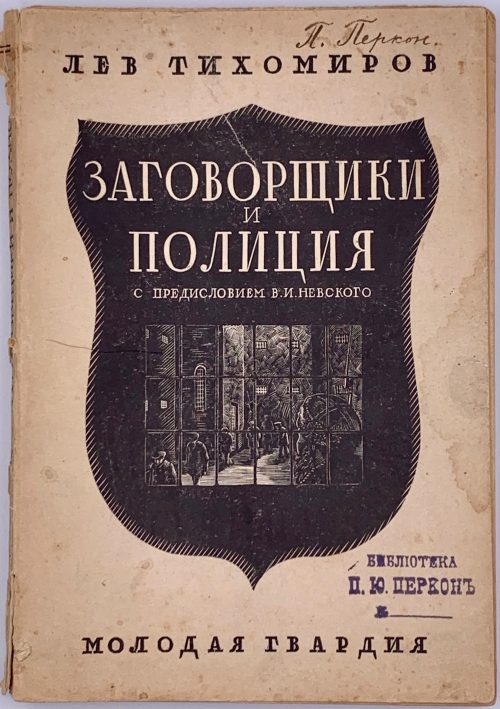 Front pictorial wrapper: ЛЕВ ТИХОМИРОВ | ЗАГОВОРЩИКИ | И | ПОЛИЦИЯ | С ПРЕДИСЛОВИЕМ В. И. НЕВСКОГО | МОЛОДАЯ ГВАРДИЯ || Title page: РЕВОЛЮЦИОННОЕ ДВИЖЕНИЕ В РОССИИ В МЕМУАРАХ | СОВРЕМЕННИКОВ | ПОД РЕДАКЦИЕЙ В. НЕВСКОГО И П. АНАТОЛЬЕВА | ЛЕВ ТИХОМИРОВ | ЗАГОВОРЩИКИ | И | ПОЛИЦИЯ | ПРЕДИСЛОВИЕ В. НЕВСКОГО | МОЛОДАЯ ГВАРДИЯ | МОСКВА – ЛЕНИНГРАД || Title verso: Обложка – гравюра на дереве | работы Н. П. Дмитровского | {printer’s device} | Издат. № 2633 | Ленинградский Областлит № 8371 | Тираж 5.000 экз. | 1928 г. Back wrapper: Заказы направлять: | [….] | {publisher’s device} | 1 р. 25 коп. | Р || Pagination: [1-3] 4-229 [3]; pp. 205-226 – notes, 227-229 – index. Collation: [1]8 2-148 154. Binding: publisher’s pictorial wrappers, lettering to spine and back cover. Print run 5,000 copies. Provenance: П. Ю. Перкон (to front cover nut-ink inscription: «П. Перкон», blue ink stamp to cover and t.p.: «БИБЛИОТЕКА | П. Ю. ПЕРКОНЪ | №» Personae: Перкон, Петр Юрьевич [Густавович] (Latvian, 1885 – 1938) — member of the communist party (Bolsheviks) since 05.1905; arrested: 05.02.1938, shot: 22.04.1938. — Previous owner. Невский, Владимир Иванович [Кривобоков or Кривобок, Феодосий Иванович] (Russian, 1876 – 1937) — arrested: 20.02.1935, shot: 26.05.1937. — Editor of the series and author of the foreword. Анатольев, П. И. [Фаресов, Анатолий Иванович; Faresov, Anatoly (Russian, 1852 – 1928). — Editor of the series. Тихомиров, Лев Александрович (Russian, 1852 – 1923). — Author of the text. Дмитревский [Дмитриевский; Дмитровский], Николай Павлович (Russian, 1890 — 1938) — arrested 15.12.1937 , shot: 02.01.1938. — Artist/engraver of the woodcut on the cover.
Front pictorial wrapper: ЛЕВ ТИХОМИРОВ | ЗАГОВОРЩИКИ | И | ПОЛИЦИЯ | С ПРЕДИСЛОВИЕМ В. И. НЕВСКОГО | МОЛОДАЯ ГВАРДИЯ || Title page: РЕВОЛЮЦИОННОЕ ДВИЖЕНИЕ В РОССИИ В МЕМУАРАХ | СОВРЕМЕННИКОВ | ПОД РЕДАКЦИЕЙ В. НЕВСКОГО И П. АНАТОЛЬЕВА | ЛЕВ ТИХОМИРОВ | ЗАГОВОРЩИКИ | И | ПОЛИЦИЯ | ПРЕДИСЛОВИЕ В. НЕВСКОГО | МОЛОДАЯ ГВАРДИЯ | МОСКВА – ЛЕНИНГРАД || Title verso: Обложка – гравюра на дереве | работы Н. П. Дмитровского | {printer’s device} | Издат. № 2633 | Ленинградский Областлит № 8371 | Тираж 5.000 экз. | 1928 г. Back wrapper: Заказы направлять: | [….] | {publisher’s device} | 1 р. 25 коп. | Р || Pagination: [1-3] 4-229 [3]; pp. 205-226 – notes, 227-229 – index. Collation: [1]8 2-148 154. Binding: publisher’s pictorial wrappers, lettering to spine and back cover. Print run 5,000 copies. Provenance: П. Ю. Перкон (to front cover nut-ink inscription: «П. Перкон», blue ink stamp to cover and t.p.: «БИБЛИОТЕКА | П. Ю. ПЕРКОНЪ | №» Personae: Перкон, Петр Юрьевич [Густавович] (Latvian, 1885 – 1938) — member of the communist party (Bolsheviks) since 05.1905; arrested: 05.02.1938, shot: 22.04.1938. — Previous owner. Невский, Владимир Иванович [Кривобоков or Кривобок, Феодосий Иванович] (Russian, 1876 – 1937) — arrested: 20.02.1935, shot: 26.05.1937. — Editor of the series and author of the foreword. Анатольев, П. И. [Фаресов, Анатолий Иванович; Faresov, Anatoly (Russian, 1852 – 1928). — Editor of the series. Тихомиров, Лев Александрович (Russian, 1852 – 1923). — Author of the text. Дмитревский [Дмитриевский; Дмитровский], Николай Павлович (Russian, 1890 — 1938) — arrested 15.12.1937 , shot: 02.01.1938. — Artist/engraver of the woodcut on the cover. -
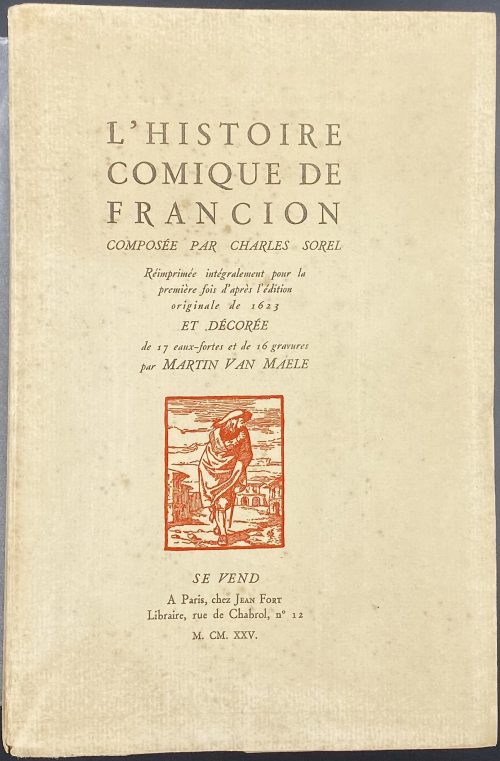 Description: One volume in cream French flapped wrappers, collated 8vo, 22.5 x 14.8 cm, lettered to front (device in red), printed on wove paper, margins untrimmed, some pages uncut, illustrated with tail- and headpieces and 17 sets of plates (4 of each plate) with tissue guards, after Martin van Maele. Front wrapper (red and black): L'HISTOIRE | COMIQUE DE | FRANCION | COMPOSÉE PAR CHARLES SOREL | Réimprimée intégralement pour la | première fois d'après l'édition | originale de 1623 | ET DÉCORÉE | de 17 eaux-fortes et de 16 gravures | par MARTIN VAN MAELE | {device} | SE VEND | A Paris, chez Jean Fort | Libraire, rue de Chabrol, no 12 | M. CM. XXV. || Title-page (red and black): L'HISTOIRE | COMIQUE DE | FRANCION | En laquelle sont découvertes les plus subtiles | finesses et trompeuses inventions tant des hommes | que des femmes de toutes sortes de conditions et | d’âges. Non moins profitable pour s’en | garder, que plaisante à la lecture. | Nouvelle édition conforme à | l’édition princeps de 1623, et | ornée de 17 eaux-fortes et | de 16 compositions par | MARTIN VAN MAELE | {device} | A PARIS | Chez Jean Fort, libraire, | Rue de Chabrol, no 12 | M. CM. XXV. || Collation: π3 (blank, h.t., t.p.), 1-268 χ3 (colophon, 2 blanks), total 214 leaves plus 17 sets of plates (4 of each). Pagination: [6] i-v [vi], 1-411 [412] [4], total 428 pages, ils. Illustrations: 16 tail- and headpieces, and one full-page vignette etched after drawings by Martin van Maële; 17 gravures coloured à la poupée after van Maële’s watercolours, each accompanied with three b/w plates in a different state of the same, incl. frontispiece; unpaginated. Limitation: The run of 1,203 copies printed on October 2, 1925, by Maurice Darantiere in Dijon; 1 copy (№ 1) on Japon Impérial is unique with the original drawings and three additional suites of plates; 10 copies (2-11) on Japon Impérial with three additional suites of plates; 31 copies (12-42) on Hollande with two additional suites of plates; 61 copies (43-103) on Madagascar with one additional suite of plates; 1,100 copies (104-1203) on Enoshima. This copy is № 10 on Japon Impérial with three additional suites of plates. Catalogue raisonné: S. A. Perry (2015) № 28, p. 31. Contributors: Charles Sorel, sieur de Souvigny (French, c. 1602 – 1674) – author Maurice François Alfred Martin van Maële [Martin van Maële] (French, 1863 – 1926) – artist. Maurice Darantiere (French, 1882 – 1962) – printer. Jean-Marie Fort (French, 20th century) – publisher.
Description: One volume in cream French flapped wrappers, collated 8vo, 22.5 x 14.8 cm, lettered to front (device in red), printed on wove paper, margins untrimmed, some pages uncut, illustrated with tail- and headpieces and 17 sets of plates (4 of each plate) with tissue guards, after Martin van Maele. Front wrapper (red and black): L'HISTOIRE | COMIQUE DE | FRANCION | COMPOSÉE PAR CHARLES SOREL | Réimprimée intégralement pour la | première fois d'après l'édition | originale de 1623 | ET DÉCORÉE | de 17 eaux-fortes et de 16 gravures | par MARTIN VAN MAELE | {device} | SE VEND | A Paris, chez Jean Fort | Libraire, rue de Chabrol, no 12 | M. CM. XXV. || Title-page (red and black): L'HISTOIRE | COMIQUE DE | FRANCION | En laquelle sont découvertes les plus subtiles | finesses et trompeuses inventions tant des hommes | que des femmes de toutes sortes de conditions et | d’âges. Non moins profitable pour s’en | garder, que plaisante à la lecture. | Nouvelle édition conforme à | l’édition princeps de 1623, et | ornée de 17 eaux-fortes et | de 16 compositions par | MARTIN VAN MAELE | {device} | A PARIS | Chez Jean Fort, libraire, | Rue de Chabrol, no 12 | M. CM. XXV. || Collation: π3 (blank, h.t., t.p.), 1-268 χ3 (colophon, 2 blanks), total 214 leaves plus 17 sets of plates (4 of each). Pagination: [6] i-v [vi], 1-411 [412] [4], total 428 pages, ils. Illustrations: 16 tail- and headpieces, and one full-page vignette etched after drawings by Martin van Maële; 17 gravures coloured à la poupée after van Maële’s watercolours, each accompanied with three b/w plates in a different state of the same, incl. frontispiece; unpaginated. Limitation: The run of 1,203 copies printed on October 2, 1925, by Maurice Darantiere in Dijon; 1 copy (№ 1) on Japon Impérial is unique with the original drawings and three additional suites of plates; 10 copies (2-11) on Japon Impérial with three additional suites of plates; 31 copies (12-42) on Hollande with two additional suites of plates; 61 copies (43-103) on Madagascar with one additional suite of plates; 1,100 copies (104-1203) on Enoshima. This copy is № 10 on Japon Impérial with three additional suites of plates. Catalogue raisonné: S. A. Perry (2015) № 28, p. 31. Contributors: Charles Sorel, sieur de Souvigny (French, c. 1602 – 1674) – author Maurice François Alfred Martin van Maële [Martin van Maële] (French, 1863 – 1926) – artist. Maurice Darantiere (French, 1882 – 1962) – printer. Jean-Marie Fort (French, 20th century) – publisher. -
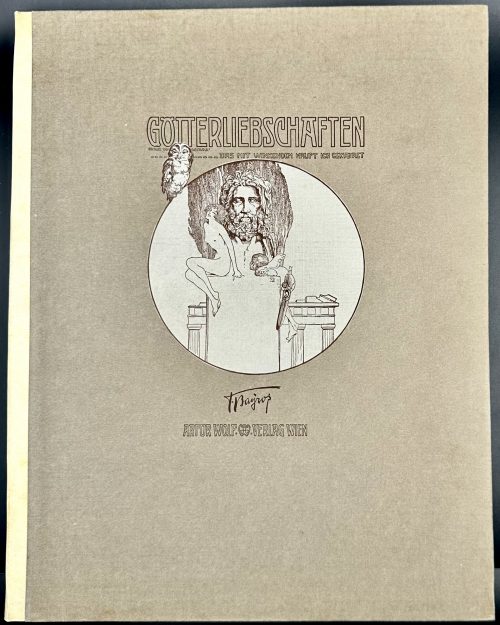 Letterpress title-page, engraved title-page, and 10 sheets of collotype plates printed on india paper mounted on thick wove paper, with captioned guard sheets, loose in a vellum-backed cardboard portfolio with cloth-mounted flaps; floral diaper design inside throughout; bookseller's label to front board verso; limited edition of 550 copies of which this is copy № 103. Dimensions: 338 x 268 mm portfolio; 325 x 260 mm sheet, 225 x 195 mm image. Front board with lettering and vignette: GÖTTERLIEBSCHAFTEN | DAS MIT WINKENDEM HAUPT ICH GEWAHRET | {vignette} | {signature} | ARTUR WOLF / VERLAG WIEN || Letterpress title-page: FRANZ VON BAYROS | “GÖTTERLIEBSCHAFTEN” | ARTUR WOLF / VERLAG WIEN | 1914 || Verso to letterpress t.p. VERZEICHNIS DER TAFELN.
Letterpress title-page, engraved title-page, and 10 sheets of collotype plates printed on india paper mounted on thick wove paper, with captioned guard sheets, loose in a vellum-backed cardboard portfolio with cloth-mounted flaps; floral diaper design inside throughout; bookseller's label to front board verso; limited edition of 550 copies of which this is copy № 103. Dimensions: 338 x 268 mm portfolio; 325 x 260 mm sheet, 225 x 195 mm image. Front board with lettering and vignette: GÖTTERLIEBSCHAFTEN | DAS MIT WINKENDEM HAUPT ICH GEWAHRET | {vignette} | {signature} | ARTUR WOLF / VERLAG WIEN || Letterpress title-page: FRANZ VON BAYROS | “GÖTTERLIEBSCHAFTEN” | ARTUR WOLF / VERLAG WIEN | 1914 || Verso to letterpress t.p. VERZEICHNIS DER TAFELN.- Europa und der Stier
- Leda und die Schildkröte
- Sterope und Herkules
- Herodikos und die Turnerinnen
- Phoroneus und die Hirtin
- Minos und Persipeia
- Phryne und Mutter
- Pytalos und Demeter
- Kirke und die Ferkel
- Putiphar
-
![Гроций. О праве войны и мира // Общедоступная философия в изложении Аркадия Пресса. - СПб.: П. П. Сойкин, [1902].](https://varshavskycollection.com/wp-content/uploads/2021/02/LIB-0905.2015-3-500x781.jpeg) Front wrapper, t.p.: Общедоступная философiя | ВЪ ИЗЛОЖЕНИИ | АРКАДIЯ ПРЕССА | — | ГРОЦIЙ. | О ПРАВѢ ВОЙНЫ И МИРА. | Цена 40 коп. | [two medals] С.-Петербург | Изданiе П. П. Сойкина [two medals] | Книжный Складъ / Стремянная, 12 | Книжный Магазинъ / Невский, 96 || Verso to front wrapper: publisher's advert.; verso to back wrapper: publisher's advert.; back wrapper: Series advert. Series: Общедоступная философия в изложении Аркадия Пресса Pagination: [1, 2] – t.p. /censor's approval dated September 30, 1902 г., imprint, [3] 4-50 [2] – publisher's advert. Collation: 8vo; [1]8 2-38 42. Inscriptions: Handwriting to front wrapper "1902"; to title page "1902" and in Russian: "Ензику от Тышки 19/III-26г." Size: 19.5 x 12.3 cm. Binding: original publisher's wrappers, lettering, pp. 35-46 loose. Author: Hugo Grotius [Huig or Hugo de Groot] (Dutch, 1583 – 1645). Originally published by Nicolas Buon in Paris in 1625 in Latin under the title: De iure belli ac pacis (English: On the Law of War and Peace). Compiler/translator: Аркадий Германович Пресс [Аркадиус Пресас or Arkadius Presas] (Russian-Finish, 1870 – 1952).
Front wrapper, t.p.: Общедоступная философiя | ВЪ ИЗЛОЖЕНИИ | АРКАДIЯ ПРЕССА | — | ГРОЦIЙ. | О ПРАВѢ ВОЙНЫ И МИРА. | Цена 40 коп. | [two medals] С.-Петербург | Изданiе П. П. Сойкина [two medals] | Книжный Складъ / Стремянная, 12 | Книжный Магазинъ / Невский, 96 || Verso to front wrapper: publisher's advert.; verso to back wrapper: publisher's advert.; back wrapper: Series advert. Series: Общедоступная философия в изложении Аркадия Пресса Pagination: [1, 2] – t.p. /censor's approval dated September 30, 1902 г., imprint, [3] 4-50 [2] – publisher's advert. Collation: 8vo; [1]8 2-38 42. Inscriptions: Handwriting to front wrapper "1902"; to title page "1902" and in Russian: "Ензику от Тышки 19/III-26г." Size: 19.5 x 12.3 cm. Binding: original publisher's wrappers, lettering, pp. 35-46 loose. Author: Hugo Grotius [Huig or Hugo de Groot] (Dutch, 1583 – 1645). Originally published by Nicolas Buon in Paris in 1625 in Latin under the title: De iure belli ac pacis (English: On the Law of War and Peace). Compiler/translator: Аркадий Германович Пресс [Аркадиус Пресас or Arkadius Presas] (Russian-Finish, 1870 – 1952). -
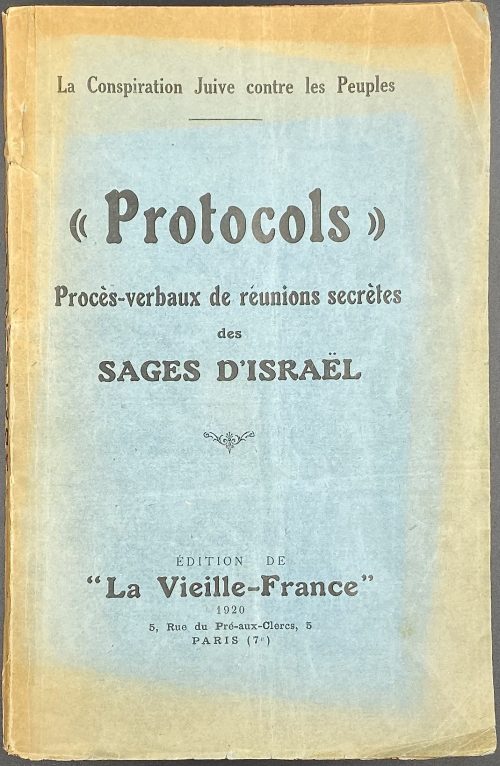 Cover: La Conspiration Juive contre les Peuples | « Protocols » | Procès-verbaux de réunions secrètes | des | SAGES D'ISRAËL | ÉDITION DE | “La Vieille-France” | 1920 | 5Rue du Pré-aux-Clercs, 5 | PARIS (7e) || Title: « Protocols » | Procès-verbaux de réunions secrètes | des | SAGES D'ISRAËL | ÉDITION DE | “La Vieille-France” | 1920 | 5Rue du Pré-aux-Clercs, 5 | PARIS (7e) || Pagination: [1, 2] – t.p. / blank, 3-141 [142 blank] [2] – table / blank. Pp.: 1-11 – Introduction; 13-82 – Protocols; 97-141 – Le Bolchevisme, c’est les Juifs. Collation : 8vo; [1]8 2-98. Binding: Publisher’s blue black-lettered wrappers, lettered spine. Printer: Imprimerie Chantenay (Paris). The French translation of "Протоколы синоских мудрецов" written in Russian by Сергей Нилус (Sergei Nilus, 1862 – 1929) was published in “La Vieille-France” by Urbain Gohier (1862 – 1951). Inside front wrapper: "Brave French! Please note that the format of this book allows you to hide it in your pockets. Your Jewish masters strictly forbid you to read it. Its existence is hidden in every possible way by the Jewish-controlled press. But fear not! While carefully hiding it, read carefully about what your Jewish masters forbid the newspapers to tell you. And you will understand – who and how will take your homeland away from you."
Cover: La Conspiration Juive contre les Peuples | « Protocols » | Procès-verbaux de réunions secrètes | des | SAGES D'ISRAËL | ÉDITION DE | “La Vieille-France” | 1920 | 5Rue du Pré-aux-Clercs, 5 | PARIS (7e) || Title: « Protocols » | Procès-verbaux de réunions secrètes | des | SAGES D'ISRAËL | ÉDITION DE | “La Vieille-France” | 1920 | 5Rue du Pré-aux-Clercs, 5 | PARIS (7e) || Pagination: [1, 2] – t.p. / blank, 3-141 [142 blank] [2] – table / blank. Pp.: 1-11 – Introduction; 13-82 – Protocols; 97-141 – Le Bolchevisme, c’est les Juifs. Collation : 8vo; [1]8 2-98. Binding: Publisher’s blue black-lettered wrappers, lettered spine. Printer: Imprimerie Chantenay (Paris). The French translation of "Протоколы синоских мудрецов" written in Russian by Сергей Нилус (Sergei Nilus, 1862 – 1929) was published in “La Vieille-France” by Urbain Gohier (1862 – 1951). Inside front wrapper: "Brave French! Please note that the format of this book allows you to hide it in your pockets. Your Jewish masters strictly forbid you to read it. Its existence is hidden in every possible way by the Jewish-controlled press. But fear not! While carefully hiding it, read carefully about what your Jewish masters forbid the newspapers to tell you. And you will understand – who and how will take your homeland away from you." -
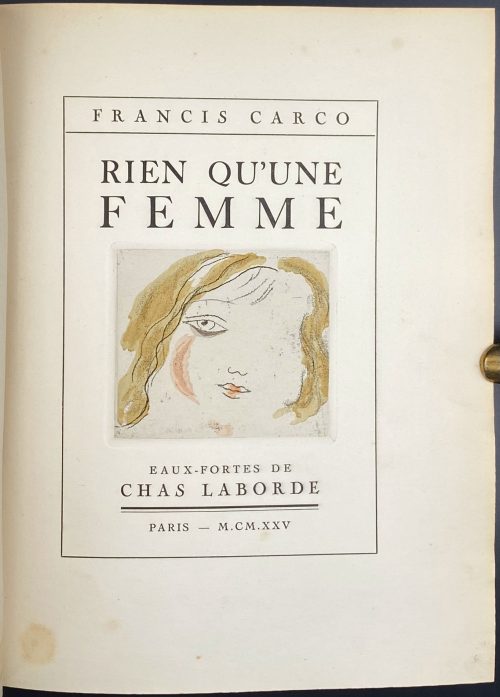 Title-page (text in frame): FRANCIS CARCO | RIEN QU'UNE | FEMME | {vignette} | EAUX-FORTES DE | CHAS LABORDE | — | PARIS — M.CM.XXV || Description: 4to, 24.5 x 20 cm, owner’s red cloth, yellow leather label with gilt lettering to spine, original wrappers bound in, woodcut bookplate “ИЗ КНИГ Ф.РОЖАНКОВСКАГО” to front pastedown; chapter titles and initials printed in pink. Collation: fep, 2 blanks before front wrapper, front wrapper with a black lettered pink label, 2 blanks, h.t., t.p., dedication, 1-204 212,2 blanks, rear wrapper, 2 blanks, rep; total 89 leaves within wrappers, plus 15 plates with tissue guards, incl. frontispiece – hand-coloured etchings by Chas [Charles] Laborde, extraneous to collation. In some copies, there are two additional plates. Pagination: [10] [1] 2-162 [2 colophon/blank] [4], total 178 pages. Limitation: Date of printing: September 15, 1925. Printer: Imprimeur Coulouma (Argenteuil) Print run: 267 copies of which 1 copy on Japon Ancien (№1), 15 on Japon Impérial (№№ 2-16), 60 on Hollande (№№ 17-76), and 200 copies on Vélin de Rives (№№ 77-276) ; this is copy № 82. Etchings printed on BFK Rives paper (embossed). Provenance: Rojankovsky, Feodor [Rojan; Рожанковский, Фёдор Степанович] (Russian-American, 1891 – 1970). Contributors: Francis Carco [François Carcopino-Tusoli] (French, 1886 – 1958) – author. Chas Laborde [Charles Laborde] (French, 1886 – 1941) – artist. Roger Lacourière (French, 1892 – 1966) – engraver.
Title-page (text in frame): FRANCIS CARCO | RIEN QU'UNE | FEMME | {vignette} | EAUX-FORTES DE | CHAS LABORDE | — | PARIS — M.CM.XXV || Description: 4to, 24.5 x 20 cm, owner’s red cloth, yellow leather label with gilt lettering to spine, original wrappers bound in, woodcut bookplate “ИЗ КНИГ Ф.РОЖАНКОВСКАГО” to front pastedown; chapter titles and initials printed in pink. Collation: fep, 2 blanks before front wrapper, front wrapper with a black lettered pink label, 2 blanks, h.t., t.p., dedication, 1-204 212,2 blanks, rear wrapper, 2 blanks, rep; total 89 leaves within wrappers, plus 15 plates with tissue guards, incl. frontispiece – hand-coloured etchings by Chas [Charles] Laborde, extraneous to collation. In some copies, there are two additional plates. Pagination: [10] [1] 2-162 [2 colophon/blank] [4], total 178 pages. Limitation: Date of printing: September 15, 1925. Printer: Imprimeur Coulouma (Argenteuil) Print run: 267 copies of which 1 copy on Japon Ancien (№1), 15 on Japon Impérial (№№ 2-16), 60 on Hollande (№№ 17-76), and 200 copies on Vélin de Rives (№№ 77-276) ; this is copy № 82. Etchings printed on BFK Rives paper (embossed). Provenance: Rojankovsky, Feodor [Rojan; Рожанковский, Фёдор Степанович] (Russian-American, 1891 – 1970). Contributors: Francis Carco [François Carcopino-Tusoli] (French, 1886 – 1958) – author. Chas Laborde [Charles Laborde] (French, 1886 – 1941) – artist. Roger Lacourière (French, 1892 – 1966) – engraver. -
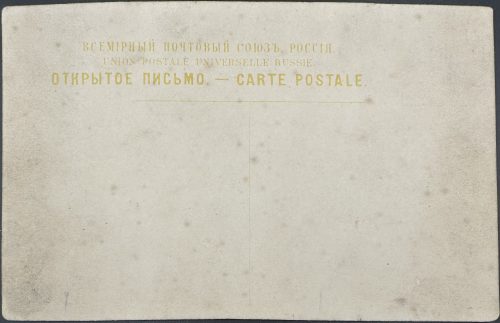 Ten postcards 90 x 140 mm, text in yellow "ВСЕМIРНЫЙ ПОЧТОВЫЙ СОЮЗЪ. РОССIЯ. | UNION POSTALE UNIVERSELLE RUSSIE. | ОТКРЫТОЕ ПИСЬМО. — CARTE POSTALE. || On the reverse, a blue ink woodcut image is printed in the upper left corner, and a идгу штл inscription is in the bottom centre. Holding the postcard against the backlight reveals a hidden image of an indecent nature (erotic). The use of Latin characters "R" and "N" instead of Russian "Р" and "Н" suggests that the cards were produced in Europe, probably in France. Inscriptions: 1. ПЕRВЫЕ ДNИ; 2. ПОRА ЛЮБВИ; 3. ВЪ ЛЮДИ; 4. КЪ "СВОБОДNОМУ ИСКУССТВУ"; 5. "СВОБОДNЫЙ ТRУДЪ; 6. БЕЗЪ ГОRЯ И ПЕЧАЛИ; 7. NАЗАДЪ КЪ "СВОБОДNОЙ ЛЮБВИ"; 8. ВСЕ ЧТО ОСТАЛОСЬ!; 9. БЕЗЪ КRОВА И ПRИСТАNИЩА; 10. ИЗЪ ЗА ХЛѢБА.
Ten postcards 90 x 140 mm, text in yellow "ВСЕМIРНЫЙ ПОЧТОВЫЙ СОЮЗЪ. РОССIЯ. | UNION POSTALE UNIVERSELLE RUSSIE. | ОТКРЫТОЕ ПИСЬМО. — CARTE POSTALE. || On the reverse, a blue ink woodcut image is printed in the upper left corner, and a идгу штл inscription is in the bottom centre. Holding the postcard against the backlight reveals a hidden image of an indecent nature (erotic). The use of Latin characters "R" and "N" instead of Russian "Р" and "Н" suggests that the cards were produced in Europe, probably in France. Inscriptions: 1. ПЕRВЫЕ ДNИ; 2. ПОRА ЛЮБВИ; 3. ВЪ ЛЮДИ; 4. КЪ "СВОБОДNОМУ ИСКУССТВУ"; 5. "СВОБОДNЫЙ ТRУДЪ; 6. БЕЗЪ ГОRЯ И ПЕЧАЛИ; 7. NАЗАДЪ КЪ "СВОБОДNОЙ ЛЮБВИ"; 8. ВСЕ ЧТО ОСТАЛОСЬ!; 9. БЕЗЪ КRОВА И ПRИСТАNИЩА; 10. ИЗЪ ЗА ХЛѢБА. -
![Giacomo Casanova. Erinnerungen aus galanter Zeit / mit Bildern von F. v. Bayros. Eingeleitet von Hanns Heinz Ewers. – Berlin: Wilhelm Borngräber, 1916. – ffl, 2 - cit., advert.] [1-4] 5-557 [558] [2 - table+illustr., printer], bfl.], frontis, and 5 plates.](https://varshavskycollection.com/wp-content/uploads/2021/02/LIB-2512.2020-a-500x712.jpeg) Front board: CASANOVA | Erinnerungen aus | galanter Zeit | Illustriert von | F.v. Bayros | {gigniette} | BERLIN | Verlegt bei Wilhelm Borngräber || Title: Giacomo Casanova | Erinnerungen aus galanter Zeit | Mit Bildern von F.v. Bayros | Eingeleitet von | Hanns Heinz Ewers | 66. Bis 70 Tausend | — | Wilhelm Borngräber Verlag | Berlin || Pagination: [2] , [1-4] 5-557 [558] [2] + frontispice + 5 plates (photogravures). Collation: 8vo; [1]8 2-358. Size: 18.8 x 13 x 4.3 cm Binding: hardcover, quarter cloth, paper boards with vignette and lettering, gilt lettering to spine. Note: the year and the edition were not stated and could not be inferred so far, probably one of the early editions between 1911 and 1925.
Front board: CASANOVA | Erinnerungen aus | galanter Zeit | Illustriert von | F.v. Bayros | {gigniette} | BERLIN | Verlegt bei Wilhelm Borngräber || Title: Giacomo Casanova | Erinnerungen aus galanter Zeit | Mit Bildern von F.v. Bayros | Eingeleitet von | Hanns Heinz Ewers | 66. Bis 70 Tausend | — | Wilhelm Borngräber Verlag | Berlin || Pagination: [2] , [1-4] 5-557 [558] [2] + frontispice + 5 plates (photogravures). Collation: 8vo; [1]8 2-358. Size: 18.8 x 13 x 4.3 cm Binding: hardcover, quarter cloth, paper boards with vignette and lettering, gilt lettering to spine. Note: the year and the edition were not stated and could not be inferred so far, probably one of the early editions between 1911 and 1925. -
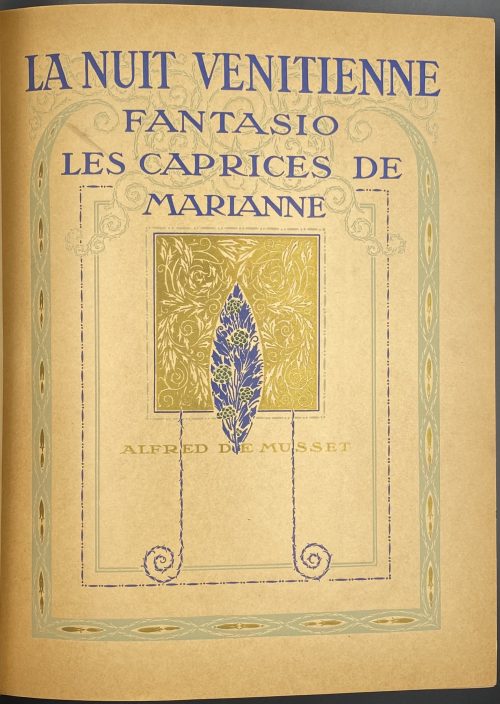 Collation: Prelims (pp.1-6): Blank leaf, front wrapper (ornamental, gilt and colour): LA NUIT VENITIENNE | FANTASIO | LES CAPRICES DE | MARIANNE | ALFRED DE MUSSET ||, blank leaf, [2] – h.t.: LA | NUIT VENITIENNE ||, [2] – t.p. (ornamental frame, marigold and reseda green): ALFRED DE MUSSET | LA NUIT | VENITIENNE | FANTASIA | LES CAPRICES | DE MARIANNE | ILLUSTRATIONS | DE | U. BRUNELLESCHI | L’EDITION D’ART H.PIAZZA | PARIS ||, [2] – ornamental divisional title: LA NUIT VENITIENNE ||, 7-138 [139/40] – contents / list of ills., [141-2] – limitation / colophon, blank leaf, back wrapper, blank leaf; plus 20 stencil-coloured (au pochoir) plates after gouaches by Umberto Brunelleschi, incl. frontispiece with red-lettered tissue guards; two more divisional titles, three headpieces in black; text printed on heavy wove paper, in an ornamental frame. Edition: 1st; limited to 500 copies on laid paper (papier du Japon) signed by the artist; this copy on wove paper without signatures, without limitation. Printed in Paris on the 10th of November 1913. Binding: 30 x 24 cm, owner’s green bead-grain buckram with a gilt-lettered black label to spine LA NUIT | VENITIENNE, publisher’s wrappers bound in, green and gilt endpapers. Alfred de Musset (French, 1810 – 1857) – author. Umberto Brunelleschi (Italian, 1879 – 1949) – artist. L’Edition d’art H. Piazza; Henri Jules Piazza (Italian, 1861 – 1929) – publisher, printer.
Collation: Prelims (pp.1-6): Blank leaf, front wrapper (ornamental, gilt and colour): LA NUIT VENITIENNE | FANTASIO | LES CAPRICES DE | MARIANNE | ALFRED DE MUSSET ||, blank leaf, [2] – h.t.: LA | NUIT VENITIENNE ||, [2] – t.p. (ornamental frame, marigold and reseda green): ALFRED DE MUSSET | LA NUIT | VENITIENNE | FANTASIA | LES CAPRICES | DE MARIANNE | ILLUSTRATIONS | DE | U. BRUNELLESCHI | L’EDITION D’ART H.PIAZZA | PARIS ||, [2] – ornamental divisional title: LA NUIT VENITIENNE ||, 7-138 [139/40] – contents / list of ills., [141-2] – limitation / colophon, blank leaf, back wrapper, blank leaf; plus 20 stencil-coloured (au pochoir) plates after gouaches by Umberto Brunelleschi, incl. frontispiece with red-lettered tissue guards; two more divisional titles, three headpieces in black; text printed on heavy wove paper, in an ornamental frame. Edition: 1st; limited to 500 copies on laid paper (papier du Japon) signed by the artist; this copy on wove paper without signatures, without limitation. Printed in Paris on the 10th of November 1913. Binding: 30 x 24 cm, owner’s green bead-grain buckram with a gilt-lettered black label to spine LA NUIT | VENITIENNE, publisher’s wrappers bound in, green and gilt endpapers. Alfred de Musset (French, 1810 – 1857) – author. Umberto Brunelleschi (Italian, 1879 – 1949) – artist. L’Edition d’art H. Piazza; Henri Jules Piazza (Italian, 1861 – 1929) – publisher, printer. -
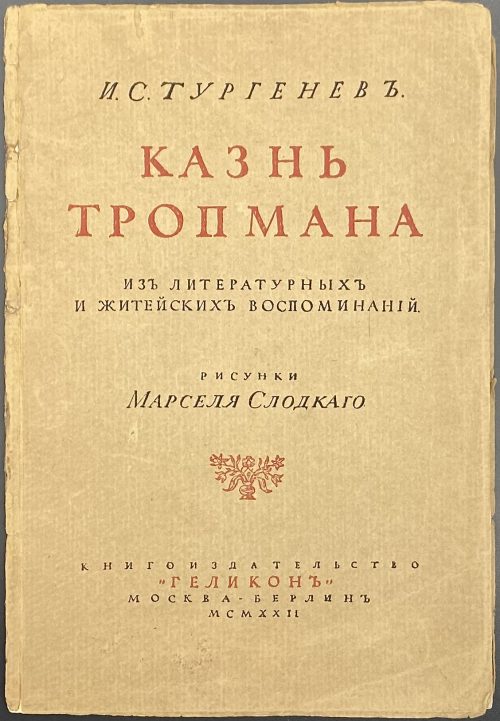 Paperback brochure, 22.6 x 16 cm, brown wrappers, lettered in red and black: И. С. ТУРГЕНЕВЪ. | КАЗНЬ | ТРОПМАНА | ИЗЪ ЛИТЕРАТУРНЫХЪ | И ЖИТЕЙСКИХЪ ВОСПОМИНАНIЙ. | РИСУНКИ | Марселя Слодкаго | {fleuron} | КНИГОИЗДАТЕЛЬСТВО | «ГЕЛИКОНЪ» | МОСКВА - БЕРЛИНЪ | MCMXXII ||; 8 full-page, incl. frontispiece, and 5 smaller vignettes after Marcel Slodki, within pagination. Title-page: И. С. ТУРГЕНЕВЪ. | КАЗНЬ | ТРОПМАНА | ИЗЪ ЛИТЕРАТУРНЫХЪ | И ЖИТЕЙСКИХЪ ВОСПОМИНАНIЙ | Рисунки | МАРСЕЛЯ СЛОДКАГО. | Книгоиздательство | “ГЕЛИКОНЪ” | МОСКВА - БЕРЛИНЪ | MCMXXII || Imprint: Эта книга отпечатана въ типографiи Sinaburg & Co., G.m.b.H. | Berlin для книгоиздательства “Геликонъ” в декабрѣ | 1921 г. Клише работы Römmler & Jonas, Dresden. || Pagination: [4] blanks, [2] publisher’s device / imprint, [2] blank / frontis. (Turgenev’s portrait), [2] t.p. / blank, [2] f.t. / blank, 11-57 [58] text, [4] blanks. Contributors: Иван Сергеевич Тургенев [Ivan Turgenev] (Russian, 1818 – 1883) – author. Марсель Слодкий [Marcel Slodki] (Jewish-Ukrainian, 1892 – 1944) – artist Jean-Baptiste Troppmann (French, 1849 – 1870) – character.
Paperback brochure, 22.6 x 16 cm, brown wrappers, lettered in red and black: И. С. ТУРГЕНЕВЪ. | КАЗНЬ | ТРОПМАНА | ИЗЪ ЛИТЕРАТУРНЫХЪ | И ЖИТЕЙСКИХЪ ВОСПОМИНАНIЙ. | РИСУНКИ | Марселя Слодкаго | {fleuron} | КНИГОИЗДАТЕЛЬСТВО | «ГЕЛИКОНЪ» | МОСКВА - БЕРЛИНЪ | MCMXXII ||; 8 full-page, incl. frontispiece, and 5 smaller vignettes after Marcel Slodki, within pagination. Title-page: И. С. ТУРГЕНЕВЪ. | КАЗНЬ | ТРОПМАНА | ИЗЪ ЛИТЕРАТУРНЫХЪ | И ЖИТЕЙСКИХЪ ВОСПОМИНАНIЙ | Рисунки | МАРСЕЛЯ СЛОДКАГО. | Книгоиздательство | “ГЕЛИКОНЪ” | МОСКВА - БЕРЛИНЪ | MCMXXII || Imprint: Эта книга отпечатана въ типографiи Sinaburg & Co., G.m.b.H. | Berlin для книгоиздательства “Геликонъ” в декабрѣ | 1921 г. Клише работы Römmler & Jonas, Dresden. || Pagination: [4] blanks, [2] publisher’s device / imprint, [2] blank / frontis. (Turgenev’s portrait), [2] t.p. / blank, [2] f.t. / blank, 11-57 [58] text, [4] blanks. Contributors: Иван Сергеевич Тургенев [Ivan Turgenev] (Russian, 1818 – 1883) – author. Марсель Слодкий [Marcel Slodki] (Jewish-Ukrainian, 1892 – 1944) – artist Jean-Baptiste Troppmann (French, 1849 – 1870) – character. -
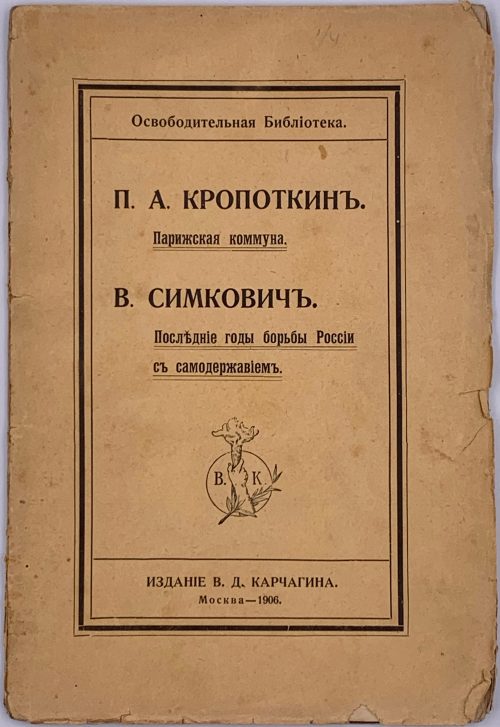 Cover and title page: Освободительная библiотека. | П. А. КРОПОТКИНЪ. | Парижская коммуна | В. СИМКОВИЧЪ | Послѣдние годы борьбы Россiи | съ самодержавiемъ | {publisher’s device} | ИЗДАНIЕ В. Д. КАРЧАГИНА. | Москва—1906. || Publisher’s lettered wrappers, pagination: [1-5] 6-83 [84], collation: 8vo, [1]8 2-58 62; size: 10.5 x 14 cm. Contents: П. А. Кропоткин. Парижская коммуна / Пер. Т. Брона — pp. 3-31; В. Симкович. Последнии годы борьбы России с самодержавием / Пер. Л. П. Данилова — pp. 33- 83. Kropotkin, Pyotr Alexeyevich [Кропоткин, Пётр Алексеевич] (Russian, 1842 – 1921) — author of the text. Simkhovitch, Vladimir Gregorievitch [Симкович, В.] (Russian-American, 1874 – 1959) — author of the text. Кушнерёв, Иван Николаевич (Russian, 1827 – 1896) — printer.
Cover and title page: Освободительная библiотека. | П. А. КРОПОТКИНЪ. | Парижская коммуна | В. СИМКОВИЧЪ | Послѣдние годы борьбы Россiи | съ самодержавiемъ | {publisher’s device} | ИЗДАНIЕ В. Д. КАРЧАГИНА. | Москва—1906. || Publisher’s lettered wrappers, pagination: [1-5] 6-83 [84], collation: 8vo, [1]8 2-58 62; size: 10.5 x 14 cm. Contents: П. А. Кропоткин. Парижская коммуна / Пер. Т. Брона — pp. 3-31; В. Симкович. Последнии годы борьбы России с самодержавием / Пер. Л. П. Данилова — pp. 33- 83. Kropotkin, Pyotr Alexeyevich [Кропоткин, Пётр Алексеевич] (Russian, 1842 – 1921) — author of the text. Simkhovitch, Vladimir Gregorievitch [Симкович, В.] (Russian-American, 1874 – 1959) — author of the text. Кушнерёв, Иван Николаевич (Russian, 1827 – 1896) — printer. -
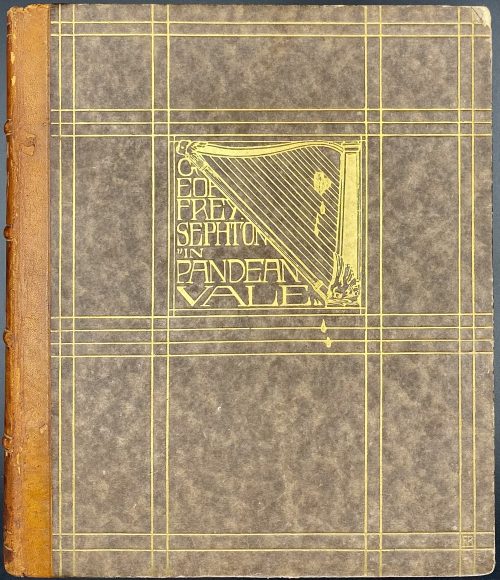 Description: one volume 25.5 x 22 cm, quarter calf with raised bands and gilt lettering over gilt-decorated boards, text within decorated borders printed on wove paper, with 8 mounted colour plates, 16 x 14 cm, photomechanical reproductions after Franz von Bayros, with lettered tissue guards, t.e.g. Title-page (in decorated border): INPANDEANVALE | PICTURED {} IN COLOUR | BY THE MAR {} QUIS F.BAYROS {vignette} | AMALTHEA PUBLISHING OFFICEZURICH || Pagination: [2 blank] [1-6] 7-156 [2 blank], total 80 leaves, incl. 8 colour plates with lettered tissue guards. Limitation: Copyright by Amalthea Publishing Office, Vienna. Printed by Adolf Holzhauzen in Vienna. Bound by Karl Scheibe, Vienna. Edition A: №№ I-V, full leather signed by von Bayros; Edition B: №№ 1-495 in half-leather. This copy is № 130, signed by the author. Contributors: Geoffrey Sephton – author, nothing is known. Franz von Bayros (Austrian, 1866 – 1924) – artist. Adolf Holzhausen the Younger (Austrian, 1868 – 1931) – printer. Karl Scheibe (Austrian) – bookbinder.
Description: one volume 25.5 x 22 cm, quarter calf with raised bands and gilt lettering over gilt-decorated boards, text within decorated borders printed on wove paper, with 8 mounted colour plates, 16 x 14 cm, photomechanical reproductions after Franz von Bayros, with lettered tissue guards, t.e.g. Title-page (in decorated border): INPANDEANVALE | PICTURED {} IN COLOUR | BY THE MAR {} QUIS F.BAYROS {vignette} | AMALTHEA PUBLISHING OFFICEZURICH || Pagination: [2 blank] [1-6] 7-156 [2 blank], total 80 leaves, incl. 8 colour plates with lettered tissue guards. Limitation: Copyright by Amalthea Publishing Office, Vienna. Printed by Adolf Holzhauzen in Vienna. Bound by Karl Scheibe, Vienna. Edition A: №№ I-V, full leather signed by von Bayros; Edition B: №№ 1-495 in half-leather. This copy is № 130, signed by the author. Contributors: Geoffrey Sephton – author, nothing is known. Franz von Bayros (Austrian, 1866 – 1924) – artist. Adolf Holzhausen the Younger (Austrian, 1868 – 1931) – printer. Karl Scheibe (Austrian) – bookbinder. -
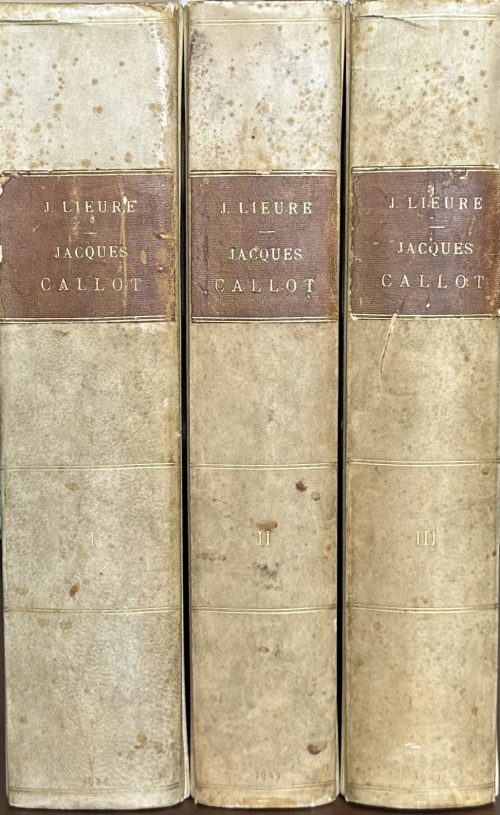 Three volumes, 33 x 26.5 x 7 cm each, uniformly bound in 2/3 vellum over marbled boards, outlined with gilt fillet, brown label with gilt lettering to flat spine with double fillet faux-bands, marbled endpapers, top edge gilt, other untrimmed, publisher’s wrappers preserved, incl. spine; collotype plates with captioned glassine guards; armorial bookplate of Comte Alain de Suzannet to front pastedown in each volume. Two volumes of Première partie, wanting, contain La vie artistique : texte and La vie artistique : planches. Title-page (red and black): JACQUES CALLOT | PAR | J. LIEURE | Introduction de F. Courboin | Conservateur du Cabinet des Estampes à la Bibliothèque Nationale | — | DEUXIÈME PARTIE | CATALOGUE DE L’ŒUVRE GRAVÉ | TOME I (II, III) | — | PARIS | ÉDITIONS DE LA GAZETTE DES BEAUX-ARTS | 106, Boulevard Saint-Germain (6e) | 1924 (1927, 1927) || Vol. 1 (1924): [4] [1] 2-122 [2], wrappers, plates 1-299; printed on September 15, 1924, by André Lesot (Nemours) and D. Jacomet et Cie (Paris). Vol. 2 (1927): [4] [1] 2-106 [2], wrappers, plates 300-652. Vol. 3 (1927): [4] [1] 2-128 [4], wrappers, plates 653-1428; printed on September 5, 1926, by Imprimerie moderne des Beaux-Arts (Bois-Colombes) and D. Jacomet et Cie (Paris). Contributors: Jules Lieure (French, 1866 – 1948) – author. Jacques Callot (French, c. 1592 – 1635) – artist. Gazette des Beaux-Arts (f. 1859) – publisher. François Courboin (French, 1865 – 1926) – author. D. Jacomet et Cie (Paris) – printer. Daniel Jacomet (French, 1894 – 1966) – printer. André Lesot (French, 1874-1951) – printer. Imprimerie moderne des Beaux-Arts (Bois-Colombes) Comte Alain de Suzannet (French, 1882 – 1950) – provenance.
Three volumes, 33 x 26.5 x 7 cm each, uniformly bound in 2/3 vellum over marbled boards, outlined with gilt fillet, brown label with gilt lettering to flat spine with double fillet faux-bands, marbled endpapers, top edge gilt, other untrimmed, publisher’s wrappers preserved, incl. spine; collotype plates with captioned glassine guards; armorial bookplate of Comte Alain de Suzannet to front pastedown in each volume. Two volumes of Première partie, wanting, contain La vie artistique : texte and La vie artistique : planches. Title-page (red and black): JACQUES CALLOT | PAR | J. LIEURE | Introduction de F. Courboin | Conservateur du Cabinet des Estampes à la Bibliothèque Nationale | — | DEUXIÈME PARTIE | CATALOGUE DE L’ŒUVRE GRAVÉ | TOME I (II, III) | — | PARIS | ÉDITIONS DE LA GAZETTE DES BEAUX-ARTS | 106, Boulevard Saint-Germain (6e) | 1924 (1927, 1927) || Vol. 1 (1924): [4] [1] 2-122 [2], wrappers, plates 1-299; printed on September 15, 1924, by André Lesot (Nemours) and D. Jacomet et Cie (Paris). Vol. 2 (1927): [4] [1] 2-106 [2], wrappers, plates 300-652. Vol. 3 (1927): [4] [1] 2-128 [4], wrappers, plates 653-1428; printed on September 5, 1926, by Imprimerie moderne des Beaux-Arts (Bois-Colombes) and D. Jacomet et Cie (Paris). Contributors: Jules Lieure (French, 1866 – 1948) – author. Jacques Callot (French, c. 1592 – 1635) – artist. Gazette des Beaux-Arts (f. 1859) – publisher. François Courboin (French, 1865 – 1926) – author. D. Jacomet et Cie (Paris) – printer. Daniel Jacomet (French, 1894 – 1966) – printer. André Lesot (French, 1874-1951) – printer. Imprimerie moderne des Beaux-Arts (Bois-Colombes) Comte Alain de Suzannet (French, 1882 – 1950) – provenance. -
![Н. Л. [Бутми де Кацман Георгий Васильевич]. Фран-масонство и государственная измена. Издание В. П. — СПб.: тип. газеты "Россiя", 1906. — 77 стр.](https://varshavskycollection.com/wp-content/uploads/2021/02/LIB-0940.2016-a-500x719.jpeg) Cover and title page: Н. Л. | ФРАН-МАСОНСТВО | И | ГОСУДАРСТВЕННАЯ ИЗМѢНА. | Изданiе В. П. | С.-ПЕТЕРБУРГЪ | Типографиiя газеты «Россiя». Бассейная, 3. | 1906 г. || Pagination: [1-3] 4-77 [3]; collation: [1]8 2-58; 23 x 15.5 cm, in publisher’s lettered wrappers, library and bookstore stamps. A reprint of an article published in № 4 of the magazine "Море и его Жизнь", January 1905. Allegedly a translation and a brief exposition of La franc-maçonnerie et la Révolution française by Maurice Talmeyr [Marie-Justin-Maurice Coste] (French, –
Cover and title page: Н. Л. | ФРАН-МАСОНСТВО | И | ГОСУДАРСТВЕННАЯ ИЗМѢНА. | Изданiе В. П. | С.-ПЕТЕРБУРГЪ | Типографиiя газеты «Россiя». Бассейная, 3. | 1906 г. || Pagination: [1-3] 4-77 [3]; collation: [1]8 2-58; 23 x 15.5 cm, in publisher’s lettered wrappers, library and bookstore stamps. A reprint of an article published in № 4 of the magazine "Море и его Жизнь", January 1905. Allegedly a translation and a brief exposition of La franc-maçonnerie et la Révolution française by Maurice Talmeyr [Marie-Justin-Maurice Coste] (French, – -
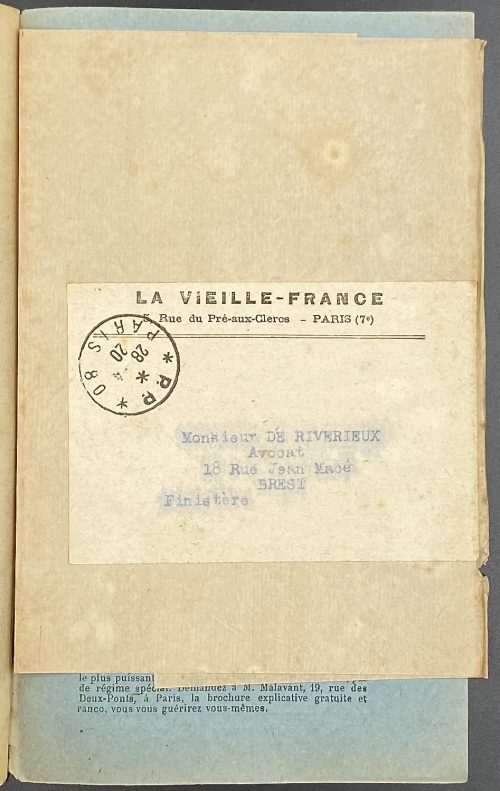 50 issues (full 1920 year) of the French anti-Semitic journal La Vieille France published by Urbain Gohier in Paris from 1916 to 1924. LIB-LIB-2731-1.2021 to LIB-2731-50.2021.
50 issues (full 1920 year) of the French anti-Semitic journal La Vieille France published by Urbain Gohier in Paris from 1916 to 1924. LIB-LIB-2731-1.2021 to LIB-2731-50.2021. -
 Description: Hardcover, 18.8 x 13 cm, pictorial front cover (after Franz von Bayros) in colour over tan cloth, lettering to spine, all margins red, laid paper endpapers, pp.: [4] 1-185 [3]; collated 8vo as π2 1-118, 126, total 192 pages (96 leaves) plus 5 b/w photogravures after drawings by Franz von Bayros. Title-page (blackletter): Gustav Hochstetter | Das Füsschen der gnädigen Frau | und Anderes | {publisher’s device} | {blank} | 1912 | München und Leipzig bei Georg Müller || T.p. verso (blackletter): Umschlagzeichnung und fünf Bildbeigeben von | Franz von Bayros | {blank} | (serif) Copyright 1912 by Georg Müller in München || Colophon: Druck von Mänicke u. Jahn, Rudolstadt. Contributors: Gustav Hochstetter (German-Jewish, 1873 – 1944) – author. Franz von Bayros (Austrian, 1866 – 1924) – artist. Mänicke und Jahn (Rudolstadt) – printer. Georg Müller (München, Leipzig) – publisher.
Description: Hardcover, 18.8 x 13 cm, pictorial front cover (after Franz von Bayros) in colour over tan cloth, lettering to spine, all margins red, laid paper endpapers, pp.: [4] 1-185 [3]; collated 8vo as π2 1-118, 126, total 192 pages (96 leaves) plus 5 b/w photogravures after drawings by Franz von Bayros. Title-page (blackletter): Gustav Hochstetter | Das Füsschen der gnädigen Frau | und Anderes | {publisher’s device} | {blank} | 1912 | München und Leipzig bei Georg Müller || T.p. verso (blackletter): Umschlagzeichnung und fünf Bildbeigeben von | Franz von Bayros | {blank} | (serif) Copyright 1912 by Georg Müller in München || Colophon: Druck von Mänicke u. Jahn, Rudolstadt. Contributors: Gustav Hochstetter (German-Jewish, 1873 – 1944) – author. Franz von Bayros (Austrian, 1866 – 1924) – artist. Mänicke und Jahn (Rudolstadt) – printer. Georg Müller (München, Leipzig) – publisher. -
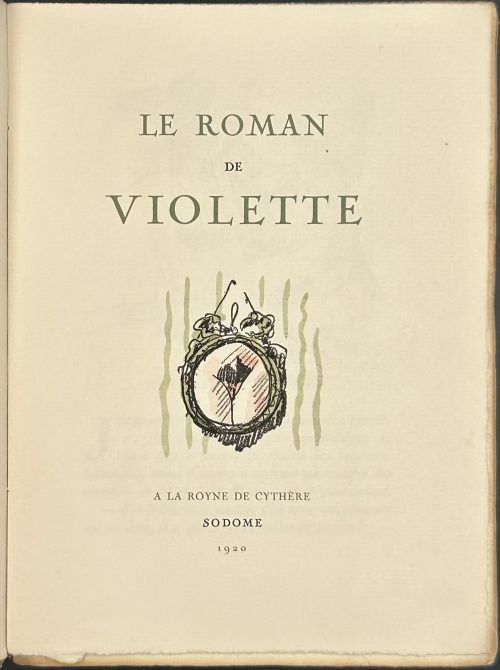 Softcover volume, 19.5 x 14.3 cm, olive French flapped wrappers, glassine dust cover, printed on laid paper (Hollande), outer and bottom margins untrimmed, some pages uncut; pagination: [2] blank, [i-iv] h.t./limit., t.p./blank, v-viii, 1-196 [197] [5], total 212 pages plus frontispiece; head- and tailpieces and in-text stencil-coloured etchings after Chéripoulos. Title-page (olive and black): LE ROMAN | DE | VIOLETTE | {vignette} | A LA ROYNE DE CYTHÈRE | SODOME | 1920 || Limitation: Cet ouvrage, achevé d'imprimer le cinq Janvier Mil Neuf Cent Vingt à trois cents exemplaires dont vingt-cinq exemplaires sur Japon Impérial contenant chacun un dessin original de Chéripoulos, numérotés de un à vingt-cinq; deux cent soixante-quinze exemplaires sur papier de Hollande, numérotés de vingt-six à trois cents; en plus cinq exemplaires de collaborateurs marqués de A à E. Le présent exemplaire porte le numéro 72. Edition: Printed on the 5th of January 1920 in 305 copies (№№ 1-25 on Japon Impérial, №№ 26-300 on Hollande, A–E for collaborators). Catalogue raisonné: Dutel III № 2339, p. 350. Contributors: Henriette de Mannoury d'Ectot [Henriette Nicolas Le Blanc] (French 1815 – 1899) Charles Auguste Edelmann [Chéripoulos] (French, 1879 – 1950).
Softcover volume, 19.5 x 14.3 cm, olive French flapped wrappers, glassine dust cover, printed on laid paper (Hollande), outer and bottom margins untrimmed, some pages uncut; pagination: [2] blank, [i-iv] h.t./limit., t.p./blank, v-viii, 1-196 [197] [5], total 212 pages plus frontispiece; head- and tailpieces and in-text stencil-coloured etchings after Chéripoulos. Title-page (olive and black): LE ROMAN | DE | VIOLETTE | {vignette} | A LA ROYNE DE CYTHÈRE | SODOME | 1920 || Limitation: Cet ouvrage, achevé d'imprimer le cinq Janvier Mil Neuf Cent Vingt à trois cents exemplaires dont vingt-cinq exemplaires sur Japon Impérial contenant chacun un dessin original de Chéripoulos, numérotés de un à vingt-cinq; deux cent soixante-quinze exemplaires sur papier de Hollande, numérotés de vingt-six à trois cents; en plus cinq exemplaires de collaborateurs marqués de A à E. Le présent exemplaire porte le numéro 72. Edition: Printed on the 5th of January 1920 in 305 copies (№№ 1-25 on Japon Impérial, №№ 26-300 on Hollande, A–E for collaborators). Catalogue raisonné: Dutel III № 2339, p. 350. Contributors: Henriette de Mannoury d'Ectot [Henriette Nicolas Le Blanc] (French 1815 – 1899) Charles Auguste Edelmann [Chéripoulos] (French, 1879 – 1950). -
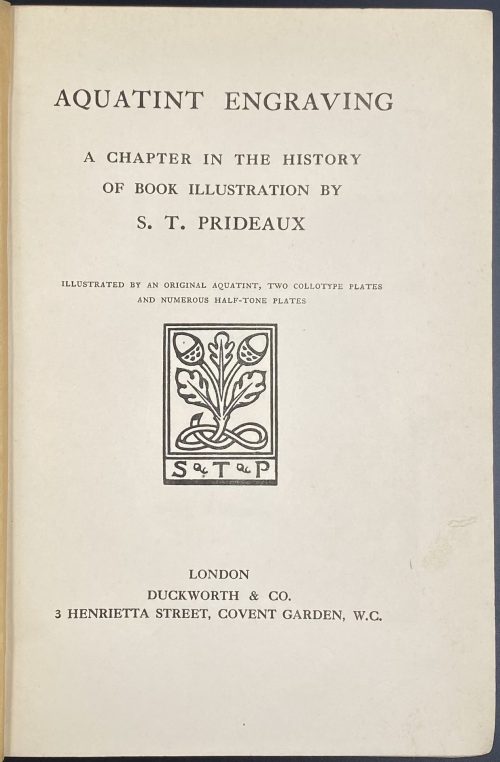 Half-title: AQUATINT ENGRAVING || Title: AQUATINT ENGRAVING | A CHAPTER IN THE HISTORY | OF BOOK ILLUSTRATION BY | S. T. PRIDEAUX | ILLUSTRATED BY AN ORIGINAL AQUATINT, TWO COLLOTYPE PLATES | AND NUMEROUS HALF-TONE PLATES | [Prideaux device] | LONDON | DUCKWORTH & CO. | 3 HENRIETTA STREET, COVENT GARDEN, W.C. || Pagination: ffl, [i, ii] – h.t. / blank, [2] – blank / frontis. w/guard, [iii, iv] – t.p. / coloph. "First Published, December 1909", [v, vi] – dedication "TO MY FATHER" / blank, vii-xv [xvi], [1] 2-434, bfl, + 24 pl. (incl. port). Collation: [a]6 b8 A-Z8 2A-2C8 2D4 Binding: Original navy cloth, gilt-ruled and lettered front board, gilt lettering to spine, a blind device to back board; upper margin gilt, free margin untrimmed. Author: Sarah Prideaux. "Engravers and the books they illustrated": p. 388-405. "Publications by Ackermann with aquatint plates": p. 374-378. "Biographical notices of engravers whose names appear on the plates": p. 358-371. "Books published before 1830 with aquatint plates": p. 325-357.
Half-title: AQUATINT ENGRAVING || Title: AQUATINT ENGRAVING | A CHAPTER IN THE HISTORY | OF BOOK ILLUSTRATION BY | S. T. PRIDEAUX | ILLUSTRATED BY AN ORIGINAL AQUATINT, TWO COLLOTYPE PLATES | AND NUMEROUS HALF-TONE PLATES | [Prideaux device] | LONDON | DUCKWORTH & CO. | 3 HENRIETTA STREET, COVENT GARDEN, W.C. || Pagination: ffl, [i, ii] – h.t. / blank, [2] – blank / frontis. w/guard, [iii, iv] – t.p. / coloph. "First Published, December 1909", [v, vi] – dedication "TO MY FATHER" / blank, vii-xv [xvi], [1] 2-434, bfl, + 24 pl. (incl. port). Collation: [a]6 b8 A-Z8 2A-2C8 2D4 Binding: Original navy cloth, gilt-ruled and lettered front board, gilt lettering to spine, a blind device to back board; upper margin gilt, free margin untrimmed. Author: Sarah Prideaux. "Engravers and the books they illustrated": p. 388-405. "Publications by Ackermann with aquatint plates": p. 374-378. "Biographical notices of engravers whose names appear on the plates": p. 358-371. "Books published before 1830 with aquatint plates": p. 325-357. -
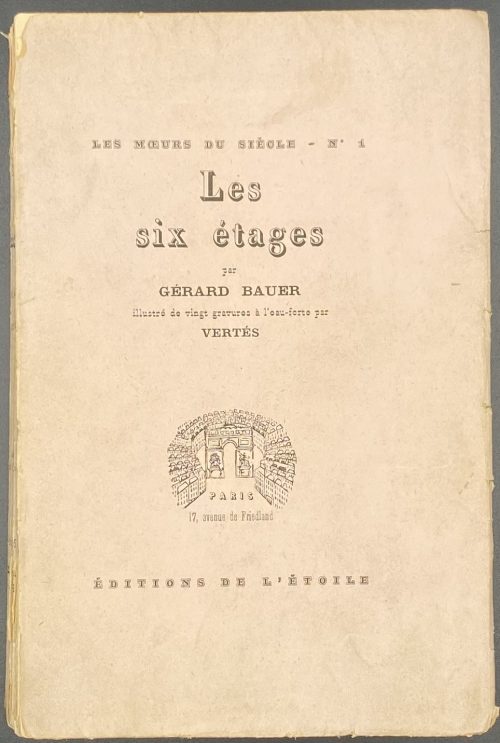 Front wrapper: LES MŒURS DU SIECLE - № 1 | Les | six étages | par | GERARD BAUER | illustré de vingt gravures à l’eau-forte | par VERTÈS | {publisher’s device, “PARIS | 17, avenue de Friedland”} | ÉDITIONS DE L’ÉTOILE || Title-page: essais pour servir a1 l’histoire contemporaine | de la galanterie et du plaisir | I | Les six étages | par | GERARD BAUER | illustré de vingt gravures à l’eau-forte | par VERTÈS | | {publisher’s device, “ÉDITIONS DE L’ÉTOILE | 17, avenue de Friedland”} | PARIS […] MCMXXV || Pagination: front wrapper with lettering, [1-8] incl. 1st bank leaf, h.t. / limitation, t.p. / blank, dedication to Abel Hermant / blank, 9-169 [170] [6] incl. table, colophon, and last blank leaf, 17 etchings by Vertès within pagination; advert. of the other books of the series to the back wrapper. Edition: 15 copies on Japon Impérial (№ 1-15), 35 on Hollande Van Gelder Zonen (№ 16-50), 400 on Vélin de Rives BFK (№ 51-450) and 3 on blue paper not for sale. This copy is № 369. Printed on November 10, 1925 by L. Petitbarat in Saint-Ouen-l’Aumône (text) and by Vernant in Paris (etchings). Edition directed by Roger Allard. Binding: 19 x 12.5 cm, French flapped pink wrappers, lettered to front, back, and spine. Contributors: Gérard Bauër (French, 1888 – 1967) – author. Marcel Vertès [Marcell Vértes] (Jewish-Hungarian-French, 1895 – 1961) – artist. Abel Hermant (French, 1862 – 1950) – dedicatee. Roger Allard (French, 1885 – 1961) – editor. L. Petitbarat (Saint-Ouen-l’Aumône) – printer. Éditions de l’Étoile (Paris) – publisher. Other names: Marcel Vertès, Marcel Vertes, Marcell Vértes
Front wrapper: LES MŒURS DU SIECLE - № 1 | Les | six étages | par | GERARD BAUER | illustré de vingt gravures à l’eau-forte | par VERTÈS | {publisher’s device, “PARIS | 17, avenue de Friedland”} | ÉDITIONS DE L’ÉTOILE || Title-page: essais pour servir a1 l’histoire contemporaine | de la galanterie et du plaisir | I | Les six étages | par | GERARD BAUER | illustré de vingt gravures à l’eau-forte | par VERTÈS | | {publisher’s device, “ÉDITIONS DE L’ÉTOILE | 17, avenue de Friedland”} | PARIS […] MCMXXV || Pagination: front wrapper with lettering, [1-8] incl. 1st bank leaf, h.t. / limitation, t.p. / blank, dedication to Abel Hermant / blank, 9-169 [170] [6] incl. table, colophon, and last blank leaf, 17 etchings by Vertès within pagination; advert. of the other books of the series to the back wrapper. Edition: 15 copies on Japon Impérial (№ 1-15), 35 on Hollande Van Gelder Zonen (№ 16-50), 400 on Vélin de Rives BFK (№ 51-450) and 3 on blue paper not for sale. This copy is № 369. Printed on November 10, 1925 by L. Petitbarat in Saint-Ouen-l’Aumône (text) and by Vernant in Paris (etchings). Edition directed by Roger Allard. Binding: 19 x 12.5 cm, French flapped pink wrappers, lettered to front, back, and spine. Contributors: Gérard Bauër (French, 1888 – 1967) – author. Marcel Vertès [Marcell Vértes] (Jewish-Hungarian-French, 1895 – 1961) – artist. Abel Hermant (French, 1862 – 1950) – dedicatee. Roger Allard (French, 1885 – 1961) – editor. L. Petitbarat (Saint-Ouen-l’Aumône) – printer. Éditions de l’Étoile (Paris) – publisher. Other names: Marcel Vertès, Marcel Vertes, Marcell Vértes -
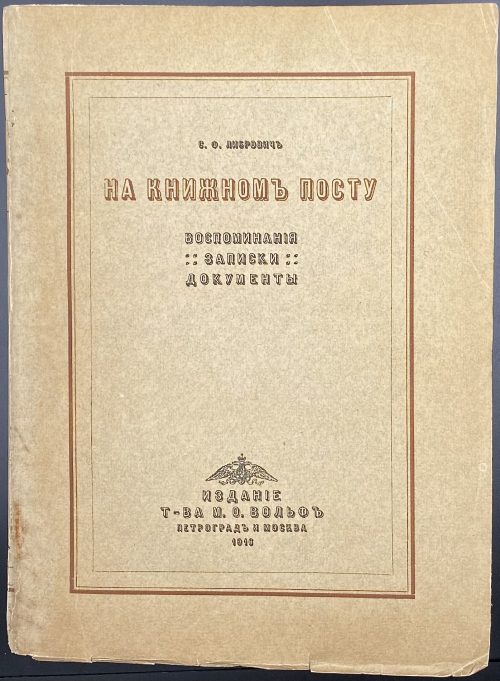 Softcover volume, 24.0 x 17.7 cm, publisher’s tan wrappers, lettered to front and spine in brown and black, publisher’s device and imprint to back, upper margin trimmed, all printed on laid paper, pp: [i-viii] [1-3] 4-496 [4], last page blank (total 508 pages); collated 8vo: π4 1-318 χ2 (total 254 leaves). Book-label with publisher’s device to fep (χ1 recto). Title-page and front wrapper (in brown and black): С. Ф. ЛИБРОВИЧЪ | НА КНИЖНОМЪ ПОСТУ | ВОСПОМИНАНIЯ | : : ЗАПИСКИ : : | ДОКУМЕНТЫ | {two-headed eagle} | ИЗДАНIЕ | Т-ВА М. О. ВОЛЬФЪ | ПЕТРОГРАДЪ И МОСКВА | (1916 on front wrapper) || Provenance: Publisher Contributors: Сигизмунд Феликсович Либрович [Zygmunt Librowicz] (Polish-Russian, 1855 – 1918) – author. Товарищество М. О. Вольф (Петроград-Москва) – publisher. Типография товарищества М. О. Вольф (Петроград) – printer. Маврикий Осипович Вольф [Maurycy Bolesław Wolff] (Polish-Russian, 1825 – 1883) – dedicatee.
Softcover volume, 24.0 x 17.7 cm, publisher’s tan wrappers, lettered to front and spine in brown and black, publisher’s device and imprint to back, upper margin trimmed, all printed on laid paper, pp: [i-viii] [1-3] 4-496 [4], last page blank (total 508 pages); collated 8vo: π4 1-318 χ2 (total 254 leaves). Book-label with publisher’s device to fep (χ1 recto). Title-page and front wrapper (in brown and black): С. Ф. ЛИБРОВИЧЪ | НА КНИЖНОМЪ ПОСТУ | ВОСПОМИНАНIЯ | : : ЗАПИСКИ : : | ДОКУМЕНТЫ | {two-headed eagle} | ИЗДАНIЕ | Т-ВА М. О. ВОЛЬФЪ | ПЕТРОГРАДЪ И МОСКВА | (1916 on front wrapper) || Provenance: Publisher Contributors: Сигизмунд Феликсович Либрович [Zygmunt Librowicz] (Polish-Russian, 1855 – 1918) – author. Товарищество М. О. Вольф (Петроград-Москва) – publisher. Типография товарищества М. О. Вольф (Петроград) – printer. Маврикий Осипович Вольф [Maurycy Bolesław Wolff] (Polish-Russian, 1825 – 1883) – dedicatee. -
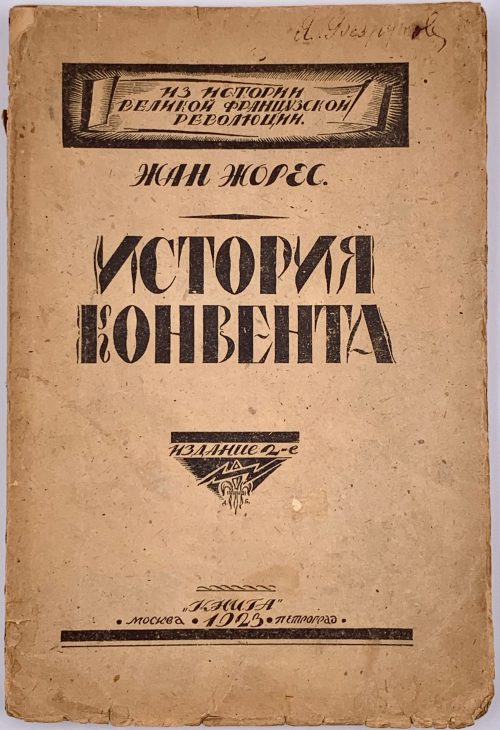 Cover: ИЗ ИСТОРИИ | ВЕЛИКОЙ ФРАНЦУЗСКОЙ | РЕВОЛЮЦИИ | ЖАН ЖОРЕС | ИСТОРИЯ КОНВЕНТА | ИЗДАНИЕ 2-е | “Книга” | • МОСКВА • 1923 • ПЕТРОГРАД • || Title page: Жан Жорес | История Конвента | Сокращенный перевод В. Левицкого | под редакцией Ф. Дана. | Второе издание. | {publisher’s device} | “Книга” | Москва. […] Петроград | Тверская, 38, тел. 2-64-61. […] Невский, 74, тел. 1-34-34. || Print run: 3,000 copies. Printer: 10-я типография МСНХ «Мосполиграф». Original Title: Histoire socialiste : 1789-1900. La convention nationale / par J. Jaurès. — Paris : Jules Rouff et Cie, 1901 Bibliographical description: 23.5 x 16 cm, publisher’s letterpress wrappers, pp. [1-3] 4-191 [192]; collation: 8vo, [1-2]8 3-128; ink inscription to front wrapper: Я. Безруков Jean Jaurès [Жан Жорес] (French, 1859 – 1914) Цедербаум, Владимир Осипович [Левицкий, В.] (Russian-Jewish, 1883 – 1938) Дан [Гурвич], Федор Ильич (Russian-Jewish, 1871-1947)
Cover: ИЗ ИСТОРИИ | ВЕЛИКОЙ ФРАНЦУЗСКОЙ | РЕВОЛЮЦИИ | ЖАН ЖОРЕС | ИСТОРИЯ КОНВЕНТА | ИЗДАНИЕ 2-е | “Книга” | • МОСКВА • 1923 • ПЕТРОГРАД • || Title page: Жан Жорес | История Конвента | Сокращенный перевод В. Левицкого | под редакцией Ф. Дана. | Второе издание. | {publisher’s device} | “Книга” | Москва. […] Петроград | Тверская, 38, тел. 2-64-61. […] Невский, 74, тел. 1-34-34. || Print run: 3,000 copies. Printer: 10-я типография МСНХ «Мосполиграф». Original Title: Histoire socialiste : 1789-1900. La convention nationale / par J. Jaurès. — Paris : Jules Rouff et Cie, 1901 Bibliographical description: 23.5 x 16 cm, publisher’s letterpress wrappers, pp. [1-3] 4-191 [192]; collation: 8vo, [1-2]8 3-128; ink inscription to front wrapper: Я. Безруков Jean Jaurès [Жан Жорес] (French, 1859 – 1914) Цедербаум, Владимир Осипович [Левицкий, В.] (Russian-Jewish, 1883 – 1938) Дан [Гурвич], Федор Ильич (Russian-Jewish, 1871-1947) -
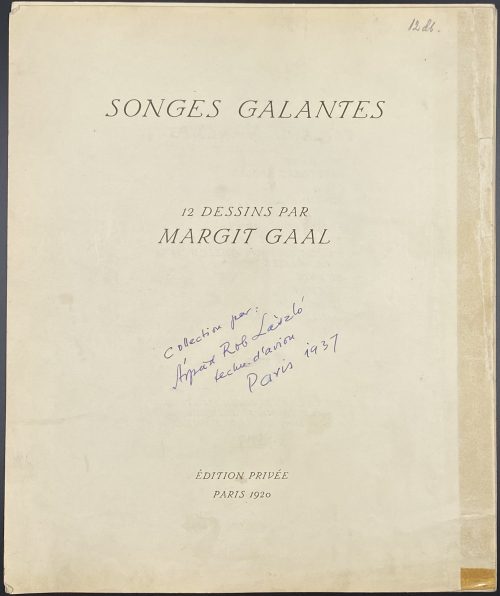 In an owner’s quarter buckram cardboard folder with a vegetation diaper design, ms blue ink lettering to front: “Songes galantes | 12 dessins par | Margit Gaal” at the centre, “Arpad Rob Laszlo | à Paris | 1938” in the lower right corner. Loose sheets with the 1st leaf t.p. / table de planches, and then 12 leaves of lithograph plates. Title-page: SONGES GALANTES | 12 DESSINS PAR | MARGIT GAAL | ÉDITION PRIVÉE | PARIS 1920 ||, ms inscription in blue ink in the middle : “Collection par | Árpad Rob Laśzló | techn. d’avion | Paris 1937”. Limitation: Edition limited to 500 copies of which № 1-100 signed by the author. This is copy № 407. References: Dutel (1920-1970) № 1413 (published in 1921); Honesterotica (indicated the year of death as 1965, however, there is no proof). Contributors: Gaál, Margit (Hungarian, 1898 – 1920) – artist.
In an owner’s quarter buckram cardboard folder with a vegetation diaper design, ms blue ink lettering to front: “Songes galantes | 12 dessins par | Margit Gaal” at the centre, “Arpad Rob Laszlo | à Paris | 1938” in the lower right corner. Loose sheets with the 1st leaf t.p. / table de planches, and then 12 leaves of lithograph plates. Title-page: SONGES GALANTES | 12 DESSINS PAR | MARGIT GAAL | ÉDITION PRIVÉE | PARIS 1920 ||, ms inscription in blue ink in the middle : “Collection par | Árpad Rob Laśzló | techn. d’avion | Paris 1937”. Limitation: Edition limited to 500 copies of which № 1-100 signed by the author. This is copy № 407. References: Dutel (1920-1970) № 1413 (published in 1921); Honesterotica (indicated the year of death as 1965, however, there is no proof). Contributors: Gaál, Margit (Hungarian, 1898 – 1920) – artist. -
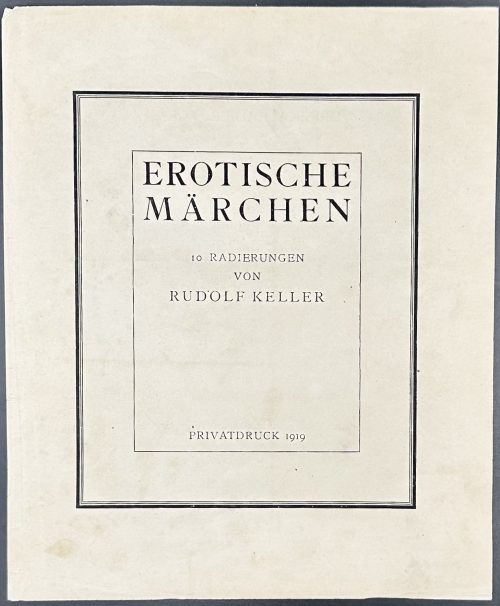 Portfolio 265 x 225 mm, black half-buckram over diapered cardboard with flaps, black with gilt lettering in frame to front “R. KELLER | MÄRCHEN”, t.p. printed on wave paper, the folder and engravings printed on laid paper, 10 loose plates, 240 x 210 mm sheet, 135 x 110-115 mm plate; re-issue of ten plates of the first edition of 16 plates published in Austria in c. 1910s. Title-page: EROTISCHE | MÄRCHEN | 10 RADIERUNGEN | VON | RUDOLF KELLER | PRIVATDRUCK 1919 || Die Mappe enthält folgende originalradierungen: 1. Aschenbrödel; 2. Dornröschen; 3. Zwerg Nase; 4. Froschkönig; 5. Der gestiefelte Kater; 6. Hänsel und Gretel; 7. Der fliegende Koffer; 8. Schneewittchen mit den 7 Zwergen; 9. Die kleine Seejungfer; 10. Der kleine Daumling Dieses Werk wurde in einer einmaligen Auflage von 250 numerierten Exemplaren hergestellt und darf nur an Gelehrte und Sammler abgegeben werden. Die Platten wurden vernichtet. Nr. 1—50 sind vom Künstler signierte Vorzugsdrucke. Dieses Exemplar erhielt Nr. 0153. Translation: The folder contains the following original etchings: 1. Cinderella; 2. Sleeping Beauty; 3. Dwarf nose; 4. The Frog Prince; 5. Puss in Boots; 6. Hansel and Gretel; 7. The Flying Trunk; 8. Snow White with the Seven Dwarfs; 9. The Little Mermaid; 10. Little Thumbling. This work was produced in a one-time edition of 250 numbered copies and may only be sold to scholars and collectors. The copperplates were destroyed. Nos. 1-50 are special prints signed by the artist. This copy was given number 0153. Seller's description: Erotische Märchen. S.l., Privatdruck, 1919. In-8, en feuilles, sous chemise demi-chagrin vert recouverte de papier japonais. Recueil de 10 eaux-fortes originales de Rudolf Keller. Ces eaux-fortes érotiques dans les teintes brunes s'inspirent des contes de fées traditionnels comme Cendrillon, La Belle au bois dormant, Hansel et Gretel, Blanche-Neige, Le Petit Poucet etc. Tirage à 250 exemplaires. Chemise défraîchie. Jacob Grimm (German; 1785 – 1863) Wilhelm Grimm (German, 1786 – 1859) Charles Perrault (French, 1628 – 1703) Hans Christian Andersen (Danish, 1805 – 1875)
Portfolio 265 x 225 mm, black half-buckram over diapered cardboard with flaps, black with gilt lettering in frame to front “R. KELLER | MÄRCHEN”, t.p. printed on wave paper, the folder and engravings printed on laid paper, 10 loose plates, 240 x 210 mm sheet, 135 x 110-115 mm plate; re-issue of ten plates of the first edition of 16 plates published in Austria in c. 1910s. Title-page: EROTISCHE | MÄRCHEN | 10 RADIERUNGEN | VON | RUDOLF KELLER | PRIVATDRUCK 1919 || Die Mappe enthält folgende originalradierungen: 1. Aschenbrödel; 2. Dornröschen; 3. Zwerg Nase; 4. Froschkönig; 5. Der gestiefelte Kater; 6. Hänsel und Gretel; 7. Der fliegende Koffer; 8. Schneewittchen mit den 7 Zwergen; 9. Die kleine Seejungfer; 10. Der kleine Daumling Dieses Werk wurde in einer einmaligen Auflage von 250 numerierten Exemplaren hergestellt und darf nur an Gelehrte und Sammler abgegeben werden. Die Platten wurden vernichtet. Nr. 1—50 sind vom Künstler signierte Vorzugsdrucke. Dieses Exemplar erhielt Nr. 0153. Translation: The folder contains the following original etchings: 1. Cinderella; 2. Sleeping Beauty; 3. Dwarf nose; 4. The Frog Prince; 5. Puss in Boots; 6. Hansel and Gretel; 7. The Flying Trunk; 8. Snow White with the Seven Dwarfs; 9. The Little Mermaid; 10. Little Thumbling. This work was produced in a one-time edition of 250 numbered copies and may only be sold to scholars and collectors. The copperplates were destroyed. Nos. 1-50 are special prints signed by the artist. This copy was given number 0153. Seller's description: Erotische Märchen. S.l., Privatdruck, 1919. In-8, en feuilles, sous chemise demi-chagrin vert recouverte de papier japonais. Recueil de 10 eaux-fortes originales de Rudolf Keller. Ces eaux-fortes érotiques dans les teintes brunes s'inspirent des contes de fées traditionnels comme Cendrillon, La Belle au bois dormant, Hansel et Gretel, Blanche-Neige, Le Petit Poucet etc. Tirage à 250 exemplaires. Chemise défraîchie. Jacob Grimm (German; 1785 – 1863) Wilhelm Grimm (German, 1786 – 1859) Charles Perrault (French, 1628 – 1703) Hans Christian Andersen (Danish, 1805 – 1875) -
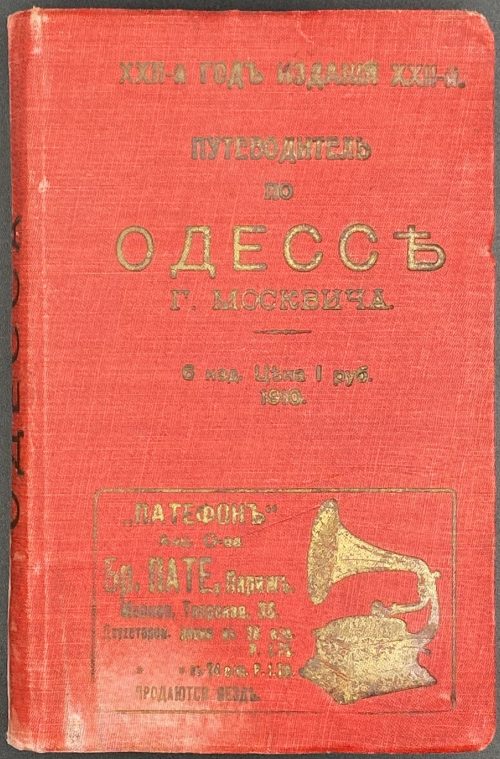 Title: Издательство Путеводителей "Русскiй Бедекеръ" сущ. съ 1888 г. | Григорiй Москвичъ. | ИЛЛЮСТРИРОВАННЫЙ | Практический Путеводитель | по Одессѣ | с приложенiемъ: | очерка одесской выставки, плана Одессы, исполненнаго | в краскахъ, плановъ — порта, Куяльницкаго лимана, | расписанiя рейсовъ пароходовъ и тарифовъ, алфавита | и проч. | ИЗДАНИIЕ ШЕСТОЕ. | Цѣна 1 руб. (в переплетѣ) | ПРОДАЕТСЯ | во всѣх лучшихъ книжныхъ магазинахъ столицъ | и провинцiи. | ОДЕССА. | Типографiя и стереотипия И. Копельмана, Пушк. 34. | 1910. || Binding: Red cloth with gilt lettering to the front board: XXII-й ГОДЪ ИЗДАНIЯ XXII-й | ПУТЕВОДИТЕЛЬ | ПО | ОДЕССѢ | Г. МОСКВИЧА. | 6 изд. Цѣна 1 руб. | 1910. [Pictorial advert.], to the back board: Text. advert. in gilt; to spine: ОДЕССА. Pink end-papers with advertisement. Pagination: [i-ii - t.p. /advert.] [iii]-iv - preface to 6th edition; [v]-viii - content; [ix]-xvi - index; 11 leaves advert., unpag; [i]-xii - Odessa exhibition; [1] 2-240; [1] 2-8 - schedules; photo plates, 2 folding maps; in-16mo (numerical). Size: 16.5 x 10.5 cm.
Title: Издательство Путеводителей "Русскiй Бедекеръ" сущ. съ 1888 г. | Григорiй Москвичъ. | ИЛЛЮСТРИРОВАННЫЙ | Практический Путеводитель | по Одессѣ | с приложенiемъ: | очерка одесской выставки, плана Одессы, исполненнаго | в краскахъ, плановъ — порта, Куяльницкаго лимана, | расписанiя рейсовъ пароходовъ и тарифовъ, алфавита | и проч. | ИЗДАНИIЕ ШЕСТОЕ. | Цѣна 1 руб. (в переплетѣ) | ПРОДАЕТСЯ | во всѣх лучшихъ книжныхъ магазинахъ столицъ | и провинцiи. | ОДЕССА. | Типографiя и стереотипия И. Копельмана, Пушк. 34. | 1910. || Binding: Red cloth with gilt lettering to the front board: XXII-й ГОДЪ ИЗДАНIЯ XXII-й | ПУТЕВОДИТЕЛЬ | ПО | ОДЕССѢ | Г. МОСКВИЧА. | 6 изд. Цѣна 1 руб. | 1910. [Pictorial advert.], to the back board: Text. advert. in gilt; to spine: ОДЕССА. Pink end-papers with advertisement. Pagination: [i-ii - t.p. /advert.] [iii]-iv - preface to 6th edition; [v]-viii - content; [ix]-xvi - index; 11 leaves advert., unpag; [i]-xii - Odessa exhibition; [1] 2-240; [1] 2-8 - schedules; photo plates, 2 folding maps; in-16mo (numerical). Size: 16.5 x 10.5 cm. -
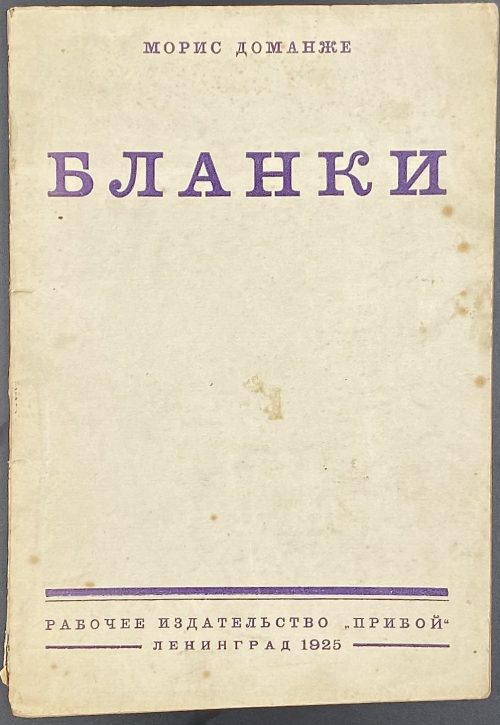 Cover: МОРИС ДОМАНЖЕ | БЛАНКИ | РАБОЧЕЕ ИЗДАТЕЛЬСТВО “ПРИБОЙ” | ЛЕНИНГРАД 1925 || Title page: МОРИС ДОМАНЖЕ | БЛАНКИ | Пер. с французского | Рабочее Издательство “ПРИБОЙ” | Ленинград 1925 || Pagination: [2] 3-97 [3]. Collation: 8vo; [1]8 2-68 [7]2, total 50 leaves. Binding: Publisher’s wrappers, lettering to covers and spine, uncut. Contributor: Maurice Dommanget (French, 1888 – 1976) – author. Translation of: Blanqui par Maurice Dommanget. — Paris: Librairie de l'Humanité, 1924.
Cover: МОРИС ДОМАНЖЕ | БЛАНКИ | РАБОЧЕЕ ИЗДАТЕЛЬСТВО “ПРИБОЙ” | ЛЕНИНГРАД 1925 || Title page: МОРИС ДОМАНЖЕ | БЛАНКИ | Пер. с французского | Рабочее Издательство “ПРИБОЙ” | Ленинград 1925 || Pagination: [2] 3-97 [3]. Collation: 8vo; [1]8 2-68 [7]2, total 50 leaves. Binding: Publisher’s wrappers, lettering to covers and spine, uncut. Contributor: Maurice Dommanget (French, 1888 – 1976) – author. Translation of: Blanqui par Maurice Dommanget. — Paris: Librairie de l'Humanité, 1924. -
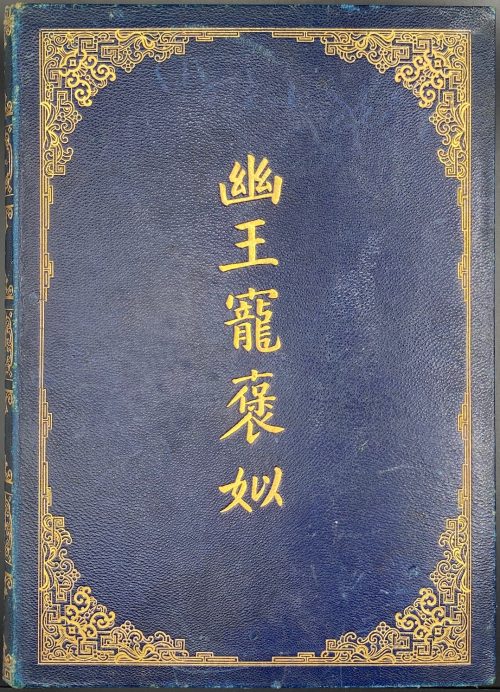 Description: Hardcover, in-folio, 32 x 23.5 cm, bound in dark blue morocco, boards and spine richly decorated in gilt, front cover gilt-lettered in Chinese [幽王寵褒姒], pictorial endpapers, laid paper with unicorn watermark, margins uncut, printing performed by Joh. Enschedé (Haarlem), pp. [10] 1-210 [6], total 226 pages, collated π5 1-532 χ2, first and last leaves blank, total 113 leaves plus 7 plates after Franz von Bayros, some signed; adorned with woodcut borders, frames, head- and tailpieces throughout. The binding work was done by Hübel und Denck (Leipzig) based on designs by Paul Renner. Title-page: DAS | SCHÖNE | MÄDCHEN | VON PAO | — | EIN CHINESISCHER | ROMAN VON | OTTO JULIUS BIERBAUM | — | PRACHTAUSGABE | MIT BILDERN VON BAYROS | — | Bei Joh. Enschedé en Zonen in | Haarlem gedruckt für Georg | Müllers Verlag in München || Catalogue raisonné: The amorous drawings of the Marquis von Bayros. — New York: Cythera Press, 1968. The Beautiful Maiden of Pao, pp. 153-8. Contributors: Otto Julius Bierbaum (German, 1865 – 1910) – author. Franz von Bayros (Austrian, 1866 – 1924) – artist. Johannes Enschedé (Dutch, 1708 – 1780) – printer. Joh. Enschedé (Haarlem) – printer. Hübel und Denck (Leipzig) – bookbinder. Paul Friedrich August Renner (German, 1878 – 1956) – designer.
Description: Hardcover, in-folio, 32 x 23.5 cm, bound in dark blue morocco, boards and spine richly decorated in gilt, front cover gilt-lettered in Chinese [幽王寵褒姒], pictorial endpapers, laid paper with unicorn watermark, margins uncut, printing performed by Joh. Enschedé (Haarlem), pp. [10] 1-210 [6], total 226 pages, collated π5 1-532 χ2, first and last leaves blank, total 113 leaves plus 7 plates after Franz von Bayros, some signed; adorned with woodcut borders, frames, head- and tailpieces throughout. The binding work was done by Hübel und Denck (Leipzig) based on designs by Paul Renner. Title-page: DAS | SCHÖNE | MÄDCHEN | VON PAO | — | EIN CHINESISCHER | ROMAN VON | OTTO JULIUS BIERBAUM | — | PRACHTAUSGABE | MIT BILDERN VON BAYROS | — | Bei Joh. Enschedé en Zonen in | Haarlem gedruckt für Georg | Müllers Verlag in München || Catalogue raisonné: The amorous drawings of the Marquis von Bayros. — New York: Cythera Press, 1968. The Beautiful Maiden of Pao, pp. 153-8. Contributors: Otto Julius Bierbaum (German, 1865 – 1910) – author. Franz von Bayros (Austrian, 1866 – 1924) – artist. Johannes Enschedé (Dutch, 1708 – 1780) – printer. Joh. Enschedé (Haarlem) – printer. Hübel und Denck (Leipzig) – bookbinder. Paul Friedrich August Renner (German, 1878 – 1956) – designer. -
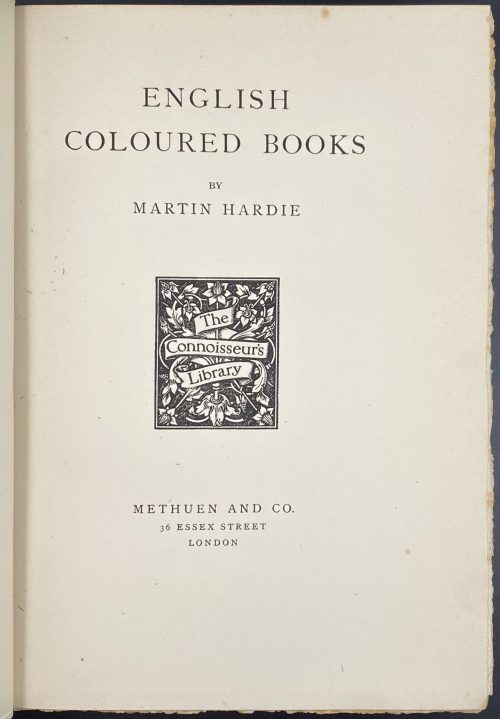 Half-title: THE CONNOISSEURS LIBRARY | GENERAL EDITOR : CYRIL DAVENPORT | […] | ENGLISH COLOURED BOOKS || Title: ENGLISH | COLOURED BOOKS | BY | MARTIN HARDIE | [device: THE CONNOISSEURS LIBRARY] | METHUEN AND CO. | 36 ESSEX STREET | LONDON || Dedication: TO MY WIFE | LOVE’S LABOUR : LOVE’S GIFT Pagination: ffl [i, ii] – h.t. / blank, [2] – blank / frontis. In colour, [iii, iv] – t.p. / First Published in 1906, [v, vi] – dedication / blank, vii-xxiv; 1-339 [340] bfl; 27 sheets of plates, colour and b/w. Collation: 8vo; a8 b4 A-X8 Y2. Binding: Hardcover, 26.3 x 19 x 5.7 cm; red cloth, blind-stamped with repeated fleuron, gilt floral designs and lettering in the frame to front cover, elaborate gilt floral design and lettering to spine; top margin gilt, other untrimmed, some pages uncut; plates w/guards. Printed on laid paper. Printed in Scotland by T. and A. Constable, at the Edinburgh university press. Contributors: Martin Hardie (British, 1875 – 1952) – Author Cyril Davenport (British, 1848 – 1941) – Editor of the series Sir Algernon Methuen (British, 1856 – 1924) – Publisher Thomas Constable (British, 1812 – 1881); Archibald Constable (British, 1774 – 1827) – Founders of the Publishing House "T. and A. Constable".
Half-title: THE CONNOISSEURS LIBRARY | GENERAL EDITOR : CYRIL DAVENPORT | […] | ENGLISH COLOURED BOOKS || Title: ENGLISH | COLOURED BOOKS | BY | MARTIN HARDIE | [device: THE CONNOISSEURS LIBRARY] | METHUEN AND CO. | 36 ESSEX STREET | LONDON || Dedication: TO MY WIFE | LOVE’S LABOUR : LOVE’S GIFT Pagination: ffl [i, ii] – h.t. / blank, [2] – blank / frontis. In colour, [iii, iv] – t.p. / First Published in 1906, [v, vi] – dedication / blank, vii-xxiv; 1-339 [340] bfl; 27 sheets of plates, colour and b/w. Collation: 8vo; a8 b4 A-X8 Y2. Binding: Hardcover, 26.3 x 19 x 5.7 cm; red cloth, blind-stamped with repeated fleuron, gilt floral designs and lettering in the frame to front cover, elaborate gilt floral design and lettering to spine; top margin gilt, other untrimmed, some pages uncut; plates w/guards. Printed on laid paper. Printed in Scotland by T. and A. Constable, at the Edinburgh university press. Contributors: Martin Hardie (British, 1875 – 1952) – Author Cyril Davenport (British, 1848 – 1941) – Editor of the series Sir Algernon Methuen (British, 1856 – 1924) – Publisher Thomas Constable (British, 1812 – 1881); Archibald Constable (British, 1774 – 1827) – Founders of the Publishing House "T. and A. Constable". -
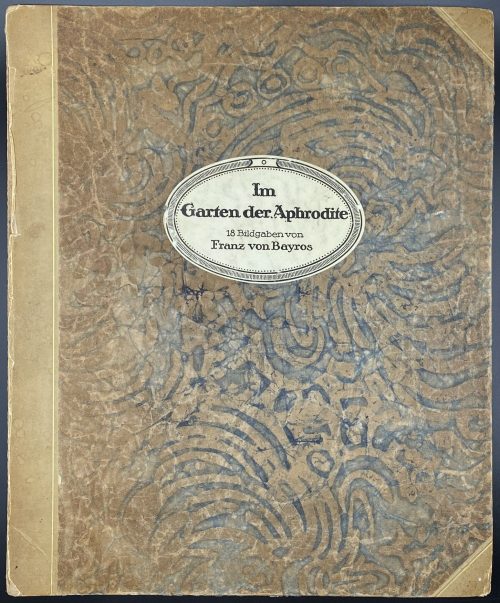 Cover with title: Im Garten der Aphrodite | 18 Bildgaben | von | Franz von Bayros | {vignette} | Privatdruck || in a frame; table of contents and limitation to verso; 18 plates with the drawings of Bayros in collotype reproduction, each mounted on cardboard and protected with the remnants of tissue guards, some lacking. Of the publisher’s folder, only the front board with an oval title label is present. Some images signed “Choisy le Conin” – von Bayros’s pseudonym. Two prints are missing: (1) Das Füßchen and (2) Die Liebesschaukel, the other 16 prints present. The vignette on the cover is a photomechanical reproduction. Edition: limited to 350 copies of which this is № 253. According to Christie’s: a collotype reprint, about twenty years after their first publication. English equivalent: The Garden of Aphrodite. Portfolio with 18 photogravures. Catalogue raisonné: The amorous drawings of the Marquis von Bayros (1968): pp. 177-1877; Bayros Zeichningen (1987): pp. 143-152.
Cover with title: Im Garten der Aphrodite | 18 Bildgaben | von | Franz von Bayros | {vignette} | Privatdruck || in a frame; table of contents and limitation to verso; 18 plates with the drawings of Bayros in collotype reproduction, each mounted on cardboard and protected with the remnants of tissue guards, some lacking. Of the publisher’s folder, only the front board with an oval title label is present. Some images signed “Choisy le Conin” – von Bayros’s pseudonym. Two prints are missing: (1) Das Füßchen and (2) Die Liebesschaukel, the other 16 prints present. The vignette on the cover is a photomechanical reproduction. Edition: limited to 350 copies of which this is № 253. According to Christie’s: a collotype reprint, about twenty years after their first publication. English equivalent: The Garden of Aphrodite. Portfolio with 18 photogravures. Catalogue raisonné: The amorous drawings of the Marquis von Bayros (1968): pp. 177-1877; Bayros Zeichningen (1987): pp. 143-152. -
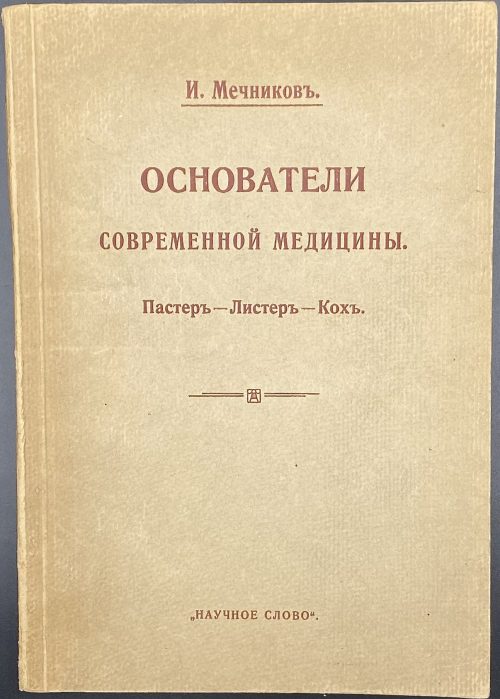 Paperback, 22.3 x 15.5 cm, publisher’s tan wrappers, brown lettering to front and spine, imprint and price to back, pp.: [1-3] 4-136 [2] blank/advert.; collated 8vo: [1]-88, 94 χ1, total 69 leaves plus 6 photomechanical plates, incl. frontispiece, four of them portraits. Title-page: И. Мечниковъ | ОСНОВАТЕЛИ | СОВРЕМЕННОЙ МЕДИЦИНЫ. | Пастеръ. — Листеръ. — Кохъ. | — | Изданiе | “НАУЧНАГО СЛОВА”. | Москва — 1915. Contributors and Characters: Илья Ильич Мечников [Élie Metchnikoff] (Russian, 1845 – 1916) – author. "Научное слово" – publisher. Типо-литография Товарищества И. Н. Кушнерев и Ко. — printer. Louis Pasteur (French, 1822 – 1895) – character. Joseph Lister (British, 1827 – 1912) – character. Robert Koch (German, 1843 – 1910) – character.
Paperback, 22.3 x 15.5 cm, publisher’s tan wrappers, brown lettering to front and spine, imprint and price to back, pp.: [1-3] 4-136 [2] blank/advert.; collated 8vo: [1]-88, 94 χ1, total 69 leaves plus 6 photomechanical plates, incl. frontispiece, four of them portraits. Title-page: И. Мечниковъ | ОСНОВАТЕЛИ | СОВРЕМЕННОЙ МЕДИЦИНЫ. | Пастеръ. — Листеръ. — Кохъ. | — | Изданiе | “НАУЧНАГО СЛОВА”. | Москва — 1915. Contributors and Characters: Илья Ильич Мечников [Élie Metchnikoff] (Russian, 1845 – 1916) – author. "Научное слово" – publisher. Типо-литография Товарищества И. Н. Кушнерев и Ко. — printer. Louis Pasteur (French, 1822 – 1895) – character. Joseph Lister (British, 1827 – 1912) – character. Robert Koch (German, 1843 – 1910) – character. -
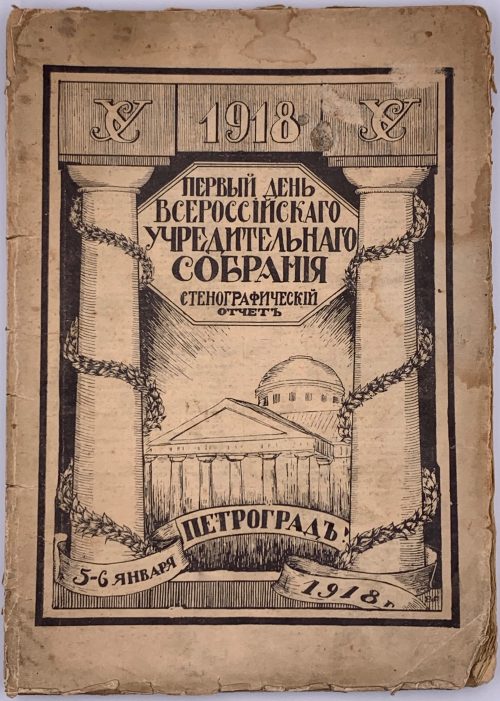 Cover: УС 1918 УС | ПЕРВЫЙ ДЕНЬ | ВСЕРОССIЙСКАГО | УЧРЕДИТЕЛЬНАГО | СОБРАНIЯ | СТЕНОГРАФИЧЕСКIЙ | ОТЧЕТЪ | 5-6 ЯНВАРЯ […] ПЕТРОГРАДЪ […] 1918 г. Title page: УЧРЕДИТЕЛЬНОЕ | СОБРАНIЕ | СТЕНОГРАФИЧЕСКIЙ ОТЧЕТЪ | ПЕЧАТАЕТСЯ ПО РАСПОРЯЖЕНIЮ ПРЕДСѢДАТЕЛЯ | УЧРЕДИТЕЛЬНАГО СОБРАНIЯ. | ПЕТРОГРАДЪ | Пятая Государственная типография, Стремянная, 12. | 1918. || Pencil inscription to t.p.: "Москва 1923 г. С. Варшавский". 23 x 16.5 cm, publisher’s pictorial wrappers, woodcut to front cover, pp.: [1-3] 4-112; collation: [1]8 2-78.
Cover: УС 1918 УС | ПЕРВЫЙ ДЕНЬ | ВСЕРОССIЙСКАГО | УЧРЕДИТЕЛЬНАГО | СОБРАНIЯ | СТЕНОГРАФИЧЕСКIЙ | ОТЧЕТЪ | 5-6 ЯНВАРЯ […] ПЕТРОГРАДЪ […] 1918 г. Title page: УЧРЕДИТЕЛЬНОЕ | СОБРАНIЕ | СТЕНОГРАФИЧЕСКIЙ ОТЧЕТЪ | ПЕЧАТАЕТСЯ ПО РАСПОРЯЖЕНIЮ ПРЕДСѢДАТЕЛЯ | УЧРЕДИТЕЛЬНАГО СОБРАНIЯ. | ПЕТРОГРАДЪ | Пятая Государственная типография, Стремянная, 12. | 1918. || Pencil inscription to t.p.: "Москва 1923 г. С. Варшавский". 23 x 16.5 cm, publisher’s pictorial wrappers, woodcut to front cover, pp.: [1-3] 4-112; collation: [1]8 2-78. -
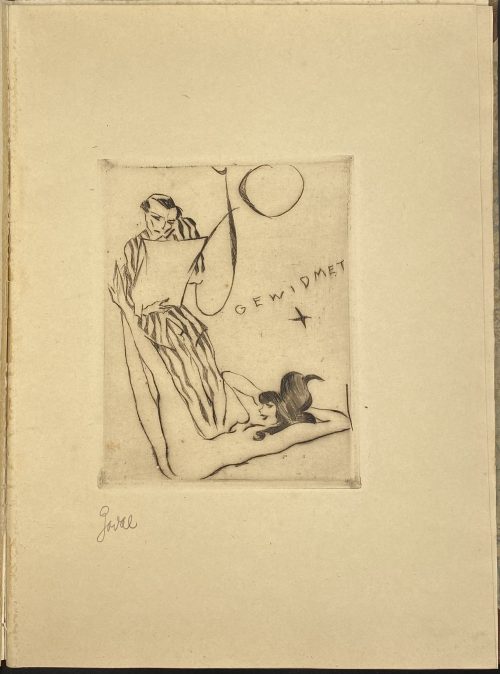 Half calf binding 33.5 x 25 cm, gilt lettering within rules “GODAL | JO”, engraved title-page and 9 etchings printed in sepia on sheets 32.5 x 24 cm of thick wove paper, pencil signed, presumably, by the artist; a newspaper clipping tipped-in. The number of copies is unknown. Ticket to front pastedown: "Haeusgen |8 München 90 | Reinekestrasse 36" According to seller: “Extraordinarily rare series of erotic original etchings. - Cf. Bilderlexikon II, 451 u. Vollmer II, 261 - According to KVK not in any library”. Contributors: Erich Godal [Erich Goldbaum] (German-Jewish, 1899 – 1969) – artist.
Half calf binding 33.5 x 25 cm, gilt lettering within rules “GODAL | JO”, engraved title-page and 9 etchings printed in sepia on sheets 32.5 x 24 cm of thick wove paper, pencil signed, presumably, by the artist; a newspaper clipping tipped-in. The number of copies is unknown. Ticket to front pastedown: "Haeusgen |8 München 90 | Reinekestrasse 36" According to seller: “Extraordinarily rare series of erotic original etchings. - Cf. Bilderlexikon II, 451 u. Vollmer II, 261 - According to KVK not in any library”. Contributors: Erich Godal [Erich Goldbaum] (German-Jewish, 1899 – 1969) – artist. -
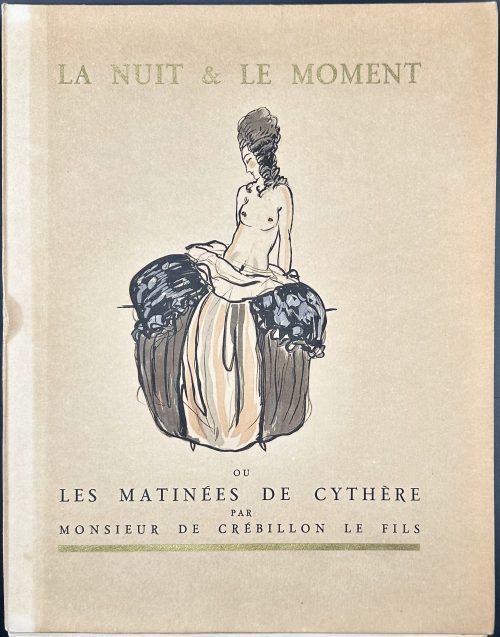 Softcover volume, 33 x 26 cm, collated in folio, not bound, in publisher’s French flapped pictorial wrappers, lettering to spine; printed on thick wove Arches paper watermarked “MBM”, upper edge trimmed, owner’s blind stamp to h.t. “Ex Libris Comte Tony de Vibraye”, glassine dust jacket, in a slipcase. Collation: π2 1-262, total 54 leaves, plus 4 leaves in wrappers, plus 10 plates, incl. frontispiece; coloured aquatints after Sylvain Sauvage; coloured etched vignette to front wrapper, gilt woodcut to back wrapper, woodcut title-page and woodcut headpiece after the same. Pp.: [4] [1] 2-102 [2]. Front wrapper (gilt and black): LA NUIT & LE MOMENT | {vignette} | OU | LES MATINÉES DE CYTHÈRE | PAR | MONSIEUR DE CRÉBILLON LE FILS | — || Title-page (woodcut): CRÉBILLON LE FILS | — | LA NUIT ET LE MOMENT | OU | LES MATINÉES | DE CYTHÈRE | {vignette} | A PARIS | AUX DEPENS D'UN AMATEUR | — | M CM XXIV || Limitation: De cette édition il a été tiré un exemplaire unique sur japon impérial comportant dix aquarelles originales, deux cents trente exemplaires sur vélin d' Arches numérotés 1 à 230, dont les dix premiers avec une suite de hors texte sur japon. N° 1 [Print run limited to 230 copies on Arches plus a unique copy on Japon with original watercolours, this is copy № 1 on wove paper]. Seller’s description: La Nuit et le moment ou Les Matinées de Cythère. Paris, Au dépens d'un amateur, 1924. In-4, en feuilles, non rogné, couverture illustrée et étui. Ouvrage illustré de 4 gravures sur bois et de 10 eaux-fortes libres en couleurs hors texte de Sylvain Sauvage. Tirage à 231 exemplaires, celui-ci le n°1 sur vélin d'Arches. Manque la suite de hors texte sur japon. De la bibliothèque du Comte Tony de Vibraye, avec cachet à froid. Dutel, n°2062. Catalogue raisonné: honesterotica.com; Dutel III 2062. Contributors: Claude-Prosper Jolyot de Crébillon [Crébillon fils] (French, 1707 – 1777) – author. Sylvain Sauvage [Félix Roy] (French, 1888 – 1948) – artist. Provenance: Antoine Henri Gaston Hurault de Vibraye [Comte Tony de Vibraye] (French, 1893 – 1951)
Softcover volume, 33 x 26 cm, collated in folio, not bound, in publisher’s French flapped pictorial wrappers, lettering to spine; printed on thick wove Arches paper watermarked “MBM”, upper edge trimmed, owner’s blind stamp to h.t. “Ex Libris Comte Tony de Vibraye”, glassine dust jacket, in a slipcase. Collation: π2 1-262, total 54 leaves, plus 4 leaves in wrappers, plus 10 plates, incl. frontispiece; coloured aquatints after Sylvain Sauvage; coloured etched vignette to front wrapper, gilt woodcut to back wrapper, woodcut title-page and woodcut headpiece after the same. Pp.: [4] [1] 2-102 [2]. Front wrapper (gilt and black): LA NUIT & LE MOMENT | {vignette} | OU | LES MATINÉES DE CYTHÈRE | PAR | MONSIEUR DE CRÉBILLON LE FILS | — || Title-page (woodcut): CRÉBILLON LE FILS | — | LA NUIT ET LE MOMENT | OU | LES MATINÉES | DE CYTHÈRE | {vignette} | A PARIS | AUX DEPENS D'UN AMATEUR | — | M CM XXIV || Limitation: De cette édition il a été tiré un exemplaire unique sur japon impérial comportant dix aquarelles originales, deux cents trente exemplaires sur vélin d' Arches numérotés 1 à 230, dont les dix premiers avec une suite de hors texte sur japon. N° 1 [Print run limited to 230 copies on Arches plus a unique copy on Japon with original watercolours, this is copy № 1 on wove paper]. Seller’s description: La Nuit et le moment ou Les Matinées de Cythère. Paris, Au dépens d'un amateur, 1924. In-4, en feuilles, non rogné, couverture illustrée et étui. Ouvrage illustré de 4 gravures sur bois et de 10 eaux-fortes libres en couleurs hors texte de Sylvain Sauvage. Tirage à 231 exemplaires, celui-ci le n°1 sur vélin d'Arches. Manque la suite de hors texte sur japon. De la bibliothèque du Comte Tony de Vibraye, avec cachet à froid. Dutel, n°2062. Catalogue raisonné: honesterotica.com; Dutel III 2062. Contributors: Claude-Prosper Jolyot de Crébillon [Crébillon fils] (French, 1707 – 1777) – author. Sylvain Sauvage [Félix Roy] (French, 1888 – 1948) – artist. Provenance: Antoine Henri Gaston Hurault de Vibraye [Comte Tony de Vibraye] (French, 1893 – 1951) -
![Э. Лиссагарэ. История Парижской Коммуны в 1871 году / С французского. Полный перевод под редакцией В. Базарова. — С.-Петербург. 1906. (Дешевая библиотека товарищества "Знание", № 274). — pp.:[4] [1] 2-524. [Проспер Оливье Лиссагарэ].](https://varshavskycollection.com/wp-content/uploads/2021/02/LIB-1158.2016-d-500x729.jpeg) Hardcover volume, collated in-8o, 21.1 x 14.9 cm, bound in half black polished morocco over green buckram boards, gilt lettering in rules to flat spine, brown diaper over cream endpapers, red ink oval library stamp in Estonian to t.p. «AJALOOMUUSEUM RAAMATUKOGU» (history museum library); pp.: [4] [1] 2-524, total 528 pages; collation π2 1-328 336, total 264 leaves. Title-page: ДЕШЕВАЯ БИБЛIОТЕКА ТОВАРИЩЕСТВА "ЗНАНIЕ". | № 274. | Э. Лиссагарэ. | ИСТОРIЯ ПАРИЖСКОЙ КОММУНЫ | въ 1871 г. | Съ французскаго. Полный переводъ | подъ редакцiей В. Базарова.| С.-ПЕТЕРБУРГЪ | 1906. || Original title: Prosper-Olivier Lissagaray. Histoire de la Commune de 1871. — Paris: E. Dentu, 1876. English translation by Eleanor Marx Aveling: [LIB-1110.2016] Prosper-Olivier Lissagaray. History of the Commune of 1871. — London: Reeves and Turner, 1886. Contributors: Hippolyte Prosper-Olivier Lissagaray (French, 1838 – 1901) – author. Владимир Александрович Базаров [Руднев, Vladimir Bazarov] (Russian, 1874 – 1939) – translator.
Hardcover volume, collated in-8o, 21.1 x 14.9 cm, bound in half black polished morocco over green buckram boards, gilt lettering in rules to flat spine, brown diaper over cream endpapers, red ink oval library stamp in Estonian to t.p. «AJALOOMUUSEUM RAAMATUKOGU» (history museum library); pp.: [4] [1] 2-524, total 528 pages; collation π2 1-328 336, total 264 leaves. Title-page: ДЕШЕВАЯ БИБЛIОТЕКА ТОВАРИЩЕСТВА "ЗНАНIЕ". | № 274. | Э. Лиссагарэ. | ИСТОРIЯ ПАРИЖСКОЙ КОММУНЫ | въ 1871 г. | Съ французскаго. Полный переводъ | подъ редакцiей В. Базарова.| С.-ПЕТЕРБУРГЪ | 1906. || Original title: Prosper-Olivier Lissagaray. Histoire de la Commune de 1871. — Paris: E. Dentu, 1876. English translation by Eleanor Marx Aveling: [LIB-1110.2016] Prosper-Olivier Lissagaray. History of the Commune of 1871. — London: Reeves and Turner, 1886. Contributors: Hippolyte Prosper-Olivier Lissagaray (French, 1838 – 1901) – author. Владимир Александрович Базаров [Руднев, Vladimir Bazarov] (Russian, 1874 – 1939) – translator. -
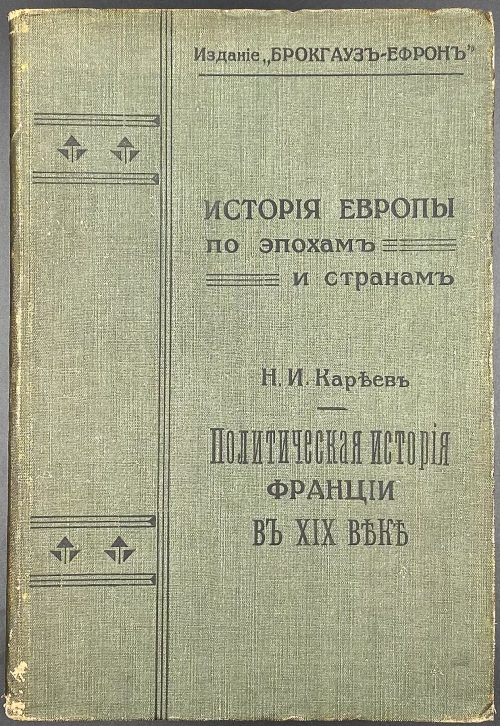 Cover: Изданiе "БРОКГАУЗЪ-ЕФРОНЪ" | ИСТОРIЯ ЕВРОПЫ | ПО ЭПОХАМЪ | И СТРАНАМЪ | Н. И. Карѣевъ | ПОЛИТИЧЕСКАЯ ИСТОРIЯ | ФРАНЦIИ | ВЪ XIX ВѢКѢ || Title page: Исторiя Европы по эпохамъ и странамъ в среднiе вѣка и новое время. | Изд. под. ред. Н. И. Карѣева и И. В. Лучицкаго. | Н. И. КАРѢЕВЪ | ПОЛИТИЧЕСКАЯ | ИСТОРIЯ ФРАНЦIИ | ВЪ XIX ВѢКѢ. | (Правительственныя формы и внутренняя политика, политическiя партiи | и общественные классы). | Изданiе Акц. Общ. "Брокгаузъ-Ефронъ". | С.-ПЕТЕРБУРГЪ. | Типографiя Акц. Общ. Брокгаузъ-Ефронъ. Прачешный пер. № 6. | 1902. || Pagination: [2] – title / blank, [i-iii] iv-v [vi], [1] 2-300 +1 colour plate (maps). Collation: 8vo; [π]4 1-188 196 + 1 leaf (maps). Binding: Publisher’s green cloth with black lettering to spine and cover, design elements to cover. Contributors: Кареев, Николай Иванович (Russian, 1850 – 1931) – author.
Cover: Изданiе "БРОКГАУЗЪ-ЕФРОНЪ" | ИСТОРIЯ ЕВРОПЫ | ПО ЭПОХАМЪ | И СТРАНАМЪ | Н. И. Карѣевъ | ПОЛИТИЧЕСКАЯ ИСТОРIЯ | ФРАНЦIИ | ВЪ XIX ВѢКѢ || Title page: Исторiя Европы по эпохамъ и странамъ в среднiе вѣка и новое время. | Изд. под. ред. Н. И. Карѣева и И. В. Лучицкаго. | Н. И. КАРѢЕВЪ | ПОЛИТИЧЕСКАЯ | ИСТОРIЯ ФРАНЦIИ | ВЪ XIX ВѢКѢ. | (Правительственныя формы и внутренняя политика, политическiя партiи | и общественные классы). | Изданiе Акц. Общ. "Брокгаузъ-Ефронъ". | С.-ПЕТЕРБУРГЪ. | Типографiя Акц. Общ. Брокгаузъ-Ефронъ. Прачешный пер. № 6. | 1902. || Pagination: [2] – title / blank, [i-iii] iv-v [vi], [1] 2-300 +1 colour plate (maps). Collation: 8vo; [π]4 1-188 196 + 1 leaf (maps). Binding: Publisher’s green cloth with black lettering to spine and cover, design elements to cover. Contributors: Кареев, Николай Иванович (Russian, 1850 – 1931) – author.


